
- Basic Kayaking Knowledge , Learn

30 Float Trip Food Ideas 2023
Whether you are using a kayak, canoe, raft, or tube to paddle down a river, the exercise is going to do a number on your appetite.
You need to have enough food on hand to sustain you throughout the duration of your floating trip.
However, planning float trip food can leave even the most experienced adventurers feeling confused and overwhelmed.
To help take some of the stress out of prepping for your next trip, I’ve put together some amazing food ideas that will surely hit the spot and help you replenish the energy you burn along the way.
1. Baked potatoes
2. turkey and cheese roll-ups, 3. beach burger with mango salsa, 4. sweet chilli shrimp kabobs, 5. one-pot pesto pasta, 6. breakfast sandwich, 7. sweet and savory oatmeal, 8. burrito wraps, 9. chilli and garlic bread, 10. grilled chicken tacos, 11. beans and vegetable soup, 12. thai red curry and rice, 13. spaghetti in clam sauce, 14. albacore tuna salad, 15. quick skillet beans with hot dogs, 16. lime butter grilled salmon and veggies, 17. cast iron brats with sauteed peppers and onions, 18. cowboy caviar with chips, 19. foil packet shrimp scampi, 20. sweet and spicy snack mix, 21. fish chowder, 22. chickpea breakfast hash, 23. grilled corn on the cob, 24. avocado toast with hard boiled egg, 25. shakshuka, 26. cheesy garlic fries, 27. red lentil sloppy joes, 28. mac and cheese, 29. panzanella salad with peaches and tomatoes, 30. chicken ramen, share on pinterest, float trip food ideas.
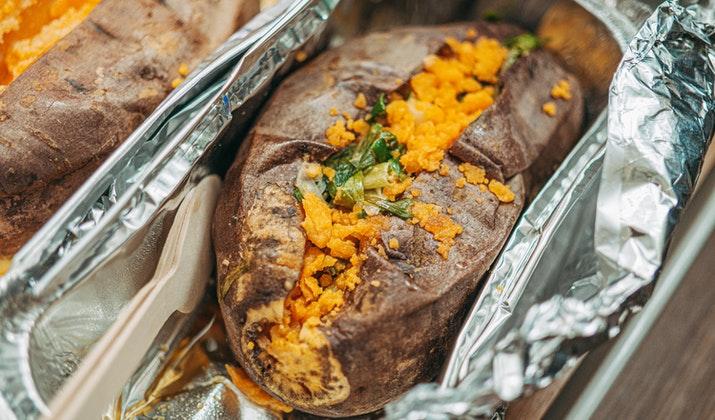
Source: Pexels
This is a great easy to make meal to take with you on your float trip. It packs well and doesn’t go rancid quickly, so you can save it for lunch or dinner after you have been out exploring the water for hours.
If you have space to pack an oven or you can make arrangements for one when you reach shore, you can take the raw ingredients and cook the meal fresh whenever you are ready to eat.
- Get the recipe
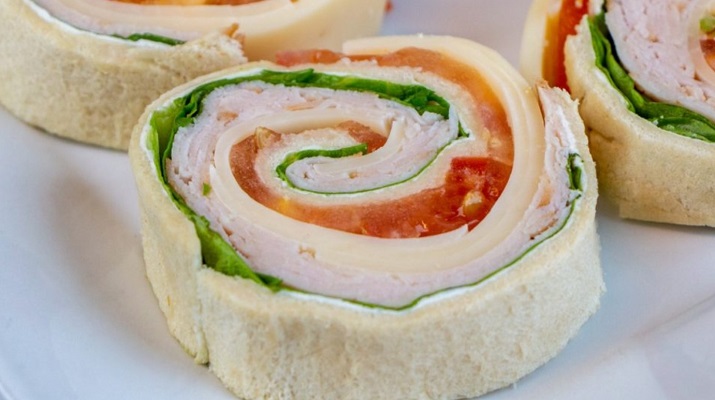
Source: PotatoRolls
The last thing you want when you are out on the water is to get too hungry that you lose focus because that’s a recipe for things to go awry. This bite-sized snack is the perfect stomach companion to keep you going until mealtime.
All it requires is some bread, turkey, lettuce, tomatoes, cheese slices, or cream cheese and you’re good to go. You can make this protein-packed snack ahead of time and just pop one into your might when the hunger pangs start to hit.
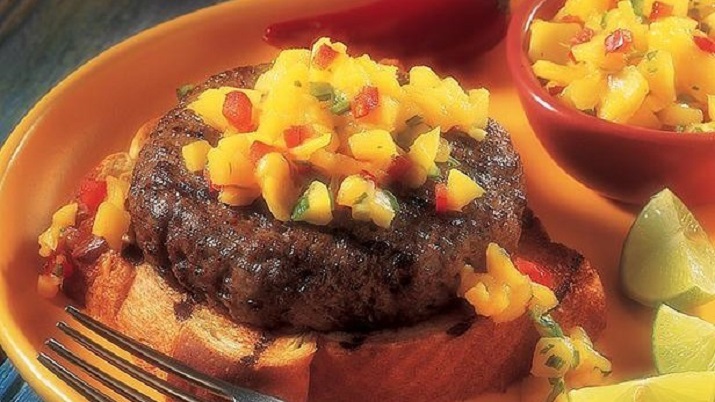
Source: Food Network
No matter what time of the day it is, you can never go wrong with this float trip food staple. It’s simple, achingly delicious, and so damn satisfying.
The great thing about burgers is that you can make them at home before heading out for your trip or wait till you set up your campsite, then place a grilling rack over hot coals and cook your beef patties.
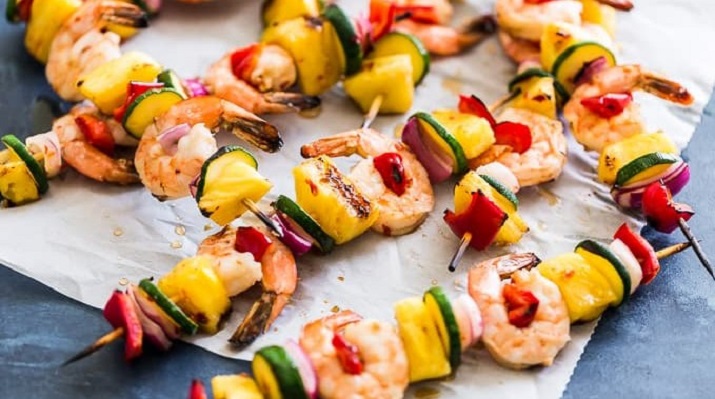
Source: Get Inspired Everyday
These spicy grilled skewers are what you need to bring an extra kick to your water adventures. They taste incredible and don’t require a lot of prep work so you’ll be dining and relaxing in minutes.
This meal can work as a simple appetizer or you can pair it with some rice and veggies and transform it into the main course.
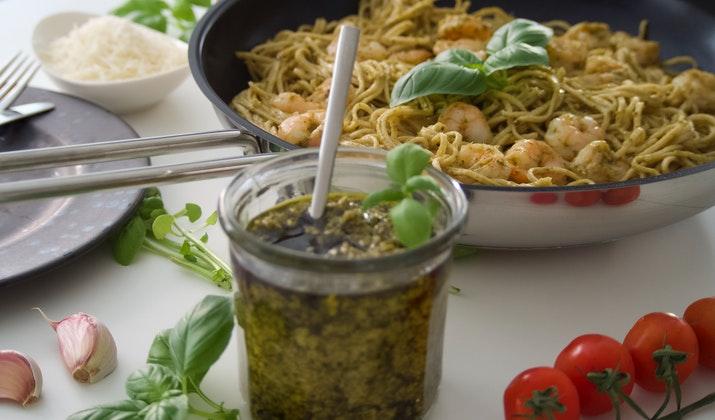
Whether you plan to be out on the water alone or you are making a group or family hang out of it, pesto pasta is one of the best float trip food ideas to keep you full, happy, and satisfied.
To save yourself some cooking time, make the pesto beforehand. You can even take things one step further by buying a jar of pesto.
This way, when mealtime comes around you only have to cook your pasta, add the pesto, toss it all together, and serve. Since it cooks in one pot or pan, cleaning up will be much easier to handle.
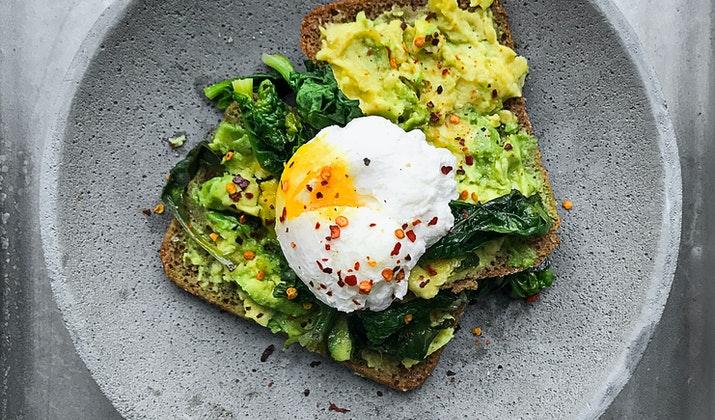
This float trip breakfast sandwich has everything you need to buoy your spirits before or after embarking on your on-the-water adventures for the day. You get the refreshing taste of avocados, tomatoes, bacon, and fried or scrambled eggs perfectly ladies out on toasted bread.
Making breakfast sandwiches doesn’t require a lot of prep or utensils. It can be made in one skillet over a campfire or stove.
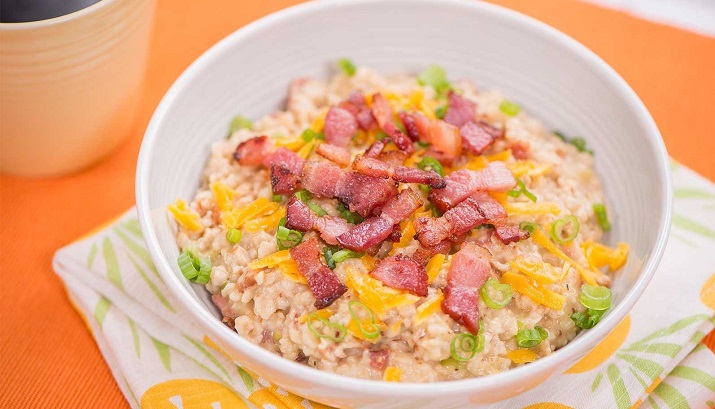
Source: Oats Everyday
You are probably used to eating oatmeal one way: throw in some sugar, milk, and pieces of fresh or dried fruit and you’re good to go. But what if I told you that you can take oatmeal to a new level by spicing it up with bacon bits, some shredded cheese, and a drizzle of maple syrup?
You have to admit that sounds interesting. Give it a try on your next canoeing , kayaking , or rafting trip, and see what you think about the pairing.
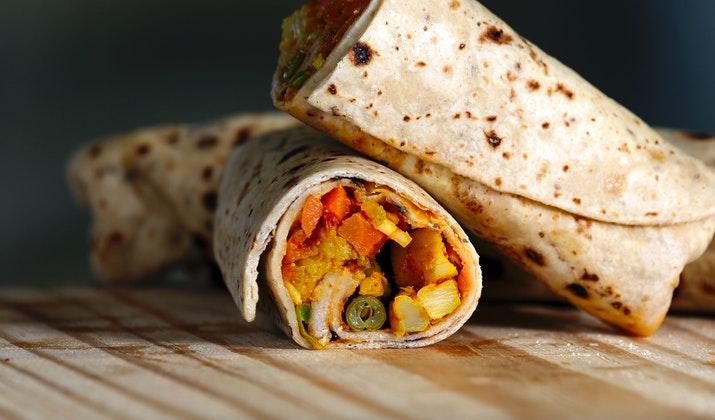
This classic Mexican dish contains refried beans, cheese, rice, avocados, peppers, onions, and your favorite proteins packed tightly to make one big, yummy wrap.
The beauty of burritos is they can be customized to suit your specific taste or preferences so feel free to swap out the ingredients you don’t like and throw in the ones you love to ramp up the flavor profile.
Don’t be surprised if you feel yourself drifting asleep after having this tasty and filling meal. Just make sure you are safely tucked away on land before letting your eyelids close.
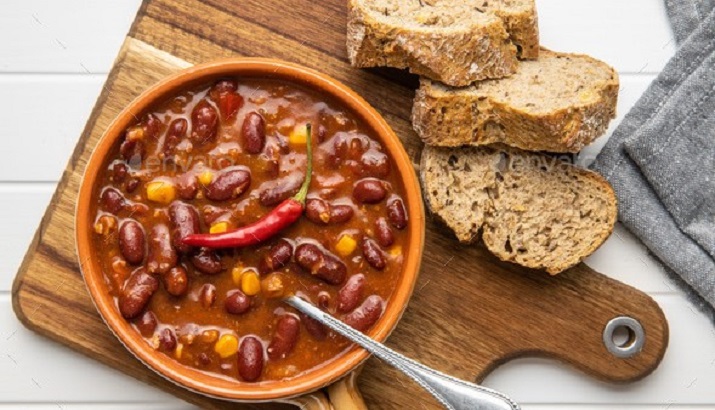
Source: PhotoDune
This is one of those meals that feel like home in a bowl and it will make a perfect addition to your float trip food menu. It’s incredibly easy to make and doesn’t require a lot of time or effort to put together.
Most of the ingredients for this meal””beans, tomato sauce, veggies, and ground beef or textured vegetable protein””can be dehydrated so they will take up little room in your supplies bag.
If you don’t have a dehydrator you can buy the dehydrated versions and just throw them in a pot when you’re ready to eat. You can also bring along some garlic bread with or pack the bread mixture and make it fresh. It only takes a few minutes.
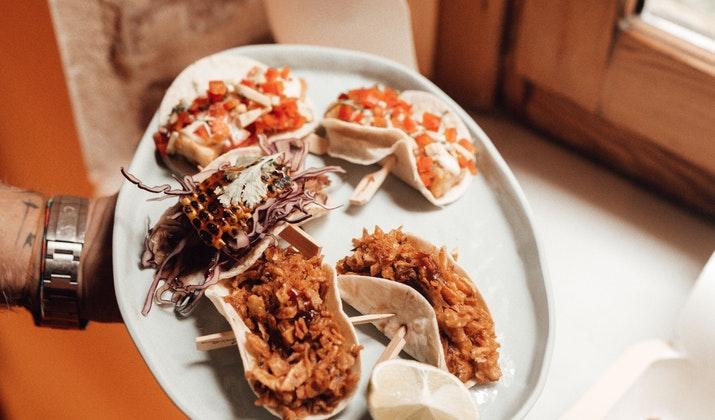
Tacos are another food idea for your float trip that’s worth trying if you want a lot of flavor without having to do a lot of cooking or prepping. The citrus-based marinade can be made ahead of your trip to add some zing to the taste of the chicken.
All you have to do when you set up camp is break out a grill, throw the chicken on it, assemble the tacos, and let the deliciousness flood your tastebuds.
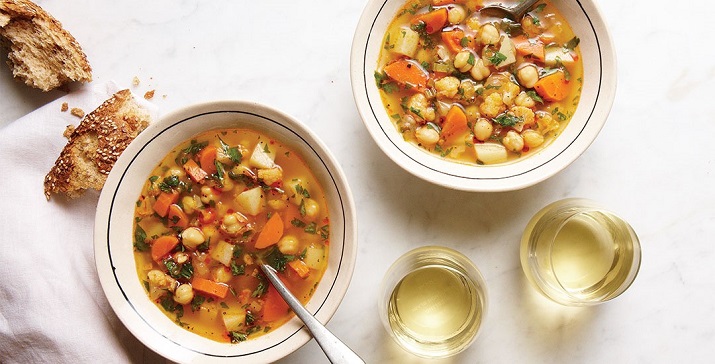
Source: Fine Cooking
This comforting, one-pot meal is a great way to retire after a long day of paddling across the river and soaking in the scenic surroundings. Don’t let the soup in the name fool you, this can be a very filling meal depending on how you make it.
It’s also very simple to make. All you have to do is throw the beans and whatever vegetables you have on hand into the pot, add some browned ground beef, pour in the broth, mix and let it cook for a while. You can serve it with bread to make it even more filling.
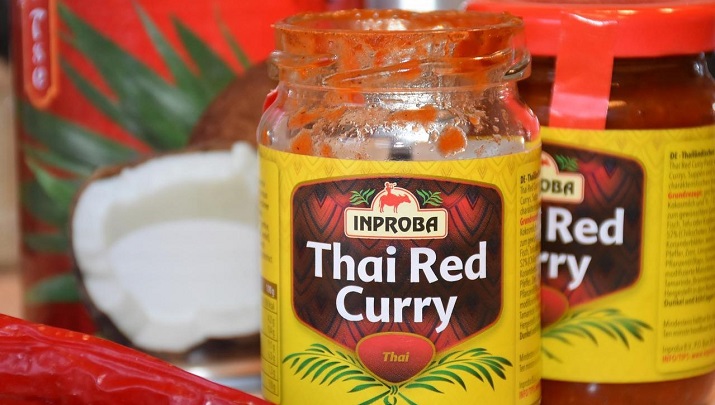
Source: Pixabay
If you’re looking for float trip meals that won’t have you toiling over pots or waiting long hours before you can finally feast, this Thai red curry is the answer to your desires. It is easy to make and super delicious too.
Instead of making your own Thai curry paste, you can simply buy a few small jars of it to mix with the other ingredients. The jars don’t require refrigeration before opening so the Thai curry paste will stay fresh until you’re ready to use it.
Boil some rice and scoop the Thai curry sauce onto it and dig in once the food is ready.
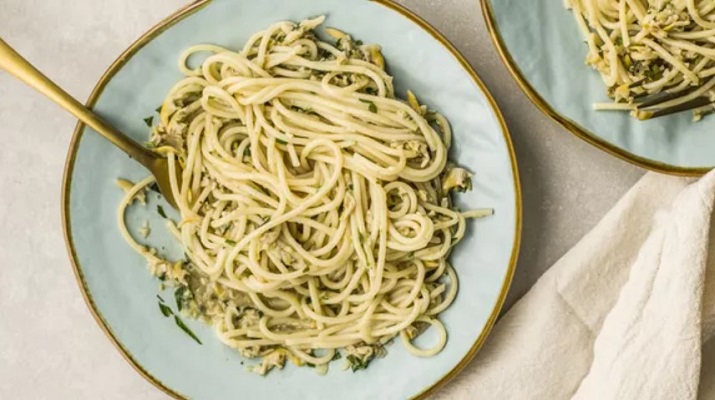
Source: Spruce Eats
After a long day on the water, you will probably find yourself craving a hot meal and there’s nothing like a tasty plate of pasta to help you recover from the day’s activities.
The best thing about spaghetti with clam sauce is how easy and quick it is to make””it will be ready to eat in 20 minutes tops.
You don’t have to worry about packing fresh clams, canned clams will work just as well. The juice from the canned clams will give this dish the tasty-briny flavor you’ll love.
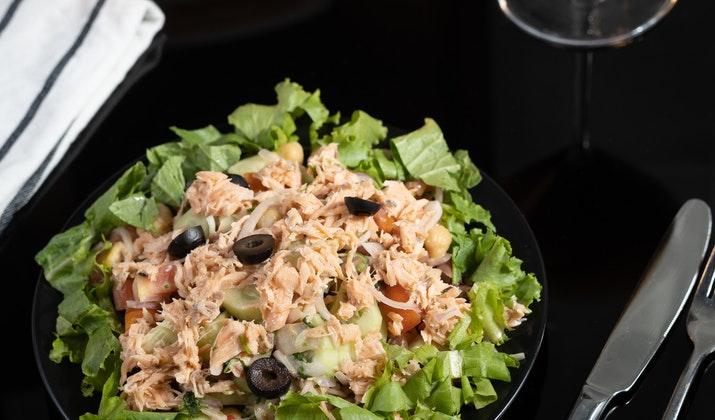
For an inexpensive and easy to prepare meal option for your float trips, I heavily recommend an albacore tuna salad. All you need is some canned tuna, lemon juice, dill pickles, celery, herbs, and your favorite flavor of mayonnaise to bring this comfort food together.
You don’t need a stove or to build a fire to cook this meal. Just toss and mix all the ingredients together in a bowl and it will be ready to eat.
You can serve your albacore salad with slices of bread or fold it into a tortilla to make a wrap.
One of the best float trip food ideas to plan for after a long, fulfilling day of exploring the outdoors and enjoying fun-filled activities is hot dogs with a generous serving of beans cooked in a cast iron skillet over a grill.
You can grill the hotdogs or cut them up and cook them with the beans in the app. The choice is yours, but either way, you are going to love downing this hearty meal.
- Get the recipe.
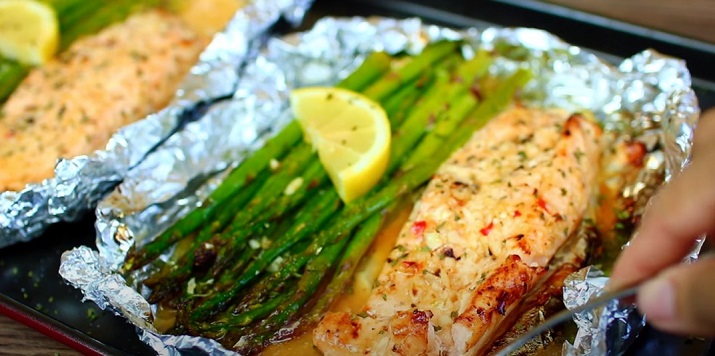
Source: Recipes
I promise you that this float trip food will have you licking your fingers or utensil in delight. It’s incredibly easy to make too.
Just place your salmon and vegetables in a foil then melt butter, mix with lime juice and zest, and pour it over the salmon. Throw in a few lime wedges, fold the foil packet to seal it, place it on the grill, and your mouth-watering lunch or dinner will be ready in a few minutes.
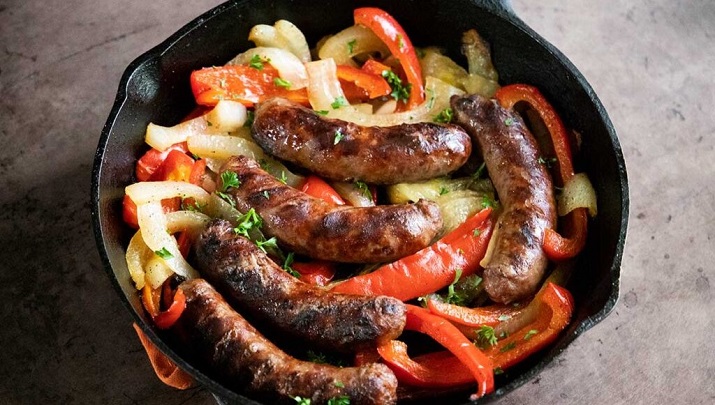
Source: Don’t Sweat The Recipe
No matter what time it is or what the season is saying where you are, this meal will make you feel like it’s a warm summer day. There are no special tricks or abilities required to cook up appetite-stimulating food.
You just have to place your cast iron skillet over a fire, add some oil, followed by the onions and peppers, then introduce the bratwurst into the mix and stir occasionally until it’s cooked through.
Once it’s ready, slice a sandwich roll and place the brats, onions, and peppers in the middle, drizzle some mustard on it, and enjoy.
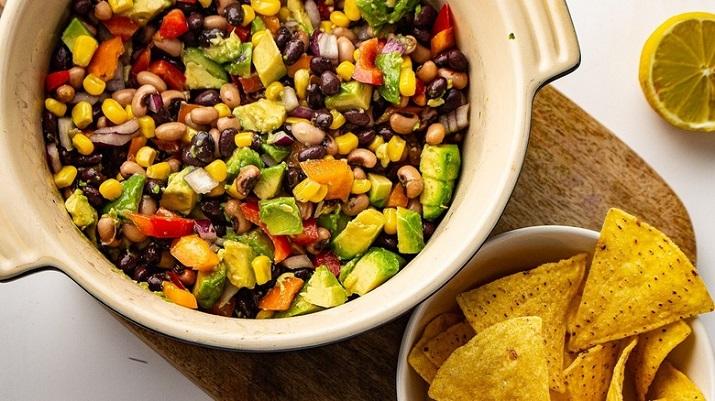
Source: Tasting Table
This is the perfect snack to accompany you for a day on the river , lake, or ocean. You can choose to prep it before you head out so you can munch on it whenever hunger strikes.
If you want to save some prep time or make the meal while you’re on the go, you can skip making your own chips and just buy some.
The ingredients for the caviar””tomatoes, avocados, sweet corn, black beans, bell peppers, red onions, and spices””don’t require cooking.
Simply add them to a bowl, toss to combine well, grab a pack of chips, and start scooping.
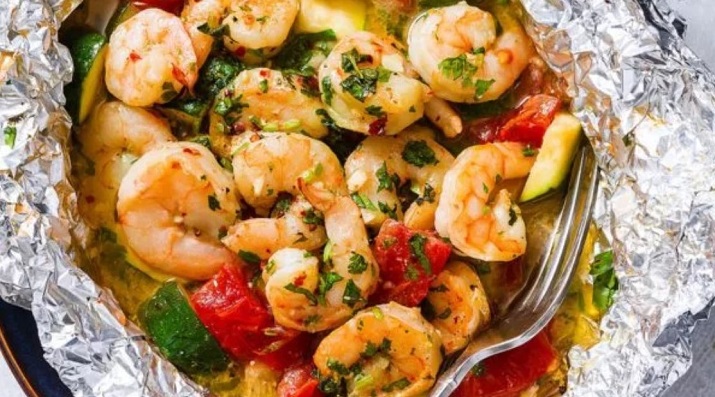
Source: Eatwell101
Whether you are having it on its own, with some cooked rice, a side of bread, or over a bowl of pasta, shrimp scampi is one of the best float trip food ideas you can try.
This foil packet version is easy to assemble and saves you the trouble of having to wash up pots and pans after you’re done cooking.
The shrimp will soak up all the buttery, lemony, and herby goodness of the ingredients to create an aromatic dish that will have you swooning even before it comes off the grill.
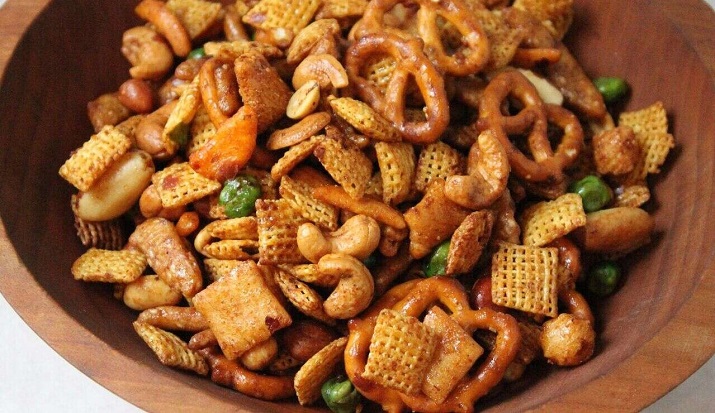
Source: Today
It’s always a great idea to pack some tasty snacks to munch on during your float trips so you don’t get lightheaded before you have to stop for food.
This sweet and spicy snack mix will have you licking the inside of the bag to make sure you’ve gotten every last morsel out.
There’s plenty of room for customization when making your snack mix so feel free to use a combination of your favorite crackers, cereal, and nuts in your mix. The star of the show is the sweet and spicy syrup coating that will give your snack mix that addicting flavor.
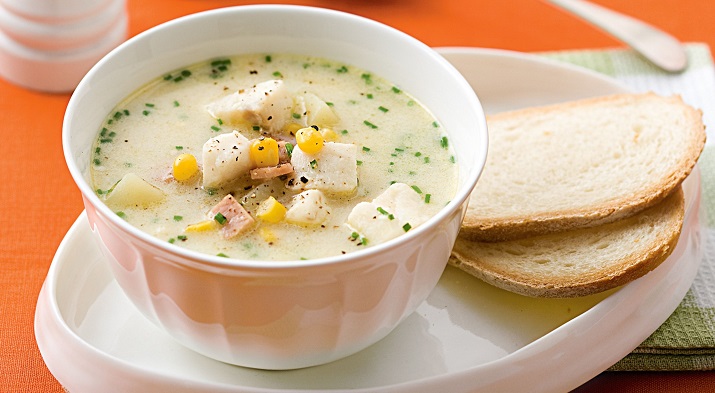
Source: Taste
Since you’re out having adventures on the water, eating seafood seems like an unavoidable consequence.
And what better way to enjoy the gifts of the sea than with generous servings of thick and creamy fish chowder.
The combination of fish filler, carrots, peas, potatoes, and sweet corn helps to make this hearty meal quite filling. But you can always grab some crusty bread to go with it if you need a little more weight from your meal.
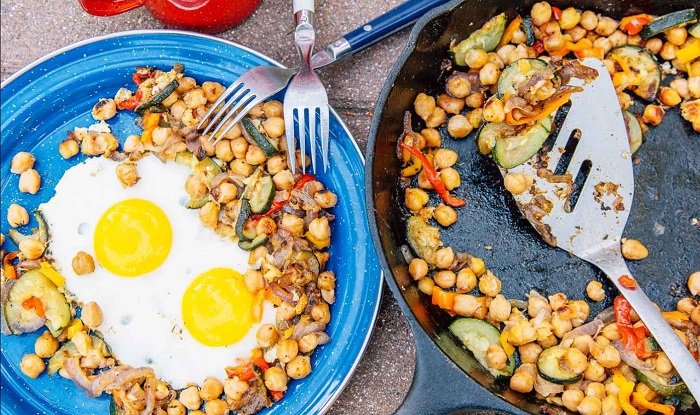
Source: FreshOffTheGrid
This breakfast food idea for float trips does away with the traditional potatoes and introduces chickpeas in their place to deliver a truly satisfying meal that is chock-full of proteins.
The cooking process only requires one skillet so cleaning up will be an uncomplicated affair.
Another great thing about the chickpea breakfast hash is its staying power. You won’t find yourself desperately craving an early lunch after eating this, which means you’ll have plenty of time to get into your float trip bucket list before you have to take a break.
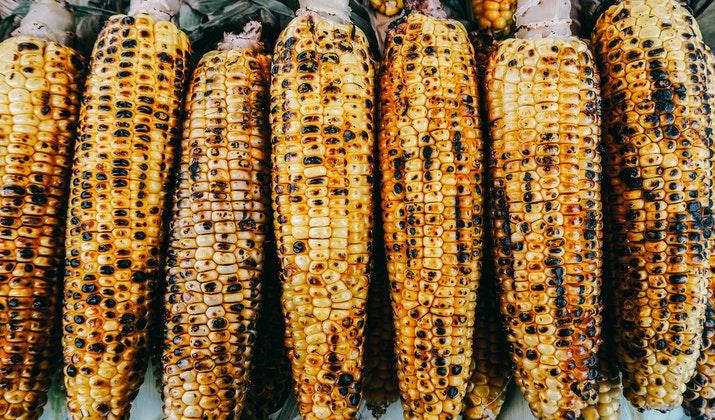
If you’re looking for simple food ideas for float trips, corn on the cob is one of the most uncomplicated meals you can make.
It’s also very versatile which means that you can enjoy it as a standalone healthy snack or incorporate it as a side for another meal like chilli or warmed-up baked beans.
For best results, make sure to soak your corn cobs in water for about 30 minutes before grilling them.
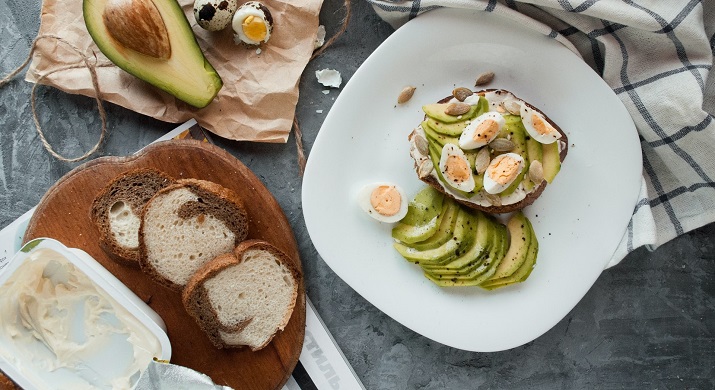
Source: Unsplash
You can prepare this meal to have as a snack during your float trip. You just have to boil some eggs, toast a few slices of bread, select a few avocados, and pack them all into your storage bag .
Since avocados go brown quickly after they are cut, it’s best to keep them whole until you’re ready to use them.
When that time comes, simply mash your avocados and spread them over the toasted bread, then slice the hard-boiled eggs and arrange them on top of the toast.
You can sprinkle salt and pepper in the mixture to embolden the taste. If you’re packing raw eggs as well, mark the shells of the boiled eggs with a sharpie so don’t mix them up.
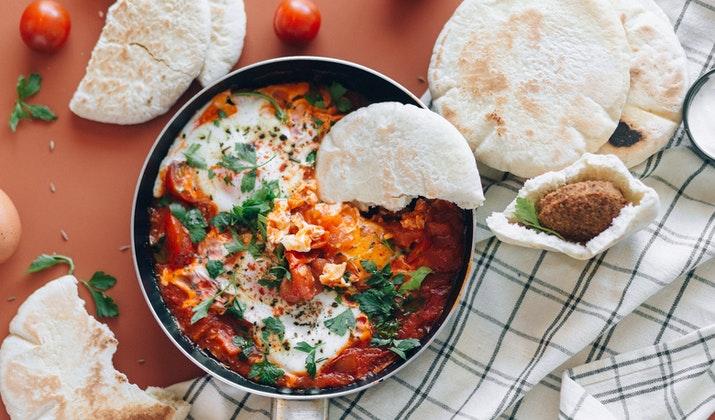
Give this North-African dish a try the next time you go on a float trip. Whether you’re having it for breakfast, lunch, or dinner, Shakshuka is hands-down one of the best and most interesting ways to enjoy eggs.
It’s a simple dish that involves gently poaching eggs in a spicy tomato sauce and adding a sprinkle of crumbled feta cheese at the end.
You can enjoy this heartwarming meal on its own or add some slices of crusty bread to elevate the experience. Feel free to add avocados and microgreens as a garnish and don’t forget to relish every spoonful.
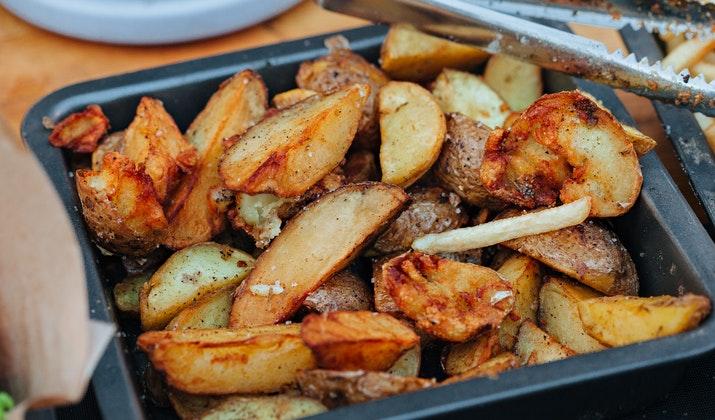
When you’re outdoors having the time of your life, you need a satisfying meal to keep your energy levels up and ensure you make it to the end of your float trip in one piece. Cheesy garlic fries are the perfect quick and easy food option for you.
You don’t need an oven to bring this recipe to life, just throw the seasoned potatoes into a foil packet and cook it over an open flame. Your potatoes will come out looking crispy with that extra smoky flavor to make it even more delicious.
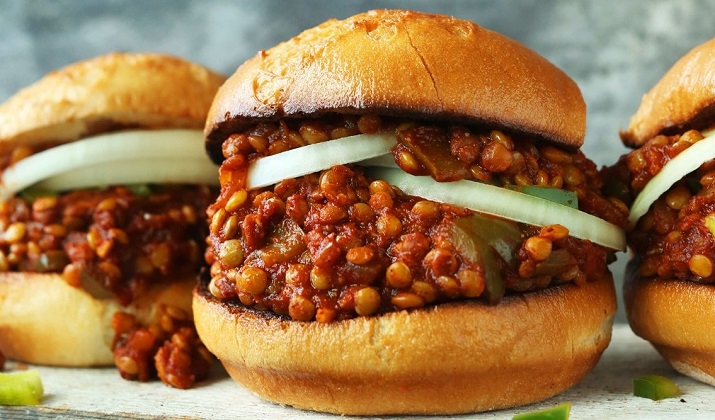
Source: Minimalist Baker
Swap out the meats for this plant-based, protein-dense spin on the classic burger. What you need to get your meal cooking is some red lentils, onions, salt, garlic, pepper, mustard, tomato paste, Worcestershire sauce, maple syrup, and apple cider vinegar.
Once the lentils are done cooking, slice a bun in half, heap the tasty sauce, and take a huge bite. I promise it’ll taste even better than you imagine so don’t be surprised if you find yourself whipping up a bash to eat even on days when you’re back home.
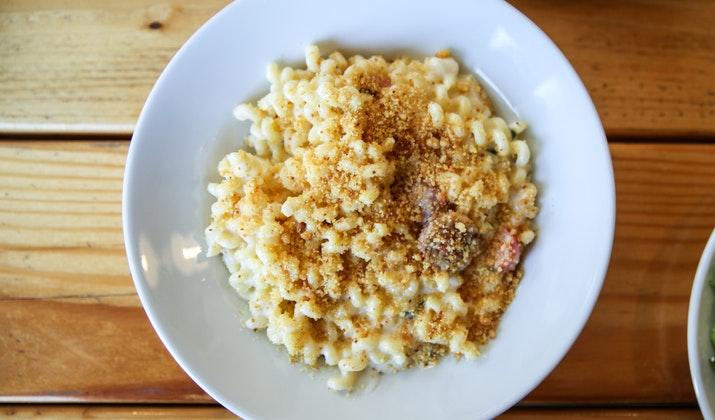
Few meals provide the comfort and satisfaction that the mac and cheese offer, so it deserves a spot on my list of best float trip food ideas. Whether you’re picking up the mac and cheese from the store or making your own, this meal involves very light prep work.
You can eat it straight from the pack whenever you get hungry or wait till you get to your camp tent and heat it on hot coals until the cheese bubbles and melts.
If you plan on storing your mac and cheese in a cooler, make sure you seal the pans or tubes in a ziplock bag to keep water from getting into them and ruining your perfectly planned meal.
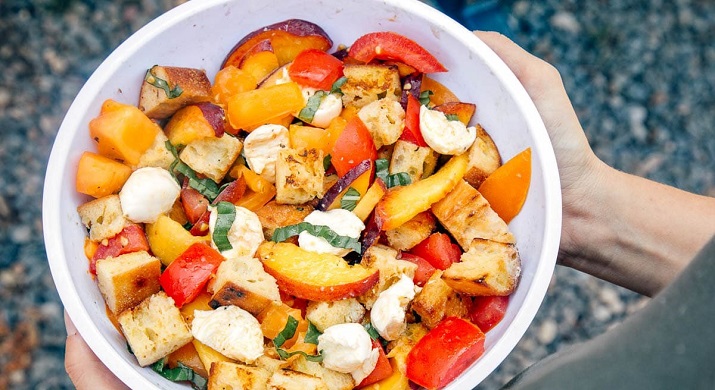
If you love croutons, you are going to thoroughly enjoy this nourishing float trip food. The croutons are tossed with tomatoes, peaches, basil, and mozzarella with a healthy drizzle of white wine vinaigrette.
This meal works great as the star of the show or as a quick side act before the main event.
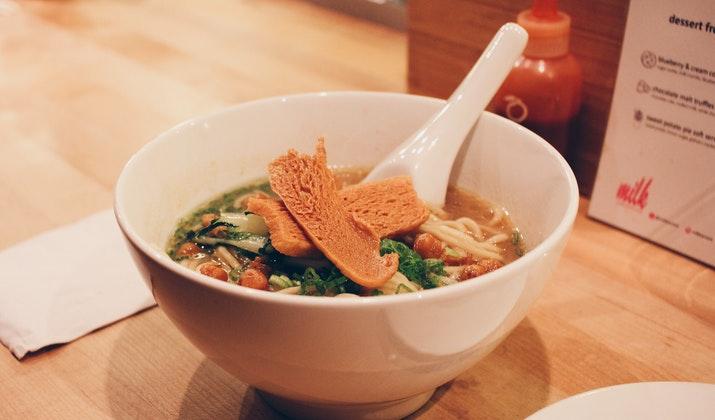
After spending the day fishing and basking in the scenic views as you float down the river, a good bowl of chicken ramen soup is just what you need to nourish your body and warm your heart.
It only takes about 30 minutes to cook up this flavorful recipe so you’ll be able to dine in no time.
You no longer have to spend days or weeks wondering what you’re going to eat on your float trip, nor do you have to carry a ton of processed foods with you.
You can still enjoy healthy, amazing meals even while you’re out exploring the waters.
No matter your food preferences or how picky an eater you are, you’re bound to find a couple of float trip food ideas on this list that will help fuel your next outdoor adventure.
Enjoyed 30 Float Trip Food Ideas? Share it with your friends so they too can follow the Kayakhelp journey.
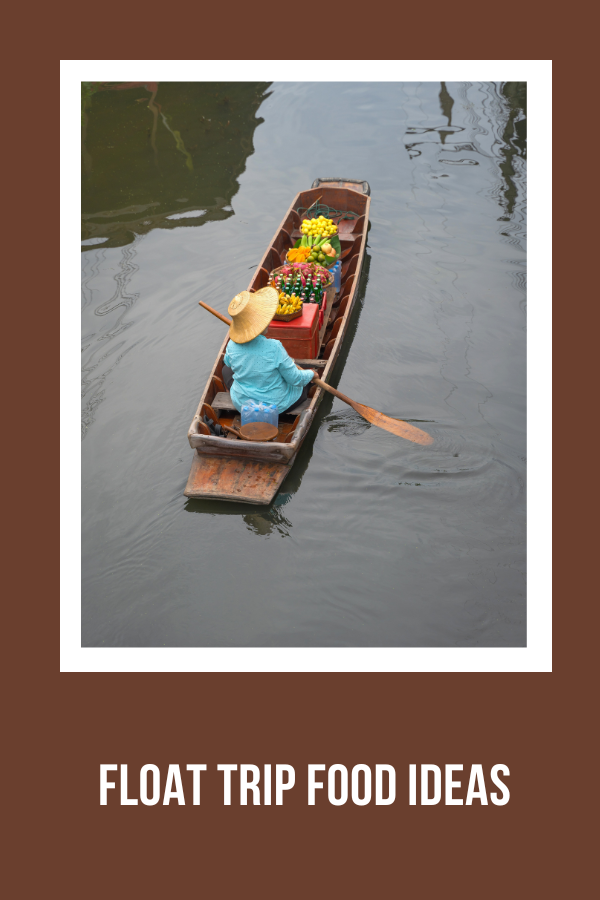
Peter Salisbury
Pete is the Owner of KayakHelp.com. Born and raised in Cleveland, Ohio, he grew up kayaking, fishing, sailing, and partaking in outdoor adventures around the Great Lakes. When he’s not out on the water, you can find him skiing in the mountains, reading his favorite books, and spending time with his family.


The Ultimate Float Trip Essentials – What to Bring on a Float Trip

Wondering what exactly to pack for your next float trip? You’re in the right place! Float trips are a wonderful way to get out in nature and have an adventure. We are huge fans of float trips and love to explore the best places to float in every state. It can be quite difficult to pack for a float trip as there are so many different things you need to bring . Since we’ve been on so many float trips, we have made this river trip packing list to help you out. This ‘What to Bring on a Float Trip Guide’ will tell you all the float trip essentials you will definitely need for any type of float trip!
But First – What Is A Float Trip?
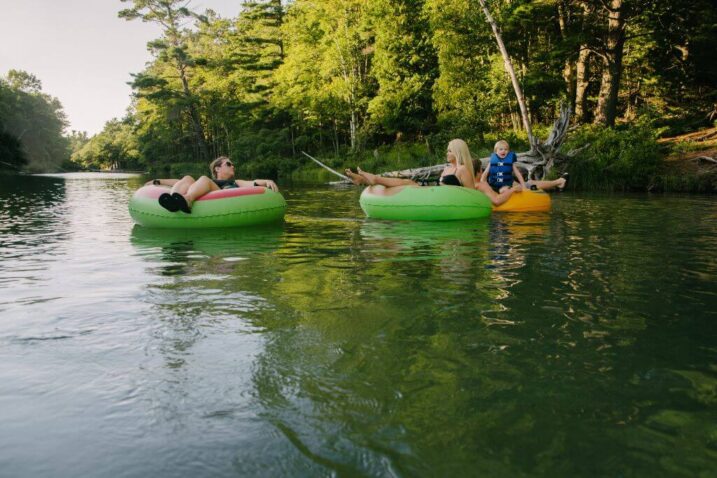
You might be wondering- exactly what is a float trip? Float trips can be different depending on what you are looking for but essentially, they are floating down a river in a canoe, kayak, raft, or tube!
Some people like to float down a river just for the day and others enjoy going on a longer float and camping on the banks of the river overnight.
Some people want to have a float trip party where there are lots of people drinking and having parties on the banks of the river. Others enjoy floating down a quiet river without many people just to enjoy nature. It’s really all up to what you are looking for!
🛶 Need some float trip ideas? 🛶 Learn all about the best float trips in Missouri
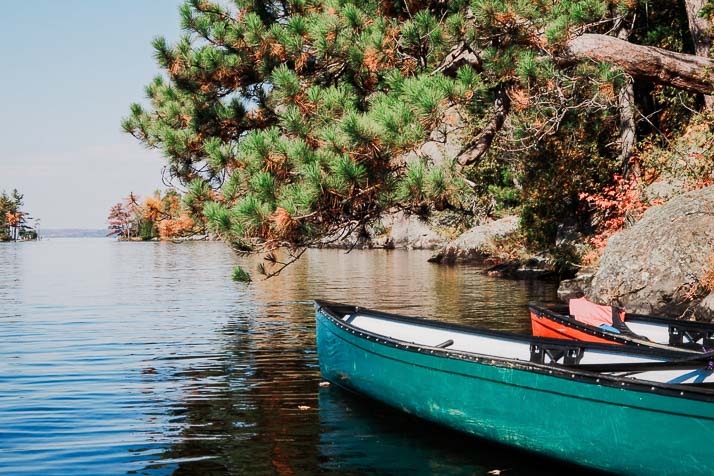
Float Trip Packing List Overview
Here is a quick overview of what to bring on a float trip so you can begin packing for the ultimate float trip. We have included all of the river floating essentials and float supplies so you don’t have to think twice about what to bring!
- Floating accessories (hat, towels, sunglasses, sunscreen)
- Float trip clothes
- Water shoes
- Float trip equipment
Float Trip Accessories
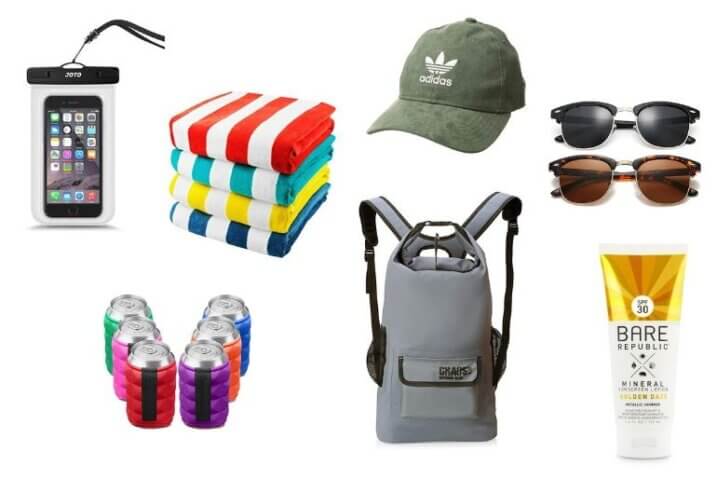
No what to pack for floating the river list would be complete without these things. Here are a few float trip accessories to add to your floating the river essentials list.
| 1. Waterproof Phone Pouch | 2. Beach Towels | 3. Sun Hat | 4. Sunglasses | 5. Drink Koozie | 6. Dry Bag Backpack | 7. Sunscreen |
- Waterproof Phone Pouch – This phone pouch is one of the more important river floating necessities you will need thing if you are going on a float trip. Of course, you will want to bring your phone to take pictures but don’t risk it getting wet or dropping it in the river!
- Packable Beach Towel – Bringing a nice beach towel that you can pack easily in your dry bag is another one of our float trip must-haves. Some beach towels can be really bulky and take up too much room in your bag and if you leave it out it will get wet and then there is no point in having a towel!
- Sun Hat – Going on a float trip without a good sun hat would be a big mistake. Make sure you have something that will protect your face from the sun as well as keep you cool!
- Sunglasses – Sunglasses are of course a must for any float trip! We really like polarized sunglasses and also don’t forget a sunglasses strap so you don’t lose them to the river.
- Hands-Free Drink Holder – a hands-free drink holder is probably the best invention ever and will totally elevate your float trip experience. Whether you are kayaking or canoeing and need your hands to paddle or you are relaxing in a tube, having your drink securely around your neck is a game changer!
- Dry Bag Backpack – This dry bag backpack is another one of our favorite river tubing accessories. Having the bag have backpack straps is another great option for being hands-free. And of course, it’s waterproof so you can keep all your gear dry!
- Sunscreen – Don’t forget the sunscreen! High-quality sunscreen is more important than ever these days and is the number one what to bring on float trip. It’s also important to wear sunscreen that won’t be damaging to the ecosystem of the river. This is our favorite sunscreen for both of those things.
Best Coolers For Float Trips

A floating cooler has got to be on the top of your river trip packing list for our what to take on a float trip checklist. Whether you want to stock it full of beer or lemonade, you will definitely need a way to keep your drinks cold!
People think of everything these days and these tow-behind coolers are one of the most fun things to bring on a float trip. If you don’t want a tow-behind cooler another great option would be a waterproof, portable backpack cooler .
- Tow-Behind Floating Cooler – Having a tow-behind floating cooler is a game-changer for people who have a small kayak or tubes and don’t have room for a huge cooler!
- Backpack Cooler – Another great option for keeping your drinks cold. A backpack cooler is great for being hands-free when you have to carry your other stuff down to the river.
What To Wear On A Float Trip
A great question for anyone going on a float trip is – what do you wear to float the river? Rashguards are great river trip essentials for anyone looking to avoid continuously applying sunscreen. These rashguards are great for swimming and they are cool and breathable! They are one of the most essential things to bring on a float trip to protect yourself from the sun.
Here are our picks for the best float trip shirts:
Women’s Sun Protection Shirt

Men’s Sun Protection Swim Shirt

The Best Float Trip Shoes
When looking for things to bring on a river trip, waterproof shoes are a must-have. We absolutely love our Chacos and wear them for all types of adventurous activities.
They are especially great for hiking through streams and rivers, as they dry off quickly. They are super comfortable and also have a great grip which helps with getting in and out of the river or walking around in the river.
Chaco Women’s Sandal

Chaco Men’s Sandal

The Best Float Trip Speakers

Of all the river floating supplies, you can’t forget to pack a waterproof speaker ! Speakers are definitely the ultimate floating the river accessories out there and one of the best float trip must-haves.
We are big fans of our JBL speakers – and a waterproof one with a clip to attach to a backpack or secure on your canoe/kayak/raft is a game-changer.
Best River Floating Equipment
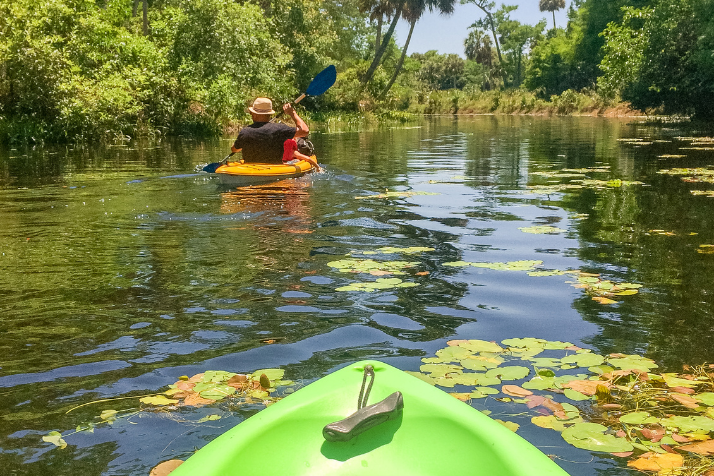
Best Kayak For River Floating

A kayak is most definitely the ultimate river floating equipment out there and the #1 thing we recommend when thinking about what to take on a river float trip.
Kayaking gives you the most control so that you can navigate easily around rapids and go pretty much anywhere you want in the river.
A kayak is a great addition to your float trip supplies and can be used to float rivers all over the country. A lot of people don’t want to splurge on an expensive kayak as it can be quite expensive.
That’s why we’ve put together a guide to buying the best beginner kayak on a budget.
If you plan to do a lot of float trips in the future, we would highly recommend investing in your own floating equipment .
Outfitters usually charge $100 per day for a kayak or canoe, which can get expensive if you plan to float a lot! With lots of great budget options out there, it’s definitely worth it to buy your own in the long run!
Best Float Trip Raft
Of all the float trip necessities, having a reliable float trip raft has got to be number one on any river floating gear list.
You can most likely rent a raft at any outfitter located along the river, although their prices are normally pretty expensive! Having your own raft to bring floating whenever you want can save you a lot of money in the long run. Here are our picks for the best rafts for river floating:
Budget Option: Intex 2-Person Inflatable Boat

Pro Option: Intex 5-Person Inflatable Boat

The Best Canoe Accessories
If you like to float rivers in a canoe, you can’t forget canoe accessories! Having a chair with back support and detachable cupholders makes a whole new float trip experience and are 100% canoeing must haves.
Check out our best picks for canoe chairs and cup holders:
Adjustable Canoe Seat

Cup Holder For Canoes & Kayaks

Best Inner Tube For River Floating
The ultimate old-school way to float a river and one of the only river tubing essentials, an inner tube! Using an inner tube for river floating is a great option when the water levels are high and the water is moving fairly fast.
Inner tubes can be a lot of fun when you have a group of people and you can tie them all together and have your inflatable/floating cooler following right behind you. They are the ultimate what to bring to the river gear.
Here is our pick for the best inner tube for a float trip:
One-Person Tube: Intex River Run Inflatable Tube

Two-Person Inner Tube: 2 Person w/ Cup Holders & Cooler

Float Trip Food Ideas
Don’t forget to add float trip snacks to your float trip list! Here are some snacks for floating the river :
- Granola bars
- Homemade sandwiches
- Pringles (since they are in a hard container and can’t get squished)
- Fruit (apples, oranges, bananas)
- Cheese & crackers
River Float Trip Checklist
In this section, we have our “Checklist for Float Trip” laid out so you can have a quick overview of all the floating the river necessities so you don’t forget anything.
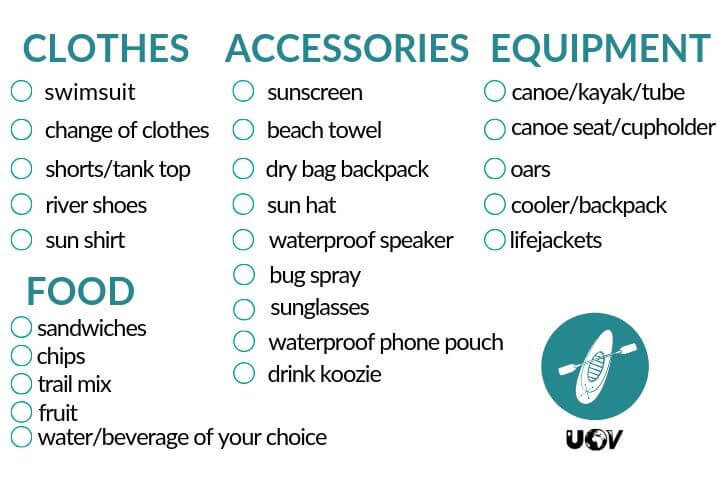
We hope in this ultimate packing for a float trip guide we helped you figure out different things like what to wear to float the river, river floating tips, and what to bring on a river float trip. There are a lot of river trip gear essentials to remember, so make sure you reference this packing list whenever you’re going on a float trip!
🛶 Need some float trip ideas? 🛶 Learn all about the best float trips in Arkansas
You May Also Like:
- Ultimate Guide to Current River Float Trips
- Niangua River Float Trip Guide
- Best Float Trips in Arkansas
- The Ultimate Guide to Buying the Best 4 Person Tent
Jess Drier is co-founder of Unearth The Voyage. She loves outdoor adventures, hiking, camping, going on float trips, and exploring new countries. She has explored more than 20 countries, taught English in South Korea, and visited 28 stunning National Parks while living in her RV. She loves sharing her knowledge here on Unearth The Voyage in detailed guides and helping others discover the great outdoors and their love for travel!
Similar Posts

Jackson Falls in Southern Illinois (Hiking, Climbing & Camping)

12 Epic Buffalo River Cabins to Stay at in 2024

7 Best Rivers in Oklahoma to Float in 2024

The Best Cabins in Shawnee National Forest for a Weekend Getaway

20 BEST Hikes in Arches National Park
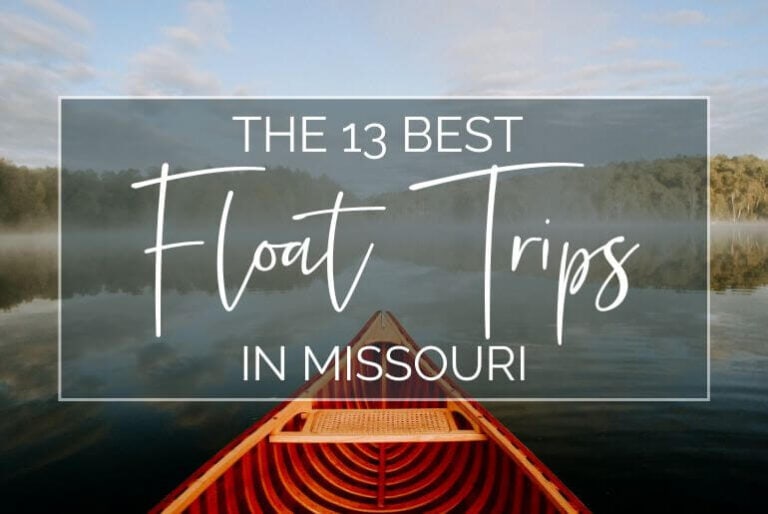
10 Best Float Trips in Missouri

17 Boat-Friendly Food Ideas | Best Boat Snacks for Adults
We’ve all been there. You’re sitting aboard a boat, floating your way down a tranquil river while a guide points out the beautiful attractions as you pass them by. Suddenly, some guy named Jerry decides it’s lunchtime and whips out the egg sandwiches his wife made for him the previous day. Nausea sweeps through the passengers and crew aboard the boat, while everyone throws disdainful glances at Jerry. Don’t be a Jerry!
For the sake of your fellow passengers and yourself, you need to pack boat-friendly food when traveling by water. There’s just something about the movement of a boat that doesn’t coincide well with certain foods. So I’m here to help you out. What are the good boat snacks?
Best Boat Friendly Foods
So you’re looking for some of the best boat food to avoid being a Jerry on your next boat trip? Luckily, there are plenty of foods that can go down well onboard, the trick is to know which foods to avoid. Ready to find out about boat-friendly foods both you will love?
Good Boat Food Ideas
Wondering what food to bring on a boat trip? For journeys that last for longer than a few hours, often a meal will be provided. But in instances that you need to bring your own meal, you need to make sure that it’s boat friendly.
Because boats often rock up and down by nature, you need to make sure that it’s food that won’t rock around too much. It’s also best to have a meal that doesn’t emit a strong odor (for the sake of the other passengers onboard). You never know when someone might have a slightly sensitive stomach.
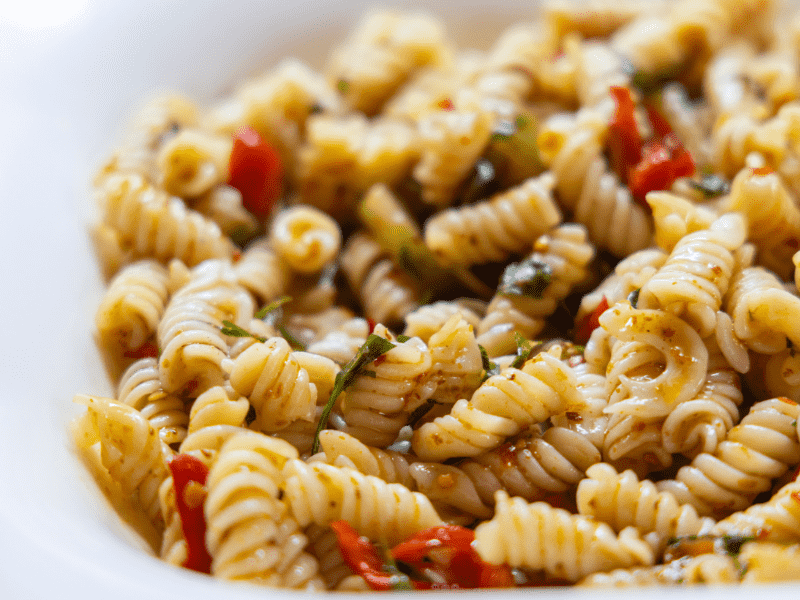
1. Pasta salad
There’s nothing that grounds the stomach and fills you up all at once like a good portion of carbs. A cold pasta salad is a great thing to bring on a boat as you won’t need to reheat it before eating, and it’s easy to slip a container into your bag.
Whether you prefer pesto pasta or a more traditional chicken and mushroom, it’s sure to go down a treat on your boat trip.
2. Sandwich wraps
Good ol’ sandwiches have never let me down. This is a great meal to pack for yourself if you’re in a hurry to get out the door. It’s quick and easy to make, and easy to unwrap during your trip on the boat. You can also switch it up with a variety of toppings if you happen to be someone who takes frequent boat trips.
3. Cold fruit
Indulging in some icy cold fruit goes down such a treat while you’re sitting aboard a boat, especially if you are sitting in the sun. Not only does is it aid in cooling you down, and working as a refreshing snack, but there’s something about a cold meal that makes you feel a little more grounded aboard a boat.
4. Pigs in a blanket
Pigs in blankets are an old classic, and while they may be more popular amongst kids, they do make for a great meal no matter your age. My preference is to pair them with a little tomato sauce, but if you prefer to eat them as is then this meal just got a whole lot easier to pack.
Best Boat Snacks
Boating snacks are something you’ll need if you’re going on a trip that is longer than an hour. You don’t want to be trapped on the water when your stomach starts to growl. Having a light snack also helps if you start to feel seasick as it makes your tummy feel a little more grounded. Trust me when I say, a snack can come in very handy when you’re out on the water. These are some of the very best snacks for boating.
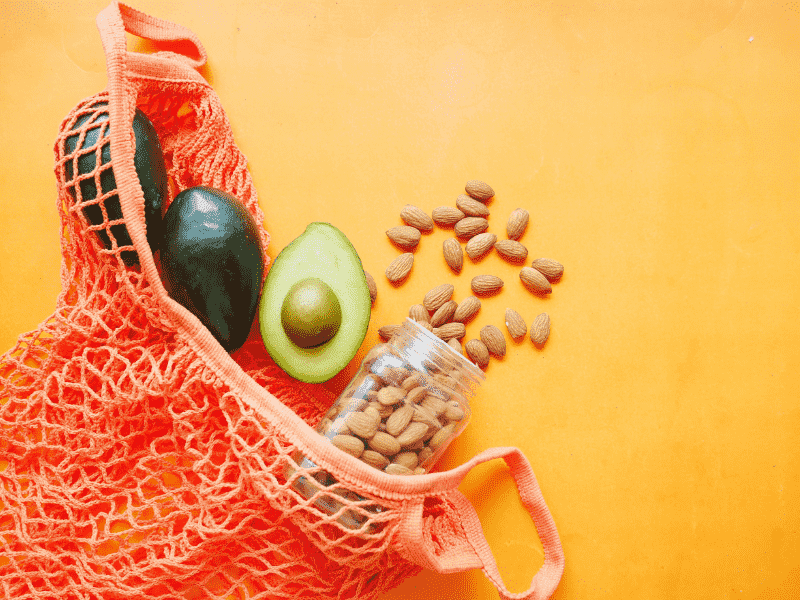
5. Trail mix
Trail mix is one of those trusty easy-to-pack and easy-to-eat snacks that always go down well. Not only does trail mix offer a variety of items, it is also very filling for its size. Which is exactly the sort of great boat snacks that everyone needs.
Muffins, whether home made of store bought, offer a nice boost of energy and taste delicious. They are also fairly small, making it easy to slip one in your bag, negating the need to bring a cooler bag with you. And in my personal experience, having one less thing to carry on a boat trip is something I’ve always been grateful for.
7. Lemonade fruit popsicles
Lemonade fruit popsicles are incredibly easy to make, and are a refreshing treat when you’re aboard a boat. All it entails is pouring lemonade and a couple of pieces of fruit into a popsicle maker, and popping it into the freezer overnight. For more information on how to make these delicious treats, check out this blog .
Popcorn is another grounding food, yet it’s still light and doesn’t make you feel over full. Which is something you want to avoid when taking a trip on the ocean or down a river. It’s another easy-to-make food that you’ll be grateful you packed in your bag.

Boat Party Food Ideas
Are you looking for food to bring on a yacht party? This can be a tricky thing as it has to be light, and it has to suit the tastes of as many of your guests as possible. So whether you’re looking for the best finger food for boating or other good boat party food, these are a few of the best in my opinion.
9. Frozen grapes
Frozen grapes are another simple delight that are easy to make, and they’re ever so refreshing. The icy crunch you hear when popping them into your mouth is exactly what you need on a warm day, so they make great boat party snacks.
10. Veggie skewers & dip
When your boat is out on the water, you generally feel like something a little healthy, and light snacks always keep the seasickness away (if you’re prone to feeling a little queasy on the water). Adding a dip like hummus to the mix just makes the snack that much more appealing. If you’re looking for boating snacks for a party, these will be winners.
11. Chips & salsa
Chips and dip, or chips and salsa are typical party foods, and there’s a reason for that. Everyone loves finger food when they’re at a party so they don’t need to sit down for a full meal, yet they’re still keeping their hungry tummies satisfied. Chips and salsa not only goes down well at land parties, but on yacht parties as well.
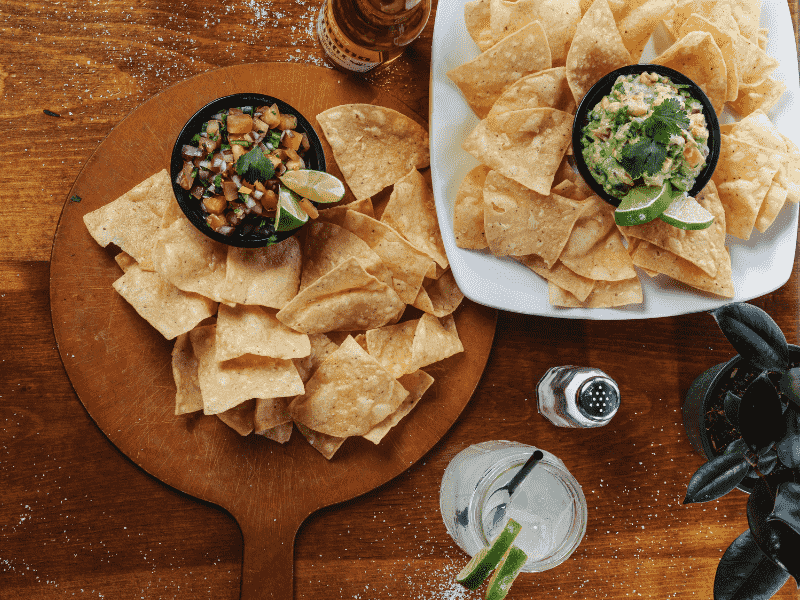
Kabobs are great because they come in such a greta variety, and if you’re making them yourself, you can really get creative with it. While they generally come with a meaty snack, you can throw in some veggies too. And if you have some vegetarian or vegan guests on your boat, they’d love a veggie kabob.
13. Cookies
Cookies are my guilty pleasure, and it hasn’t taken me long to realize that many people bare this same affliction. There’s nothing better to follow up a savoury snack than a sweet one. So be sure to provide your boat party guests with something to satisfy their sweet tooth as well. A nice chocolate chip cookie is a snack that most people are unable to say no to.
Food to Take on a Pontoon Boat
Are you heading out on a tour and wondering what food to bring on a pontoon boat? While touring, it’s often best to take snack foods, as well as foods that won’t take too much noise. While your carrots are not likely to scream, the crunch may annoy other tour-goers trying to concentrate on what the tour guide is saying. These are some considerate snack choices for your pontoon boat tour.
14. Hot dogs
Hot dogs are generally thought of as good snacks for kids. But why? They are delicious and provide both the protein and the carbs to get you through the boat trip. So if you’re heading out on a guided pontoon trip, hot dogs make a great snack as they’re fairly odour free and won’t be distracting to other tour goers.
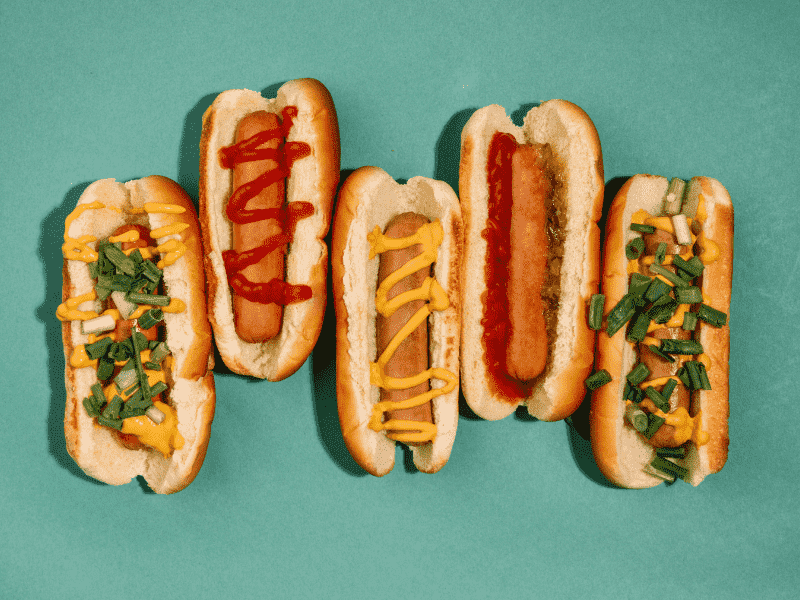
15. Walking tacos
Tacos are notoriously delicious, but they are also known to be messy. The messy factor can be negated by getting walking tacos, which are wrapped up nice and snug, so that none of your fillings fall out and become food for seagulls. They can also be kept in your bag for a couple of hours, so you won’t need to take a cooler box to keep this convenient food fresh.
16. No-bake energy bites
No bake energy bites can be made in a whole variety of ways, but the easiest way is with peanut butter and oats. Roll them up in a tight ball and you’ve got a snack that will provide you with energy throughout the day. The oats will also work to ground your stomach while you are aboard the boat.
17. Granola bars
It doesn’t get easier that popping a granola bar in your bag before heading to the jetty. This is perfect for travelers that are always on the move, and don’t have time to meal prep before their boat trip. It’s also a tasty treat, so you won’t be complaining that you didn’t plan ahead.
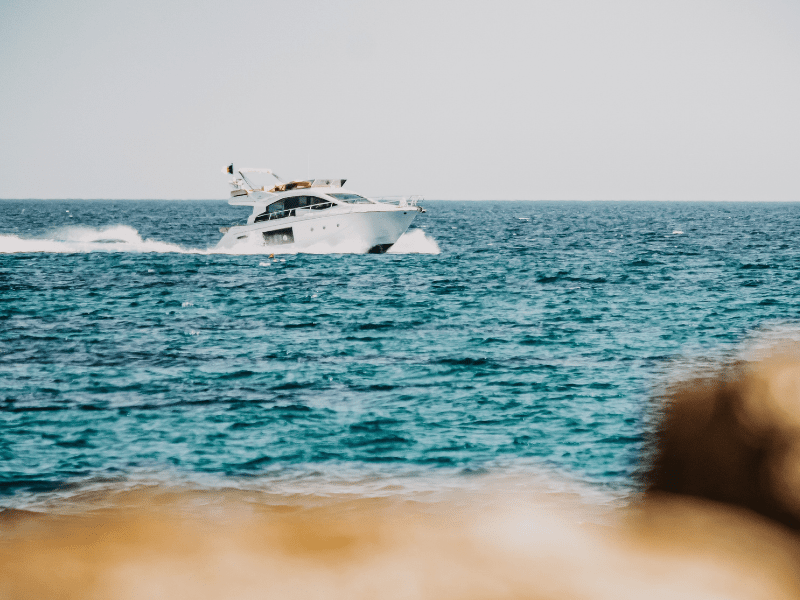
Wrapping Up Snack Ideas for Boating
Now that you have a better idea of what snacks to bring on a boat, you can enjoy your trip onboard without worrying too much about your food choices. Rest assured that I have picked out only the most convenient foods to eat on the water.
Enjoy your boat trip!
Leave a Comment Cancel Reply
Your email address will not be published. Required fields are marked *
Save my name, email, and website in this browser for the next time I comment.
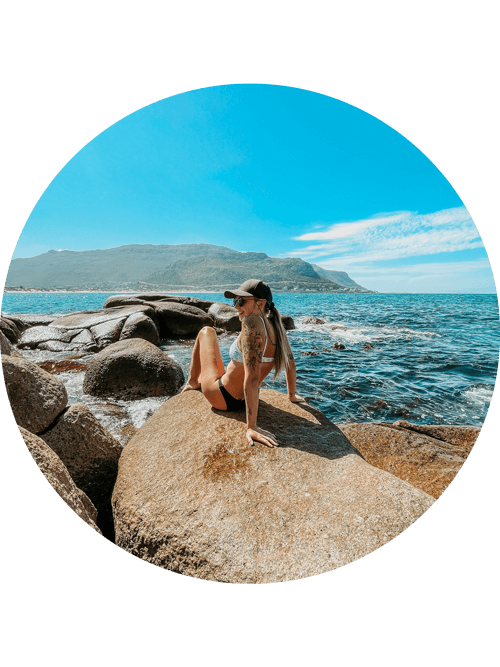
Hi, I’m Tyla. I have been working toward gaining freedom from the constraints of the everyday grind since the very start of my career. Working remotely in digital marketing allowed me the freedom to start my own passion projects that center around the adventures I enjoy most.
Having lived near the ocean my entire life, I have an affinity toward spending time on the water, and I want to share that passion with all of you. I hope you enjoy reading about my boat trips as much as I enjoyed taking them!
The Boat Tripper contains affiliate links. If you click one of them, we may receive a small commission at no extra cost to you.

- Terms and Conditions
- Privacy Policy
Copyright © 2022 The Boat Tripper. All rights reserved.
Get in touch
1-918-708-6800

Give the Gift of a Float - Buy Now!

What Grub To Bring: Float Trip Food Ideas
One of the top float trip essentials is good food. Having snacks or a small meal handy can definitely settle the hangry monster in your group. Families should plan ahead and save some space in their gear for the necessary fuel up to make float trips more enjoyable.
But the question is, what should you bring with you? Your choice of float trip snacks should be energy-giving, thirst-quenching, and filling all at the same time. Taking that into consideration, any bottled drinks, finger foods or sandwiches not requiring a dish will be great for float trips.
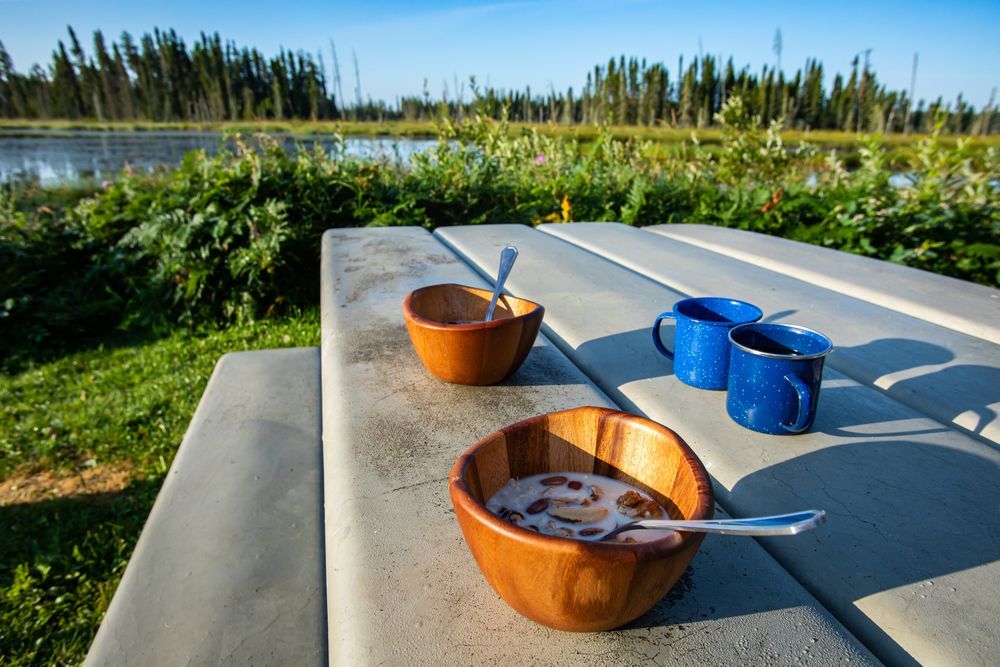
Food For Float Trip Checklist
A river float trip is an intense activity. Usually, float trips last for a whole day, so you should bring food and snacks that can combat fatigue and thirst.
Energy Eats
When we’re talking about energy, the best source is carbohydrates . However, energy can also be gained from protein and fats. Be creative, yet light when deciding what you want to bring with you. Also, make sure that it is tasty as well for everyone to enjoy. Here are simple ideas you can use as a springboard for what to eat during during your float trip.
- Summer Sausage Sandwich
This classic food can be great for breakfast, lunch, or dinner. It can be eaten whether you’re floating on a raft boat or chilling by the side of the river. Float trips are instantly awesome when you have good on the go.
- Hard Boiled Eggs
Eggs are delicious, nutritious, and portable. Eat them whenever you want a quick snack or add them to your meal.
- Bacon And Cheese Sandwich
This sandwich is a great grab snack. You can munch on this while relaxing and floating down the river.
- Crackers, Chips & Cookies
Talk about carbs, fat, and p rotein in one. These easy to handle yummies are a favorite taste among kids and everyone else, plus simple to share. Try choosing the large bag or box to keep down on more litter. Bring plenty because anyone famished from all-day float trips will surely gobble it all up.
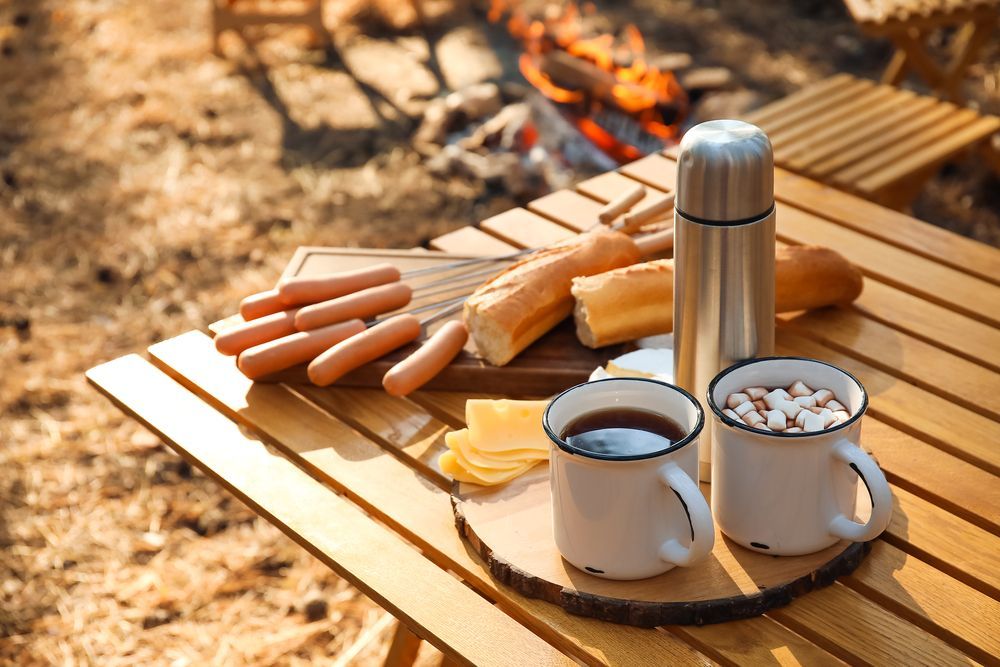
Thirst-Quenching
River float trips can be exhilarating, but when you’re out in the sun for an extended period, you’re bound to get thirsty. Fight heat and exhaustion on float trips with a good amount of liquids.
Bring a cooler with you to store all your drinks. A good dry bag is also a good idea to take along with you. You can also rent a cooler tube . This is an inner tube you can use to tow your cooler along on your float trip.
Nothing beats plain water during outdoor adventures and float trips. On a river floating trip, you have water around you to splash in, and don’t forget to bring water to drink and stay hydrated.
- Fruit Juice
Whether you want store-bought to skip making the juice or you don’t mind the prep work in making lemon juice (or any other) and do it yourself, fruit juices are essential. You can bring them and drink them in your boat, cooking by the side of the river, or just relaxing on your float trip.
Of course, don’t forget to bring an ample supply for adults for your river float trips.
Filling Foods
These are dishes you serve when you are not on a raft or kayak. These are proper meals for the hungry. They can be cooked at home, or you can carry them to the campsite in ziplock bags to cook there. Some examples include canned tuna, a salmon dish, or bread.
Enjoy The Great Outdoors With A Full Belly
Float trips are even better when there’s good food for everyone. Bring your essentials with you while on your floating trip to make it a lot more fun and enjoyable. Let us know what your go-to grub is during your float trips!
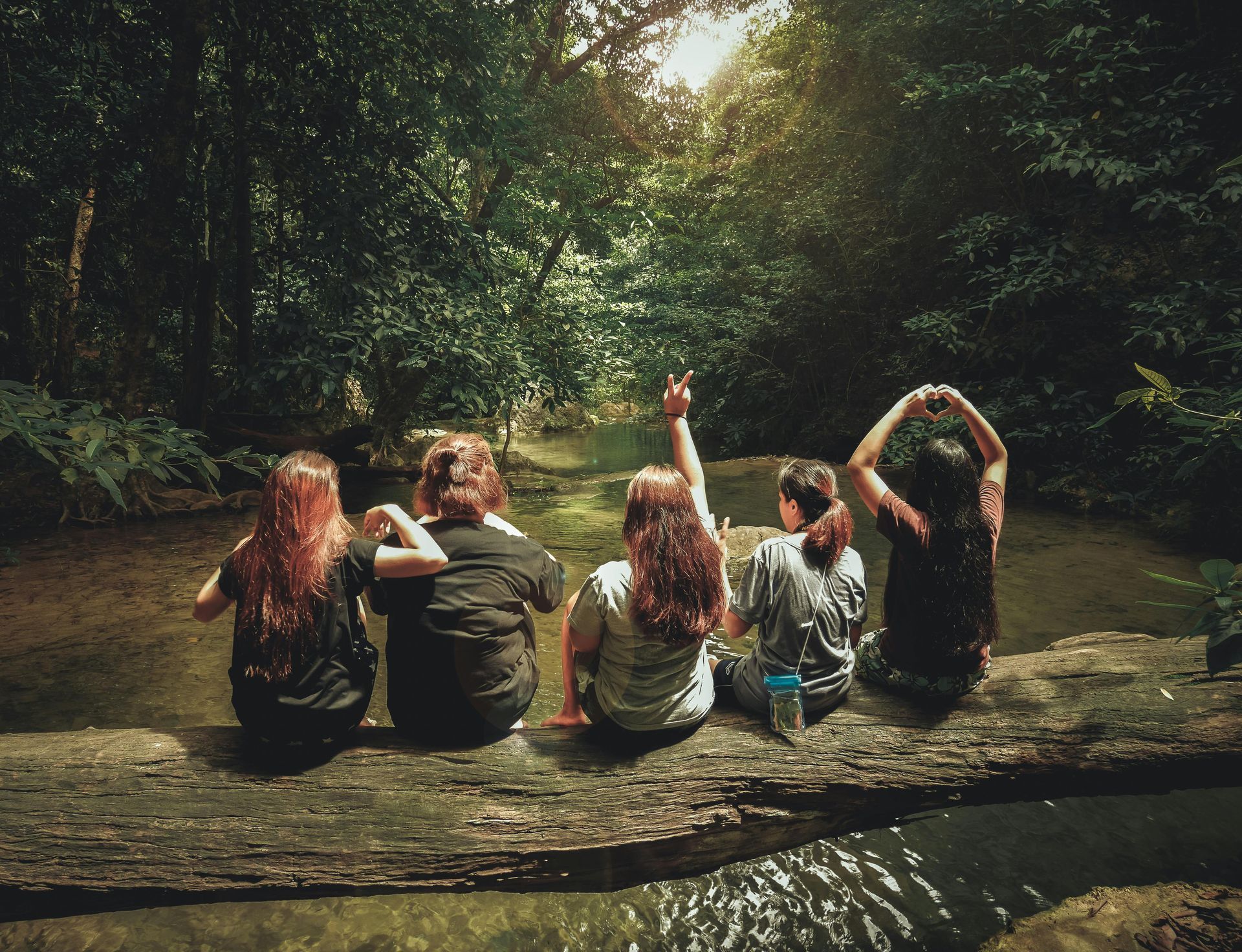
What to Wear On Your Floating Trip on the Illinois River
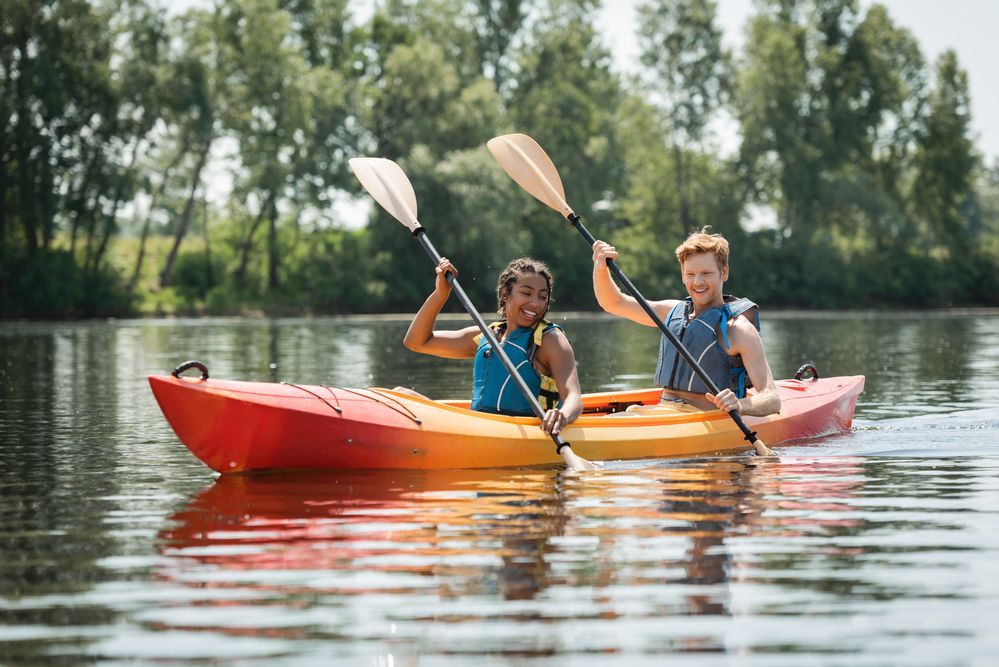
Why Is Kayaking Good For You?
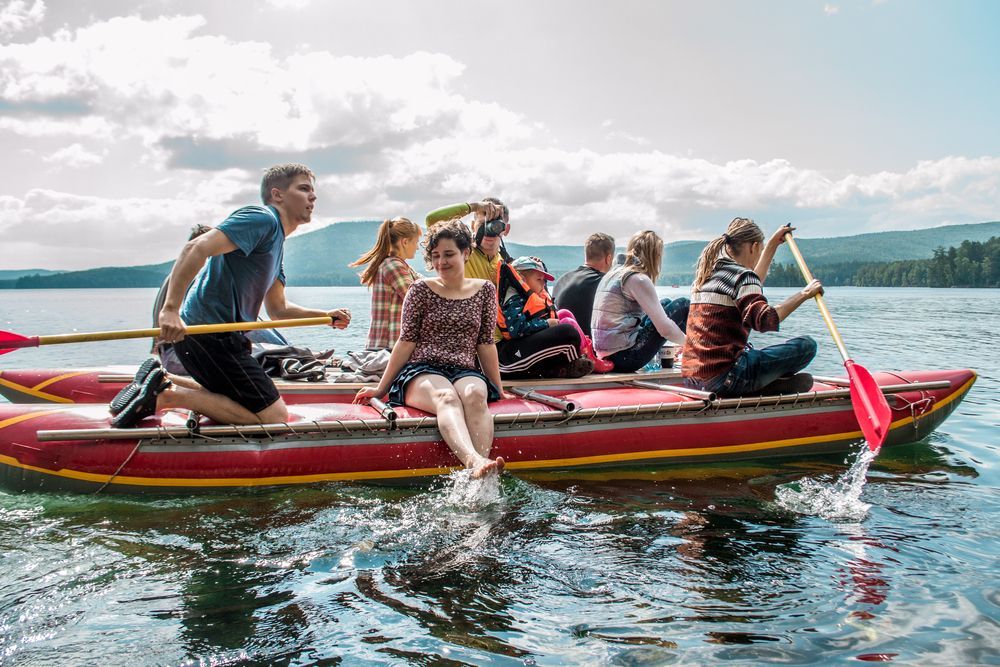
5 Tips To Beat The Heat On A Rafting Trip In Tahlequah

Water Level Safety Guidelines For Float Trips On The Illinois River in Tahlequah

Is An Inner Tube Float Trip More Enjoyable Than Rafting?
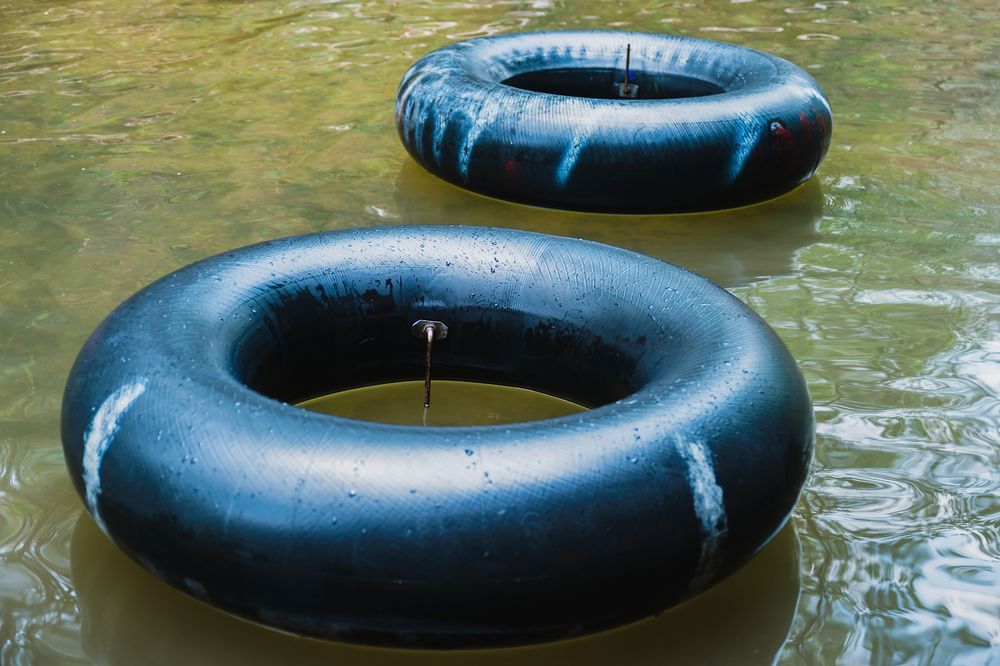
Different Types of Tubes for River Tubing
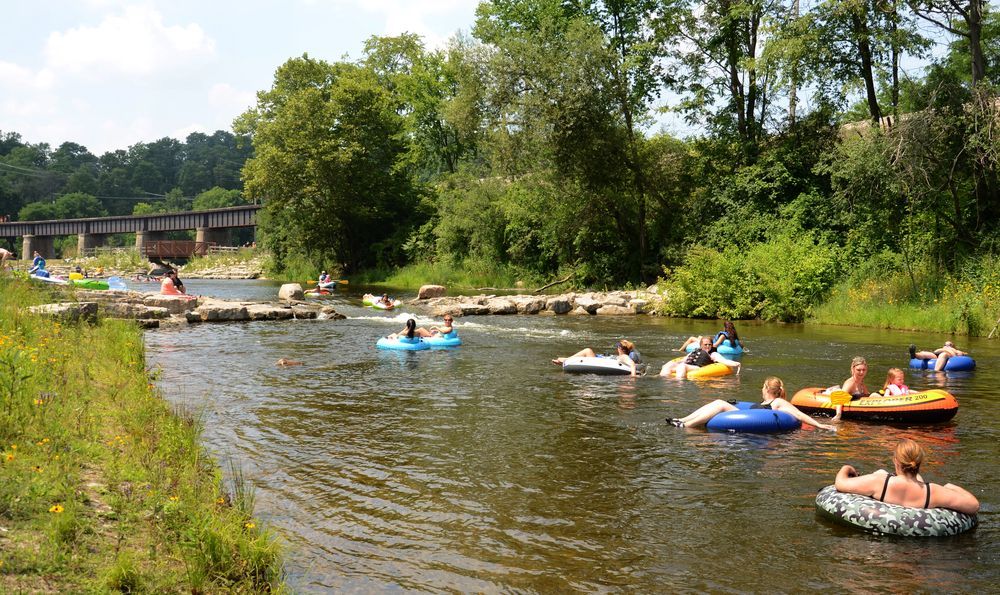
Floater's Guide To Illinois River In Tahlequah
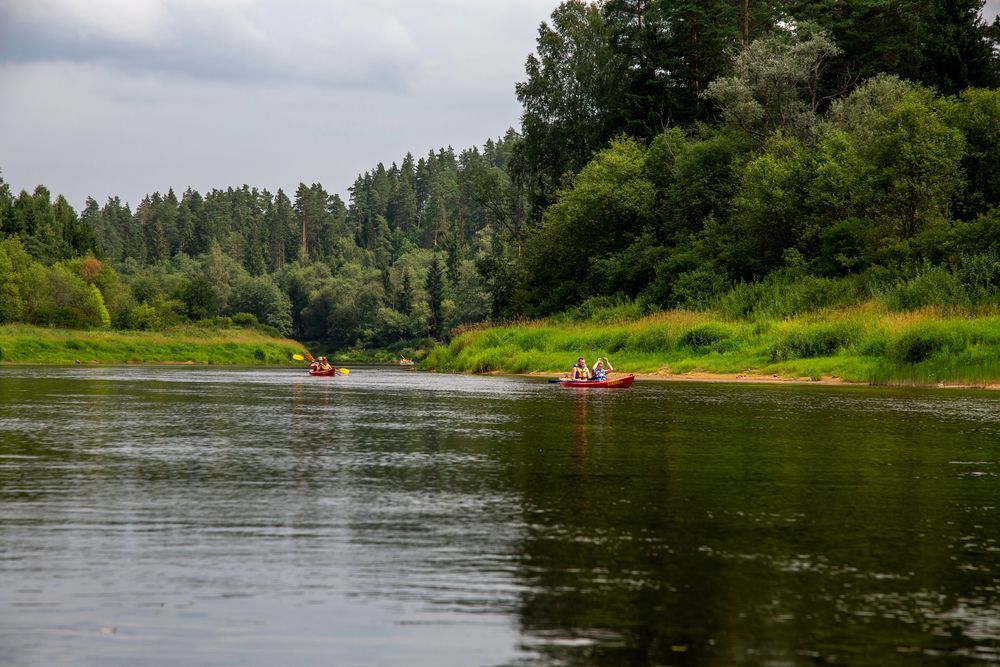
Floating Rules and Restrictions On The Illinois River In Tahlequah
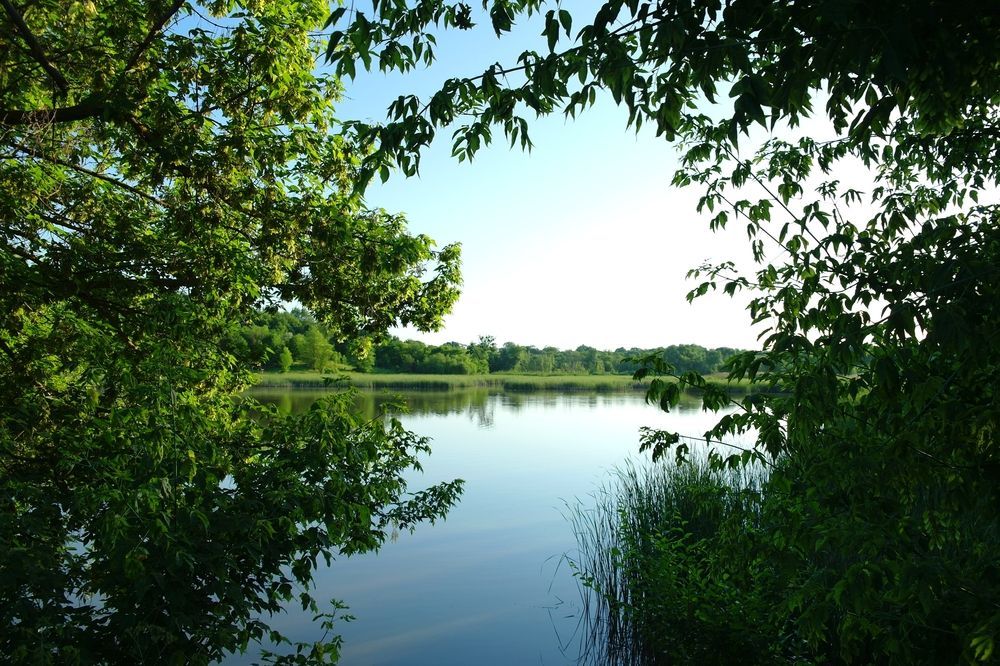
Tahlequah Float History
Quick links, 17252 ok-10 tahlequah ok 74464, business hours.
All Rights Reserved | Riverbend Floats
Powered by Peek.com

This site is protected by reCAPTCHA and the Google Privacy Policy and Terms of Service apply.
Float Trip Food Ideas
Float trips are a great way to bond with friends and family while spending time in nature. However, one of the challenges of float trips is menu planning. You need to make sure you have enough food that everyone will be satisfied, but you also need to be mindful of weight and space constraints. Here are some tips for menu planning for your next float trip.
Pre Packaged Snacks
One way to lighten your load is to plan for mostly trail mix type snacks and easy to eat foods. This way you don’t have to worry about packing a lot of plates and utensils, and you can just snack on the go. Nuts, dried fruit, granola bars, and crackers are all great options for this type of trip.
Protein Packed
Another important consideration when planning your menu is to make sure you have enough protein and energy-rich foods. These are especially important if you will be on the river for a long time or doing more strenuous activities, like canoeing or hiking. Good sources of protein include high-protein bars, peanut butter, jerky, and canned tuna.
Fresh Fruits and Veggies
These can be a great way to add some healthy options to your float trip menu. Packing light is key when it comes to float trips and bringing fresh fruits and vegetables can help with that. Some of the best fruits and vegetables to bring on a float trip include:
– Apples: Apples are great for snacking, either whole or sliced. They are also a great source of fiber and nutrients, making them a perfect choice for any float trip.
– Berries: Whether fresh berries or freeze dried berries, these sweet fruits are the ideal addition to any float trip. They are lightweight and pack a punch of flavor, making them perfect for snacking or adding to other dishes.
– carrots: Carrots are another great source of fiber and nutrients. They can be eaten whole or cut up into sticks for dipping.
– celery: Celery is another excellent option for a healthy and filling snack. It can be eaten whole or cut up into sticks.
– grapes: Grapes are a refreshing and healthy snack option for any float trip. They can be eaten whole or in a fruit salad.
– oranges: Oranges are a great source of Vitamin C and make a refreshing snack on a hot day. They can be eaten whole or in a fruit salad.
– watermelon: Watermelon is a refreshing and hydrating fruit that is perfect for any float trip. It can be eaten whole or in a fruit salad.
Sandwiches & Wraps
Sandwiches and wraps are ideal for float trips because they’re easy to make, store, and enjoy on the go. Whether you’re making something simple like a peanut butter and jelly sandwich or preparing a more elaborate wrap filled with fresh veggies and your favorite filling, these portable meals will make your float trip more enjoyable. There’s no need to worry about packing up a lot of separate ingredients or dealing with perishable items – just make your sandwiches and wraps in advance, then pack them up in a cooler and you’re good to go. Plus, they’ll stay fresh all day long so you can enjoy them whenever you’re ready.
Pasta Dishes
Pasta dishes are another great option for a float trip. One great thing about pasta dishes is that they can be made ahead of time. That means you can spend less time cooking on the trip, and more time enjoying the outdoors. Whether you’re making a simple tomato sauce, tossing your pasta in olive oil and garlic, or using it to make some homemade mac and cheese, there are plenty of great options for enjoying pasta on a float trip. Plus, they’re easy to clean up after you’re done eating. Also, pasta is a complex carbohydrate, which means it takes longer for your body to break it down and convert it into energy. That means you’ll have sustained energy levels throughout the day, rather than a quick burst of energy followed by an inevitable crash.
Stay Hydrated and Have a Great Time!
No matter which foods you choose, it’s important to stay hydrated and well-nourished while on your float trip. With these ideas in mind, you can plan a great meal that will keep you fueled and happy as you enjoy the beautiful scenery of your float trip. So get planning and Bon Appetit!
What are your go-to foods to take on a Float Trip? Leave us a comment below!
Author: Bree
Hi I'm Bree! A camping and travel enthusiast, outdoor lifestyle and adventure reviewer, blogger and writer. Married to my entrepreneur husband Travis and a Happy Camping Mama to our two kiddos Bailey and Peyton. I love being in nature and camping with my friends and family. Follow along on my website for tips on where to go camping, what gear to bring and how to make the most of your time outdoors!
Username or Email Address
Remember Me
You’re Invited!
Are you a member of our private facebook community.

Remember Me
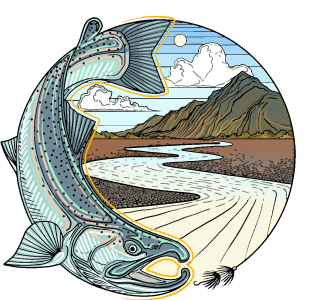
Eating in Style on Your Alaskan Float Trip
How To Travel Light, Eat Well & Leave The Cooler at Home By Kurt Iverson
He surprised us on Day 5 of the trip. We had fished all day through the braids of the river, each of us landing a silly number of rainbows, Dolly Varden, and grayling. We hadn't traveled in the boats much; instead, we mostly shuffled our way downstream, leap-frogging and fishing past one another, with the last guys in line pulling the rafts through. When we finally chose a gravel bar for our campsite, it was 8:30pm. We were bone-tired, but in a good way. Still, there were rafts to unload, tents and tarps to set up, and each of us was a little woozy with hunger. "I'll do dinner," he said. "If one of you dogs can help me with firewood, I'll get right on it."
If you're planning an extended do-it-yourself (DIY) float or tent-based trip in Alaska, an important task will be to put together your menu. Now, we have friends who are perfectly content with coffee and a Power Bar for breakfast, a fresh dip of Copenhagen for lunch, and Hormel canned chili and beer for dinner. And that's all good. We've gone that route ourselves a few times. But nowadays, we're usually more inclined to go up the food scale a bit for our backcountry journeys, without letting the menu get too complicated, expensive, or time consuming to prepare. These are, after all, fishing trips. And while we recognize that putting together a secure camp and sharing some good grub is a big part of the enjoyment, we have to balance those considerations with the time that we want to spend fishing, floating, or just plain relaxing. More often than not, we'll leave the fancy streamside meals to fishing and rafting guides who are getting paid to do such stuff.
That said, we shy away from common mass-produced freeze-dried meals. Again, we don't criticize others who are happy to go that way, and we fully recognize the freeze-dried advantages. It's just that we don't find such meals very… satisfying. And that says nothing about their relative high cost, and the near-certain (ahem) "gastrointestinal" side effects. Instead, we try to put our efforts towards tasty, nourishing meals straight from the grocery store shelves that don't involve a lot of prep time and often don't need much – if any – refrigeration.
It's not uncommon that we decide to forego insulated coolers, because they are heavy and bulky. Plus, a cooler doesn't do you much good unless you bring plenty of ice, which adds even more to the weight and space issues. Sometimes dry ice can be an option, but that presents its own set of complications - not the least of which is that you can't fly with dry ice on commercial airlines, and it's often unavailable in the remote Alaska villages where you begin your trip. Your situation may boil down to the fact that an iced cooler in the Alaska backcountry is a luxury that just isn't worth bothering with. And remember, a certain amount of freshness can be maintained by keeping food out of the direct sun, and on the river-chilled bottom of the boat.
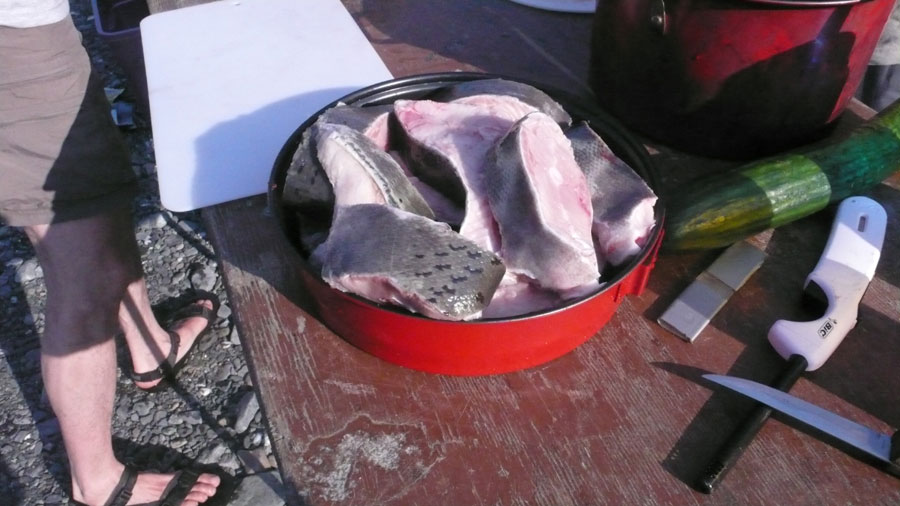
Another important consideration for your float trip menu is that you will have a ready source of protein for the taking nearly every day. Fillet those fish and eat them. Grill them, fry them, cut them up and put them in chowders, and mash the cooked leftovers into sandwich spread - Alaska is a place where you can do this without guilt.
In addition, here are a few other random tips and ideas we've zeroed in on over the years:
- We love long-handled grill baskets. The model we use is designed for cooking fish, but we also find it useful for open-fire cooking of meats and vegetables. The basket's most important use is to easily move food away from hot spots or flare-ups in the cook fire. If you can fit them in, bring grill baskets.
- Vegetables that travel well: potatoes, carrots, onions, garlic, cabbage, cauliflower, and bell peppers. Keep them dry and cool and they'll easily last through your trip.
- A retort pouch is a sealed aluminum foil bag - think of it as a "flexible can". To prepare food stored this way, all you have to do is drop the pouch in hot water (or you can even skip that and eat the food cold). Our favorite brands and flavors of pouched sauces are Curry Simple (any flavor), Kitchens of India (Kidney Bean or Chick Pea Curry), and Tasty Bites (Bombay potatoes). Cooked chicken, smoked salmon, and other seafood also comes packaged in retort pouches, and is equally good. These have become float trip mainstays for us.
- Among the many brands of grocery-store grains and pastas, we find ourselves drawn to the Near East brand of flavored rices and couscous (good for breakfast even), Zatarains red beans and rice, and Knorr cheese pasta or rice side dish mixes. For dried soups, we like the Nile brand for single-serving , "cup of soup" sizes, and for large multiple-serving sizes , we often choose Bear Creek brand, which we find even more appealing if we beef them up with whatever vegetables or protein we have on hand.
Shown below is an actual grub list we used on a 3-person, 7-night float trip in Western Alaska last summer. We travelled on the airlines with the food packed in plastic totes, then we transferred the goods to dry bags for the trip. All the fresh meat products were frozen ahead of time and were packaged in vacuum-sealed pouches. The curry sauces and dried soups were purchased in retort pouches or were factory-sealed in waterproof sacks. The dried goods that weren't already in waterproof sacks - rice, couscous, pasta, breads, etc. - we sealed in ziplock bags before going into the dry bags, a "double bagging", if you will.
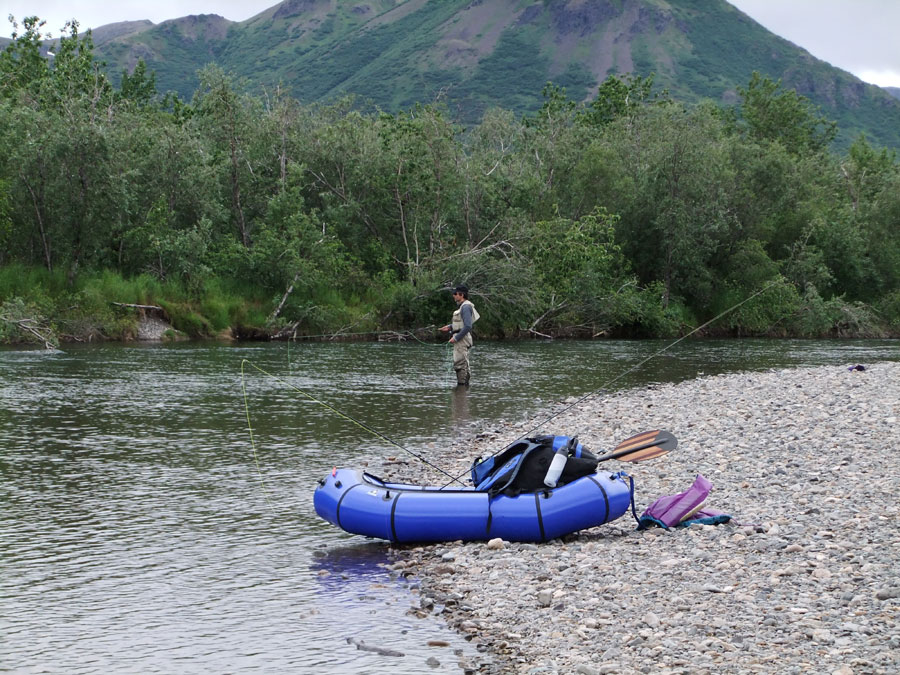
On this particular trip we were travelling relatively light with 1 canoe (2 persons) and 1 pack raft (1 person). We find that for packing small boats, it's best to carry your grub and all other gear in a variety of small bags. Loading the boats is more effective, and it's also easier to stay organized that way. The food bags were organized and labeled by their contents: 1 for canned goods; 1 for vegetables; 1 for dried items; etc. On this trip, we had 2 significant portages, so we also carried 2 large bags for consolidating the small items when had to carry them.
We lived comfortably from this menu. It also included enough food to sustain us for several days in the event that we were weathered in beyond our pick-up date. We offer it up here to help illustrate what we've been talking about, and to maybe help you put together your own float trip choices someday. Keep in mind that this menu was not set in stone. A lot of mix-and-match can – and did - go on. Do you want to make a cole slaw to go with fresh grilled salmon fillets? Chop cabbage and shred carrots, add lemon juice, vinegar, olive oil, salt, and a bit of hot sauce and you've got it. Serve the fillets and slaw with tabouli, and now you have an easy streamside dinner that doesn't appear "on the menu". Also, our lunches were filled out by leftovers, including sandwich spreads made from cooked salmon, mayonnaise, and vegetables.
On a final note, we'd love to hear from you with your own menu suggestions or tips, especially if it relates to the "easy, minimally refrigerated, and satisfying-and-sustaining" tack that we've tried to take here. Salud!
Share This Story, Choose Your Platform!
How did you store food at night to avoid the bears and critters?

FROM THE AUTHOR: The most secure way to store food on a float trip is with bear-resistant containers. We have used a variety of containers over the years, including smooth plastic kegs and cannisters, aluminum dry boxes, metal barrels, and certified bear-resistant coolers.
Note that in most National Parks, including Katmai Park in Alaska (where there is excellent fishing), bear-resistant containers for food and garbage are required. A reference for various types of containers that are endorsed for backcountry use by the Parks Service can be found here:
http://igbconline.org/certified-products-list/
We are also fans of electric fences when we travel in bear country. Our most common strategy is to set up our camp tarp and cook area away from our tents, then rig the electric fence to surround the tarp / cook site. We store the food and garbage Inside the fence perimeter.
Thanks for the awesome tips!! Very helpful!
Leave A Comment Cancel reply
Save my name, email, and website in this browser for the next time I comment.
Related Articles
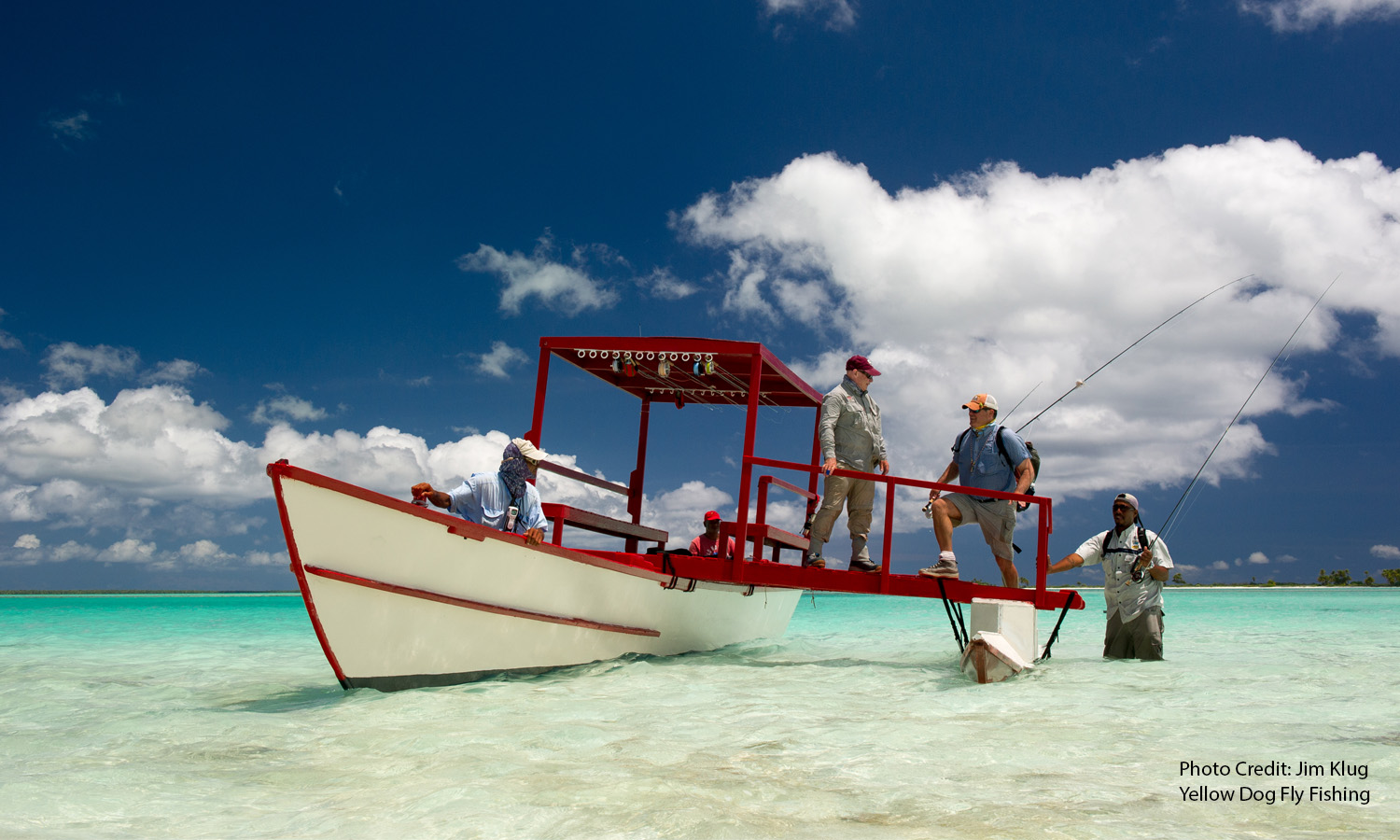
Christmas Island – A Complete How-to Fly Fishing Guide
Introduction On a wet chilly day looking out the window at work you can easily imagine it. The water is a shade of […]
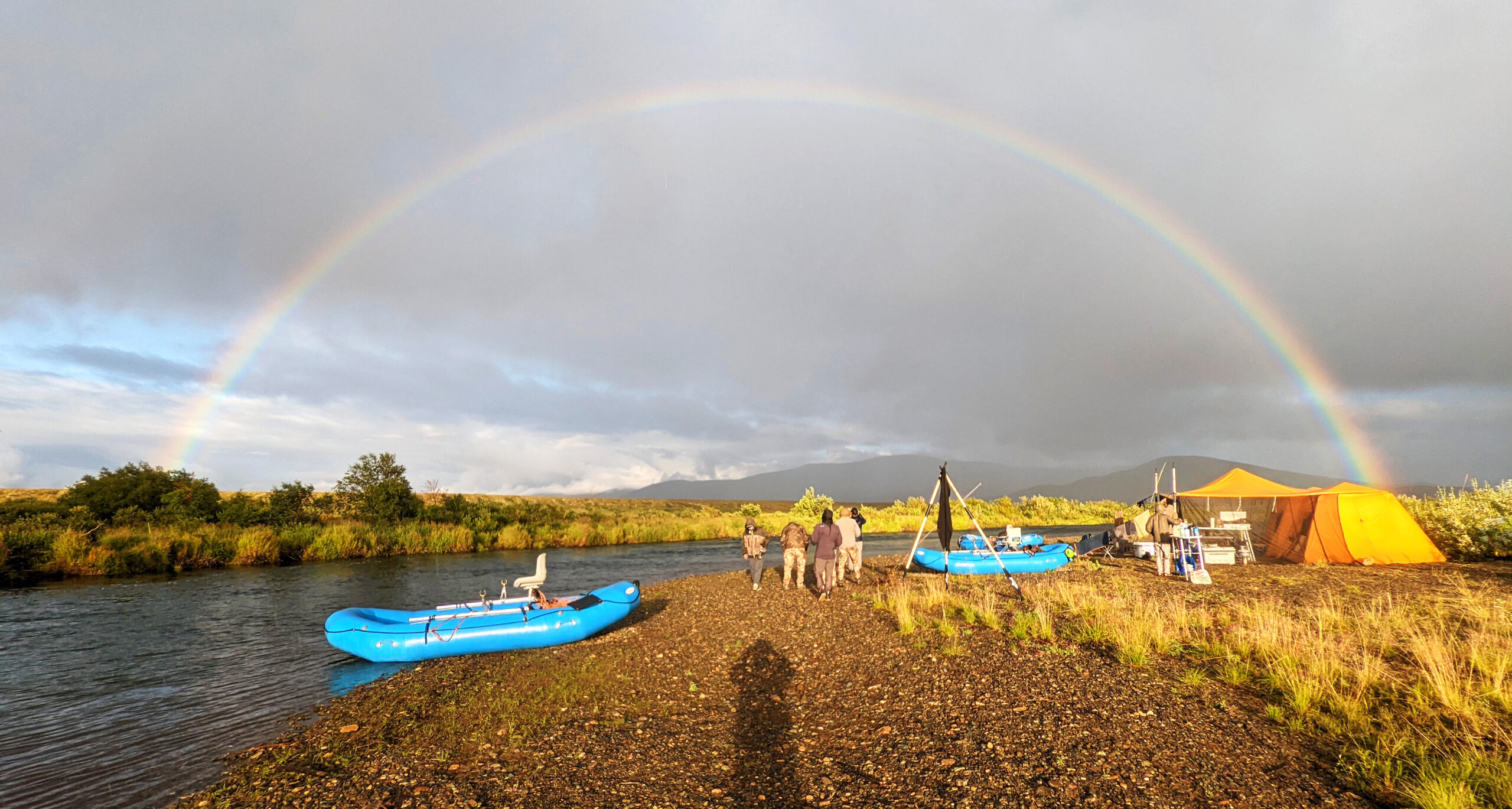
The Do It Yourself Float Trip
It’s hardest in the beginning: often cold and wet, but that is part of the challenge and fun of a do it yourself […]

Steelhead on Alaska’s Situk River
Why Go? If we had to pick a dream river to fly fish for steelhead, it would be the Situk river in southeast […]
Spring Hours: Monday – Friday 10AM – 6:00PM. Saturday 10AM – 5PM. Sunday Noon – 5pm. Orders are shipping daily.

Canoe Trip Meals 101: Discover the Best Canoe Camping Meals
Canoe camping, also known as backcountry camping, is an adventure where you travel by canoe to a remote destination to find your campsite.
Unlike car camping, canoe camping involves being out in the wild with limited resources . There is no running water or electricity, meaning you must bring everything you need to make your canoe trip meals, including all cooking gear.
It is critical to plan your canoe camping meals to ensure you pack enough food to last your whole trip without carrying too much weight.

For all my camping trips over the years , I came up with canoe trip food ideas according to the trip duration, dietary requirements within the group, and the resources available.
For example, while on a yurt camping trip in Tobermory , we could use a BBQ and cooler. However, on backcountry camping trips in Algonquin Park , we had no equipment except for the fire we made and a camping stove. Therefore, I have come up with plenty of ideas for food to bring camping with no cooler.
Therefore, this article will take a look into the necessary preparation required for canoe trip meals.
If you are planning a canoe trip, make sure you check out my backcountry camping guides – you can find all my other camping articles here.
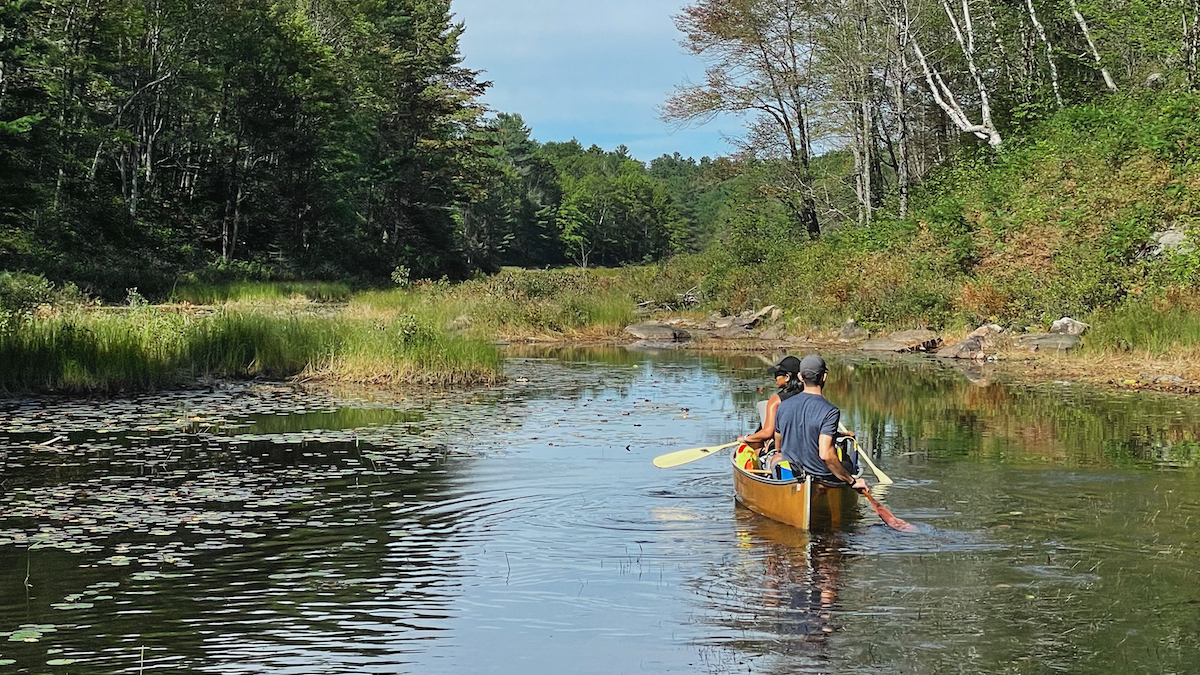
FREE Canoe Camping Packing List
Sign up to receive your free checklist to prepare you for your next backcountry camping trip.
Thanks for signing up!
You will receive an email with your freebie in the next 10 minutes.
Important Considerations for Planning Your Canoe Trip Menu

You need to keep your body nourished during a canoe trip so you have enough energy to paddle and hike throughout your camping adventure.
It is important to bring foods that are high in energy , but also non-perishable . You also want to stay fuelled on your canoe trip, but still be able to carry the weight.
There are several important considerations to help you choose your backpacking foods. These include the trip duration, the equipment available, the amount of food you want to consume, and any dietary restrictions.
Trip Duration
Trip duration is important to consider when preparing your canoe camping menu because it determines the amount and type of food you need to bring. The longer the trip, the more food you will need to pack.
However, if your backcountry camping trip exceeds three days, you should bring dehydrated meals and non-perishable snacks. This type of camping food is the lightest and will not spoil.
If you are going backcountry camping, bring a camping stove that is fully operable in the wilderness.
At some campsites, you can use the fire pit to cook some food. However, it is not always possible to use a fire pit due to fire restrictions or wet weather conditions. Therefore, you need to be prepared for all occasions.
Read about what else to pack for a backcountry camping trip in this article.
Amount of Food

The amount of food you need to bring depends on how many people are in your group, the number of meals and snacks you plan to eat each day, how much you can carry, plus the duration of your trip (as previously discussed).
On all my camping trips, we eat three full meals a day , plus snacks , and sometimes a dessert . Our food barrel is heavy at the start of the camping trip, and it reduces in weight over the days as eat the food.
However, our trips rarely last longer than three days; therefore, we can get away with using fresh food at the start.
For the latter part of the trip, we rely on foods that do not require chilling, such as cured meats and dried vegetables.
While it may be tempting to bring a light menu for your camping trip, you should consider the amount of physical activity you will be doing. You will likely be expending a lot of energy while paddling and need extra food to keep your energy levels up.
Dietary Restrictions
Before planning your canoe trip meals, check with all group members if they have any dietary restrictions. It is usually easier for all members to eat the same diet , rather than packing separate meals.
For example, if you have a group member who needs a gluten-free diet, bring gluten-free pasta for the whole group, or opt for a naturally gluten-free alternative, such as rice or quinoa.
Otherwise, you can bring dehydrated foods that each member has chosen to suit their requirements.
Picking the Right Food for Canoe Trips

As explained previously, the best foods for camping are non-perishable, lightweight, and high-energy foods.
When camping menu planning, remember that space and weight are limited .
Packing compact and nutrient-dense foods is critical, so consider foods that are easy to prepare, such as dehydrated or freeze-dried meals, and snacks like trail mix and energy bars.
Carbohydrates are particularly important because they provide the body with energy for physical activity. Good sources of carbohydrates include pasta and rice.
Finally, consider the perishability of the food you bring.
Foods prone to spoilage, such as fresh fruits and vegetables, may not be suitable for long canoe trips. Instead, consider dried fruits and vegetables. Additionally, bread is a good carbohydrate, but it is bulkier and will expire quicker than rice or pasta.
Non-Perishable Camping Meals

Non-perishable food items are those that can be stored at room temperature for an extended period without spoiling. This is important because you will not have access to refrigeration on a backcountry camping trip.
Suggestions for Non-Perishable Canoe Food
Here are some of the best canoe trip meals and snacks that are quick to prepare and and lightweight to carry.
- Peanut butter and jam/jelly wraps
- Instant oatmeal packets – good canoe trip breakfast option
- Packaged pasta kits (e.g. just add water mac & cheese)
- Instant noodles
- Granola bars
- Energy bars
Dehydrated Meals for Camping Trip
Dehydrated meals are a great option for canoe camping due to their convenience, ease of preparation, and portability. They are cooked using boiling water , which is suitable for those who want a hot meal without too much preparation time.
Dehydrated meals also have a long shelf life and are non-perishable, making them ideal for longer canoe trips where fresh food is not a viable option.
You can also purchase freeze-dried meals.
Recommended Brands for Dehydrated Meals

I have tested and recommend the following brands of dehydrated meals:
• Firepot • Peak Refuel • Mountain House • Backpacker’s Pantry • Good To Go • Alpine Aire
Dehydrated Meal Recommendations
If you are looking for specific canoe camping food ideas, here are some of my favourite dehydrated meals.
Dairy-Free Camping Meals

If you are lactose-intolerant , it is a good idea to take this seriously while backcountry camping, given the lack of facilities.
It is possible to bring lactose-enzyme products (such as Lactaid) , but it is easier to plan a canoe trip menu that lacks dairy.
A dairy-free camping menu is also beneficial to avoid any bloating or discomfort.
You can swap out cheese with nutritional yeast to give a similar flavour in foods like homemade pesto that would normally include parmesan (as shown in the adjacent image).
Suggested Dairy Free Camping Meals and Snack Ideas
Here are some canoe trip meal ideas that are dairy-free or lactose-free.
- Oatmeal, dried fruit, and nuts (great breakfast option)
- Hummus and veggie wraps
- Pasta with tomato sauce
- Beef stir-fry or fajitas (for the first day of camping)
Suggested Canoe Camping Recipe
Below is one of my favourite canoe trip recipes that makes a great dinner choice.
Given the non-perishable ingredients used, it is a good option for the latter part of your canoe trip if you plan to cook all your meals from scratch. Alternatively, it is a good choice for your first day of camping if you eat dehydrated meals later in the camping trip to travel light.
Sun-Dried Tomato and Chorizo Orzo
For two people
- 3/4 cup orzo (uncooked) – use quinoa for a gluten-free substitution
- 100g of cured chorizo – (or between ½ to 1/3 of the package and use the rest for wraps/sandwiches/eggs)
- 6 pieces of sun-dried tomatoes – (not in oil)
- 1 stock cube – one is good for 2 to 4 people (chicken is my favourite)
- Splash of olive oil (bring a small portion in a portable container)

You can scale the recipe up for additional people.
- Gently heat a splash of oil in a pot or saucepan.
- Add diced chorizo to the pan and allow it to sweat.
- Add the dried orzo and stir until the orzo is coated in the oil from the chorizo.
- Add in chopped sun-dried tomato.
- Add purified drinking water along with the stock cube (use double the water to orzo). Stir until the stock cube dissolves.
- Let it cook for around 10 minutes. Turn off the burner once the water is soaked up and the orzo is soft.
Equipment Required for Recipe
- Saucepan ( stove and cookware bundle available here )
- Folding stirring spoon/spatula ( camping utensil set available here )
- Chopping board
- Insulated mug/jug
- Camping stove
- Camping plates/bowls
- Small oil container
Preparing Your Canoe Camping Meals

Read on to learn more about how to pack food for camping to be efficient and organised.
Your canoe camping menu should be based on the equipment you will be bringing with you.
Do not pack food that requires chilling unless you have a cooler, which is not recommended when backcountry camping .
Alternatively, you can freeze some of your protein , such as chicken or beef, so it stays chilled and will slowly defrost during day one of the trip. With this, you can eat some fresh food on your first night of camping.
Typical equipment for a backpacking camping trip includes a portable stove, fuel, saucepan, frying pan, utensils (forks, knives, spoons), and a sharper knife for cutting.
You should also pack the following items: biodegradable dish soap , a sponge, and trash bags. These items will assist with proper cleaning and waste disposal.
Check out this stove and cookware bundle (including Sauce Pan, Deep Dish Bowls, two Insulated Mugs, Strainer Lid, and two Folding Sporks) and this camping utensil set (including Folding Spoon, Spatula, Ultralight Cutting Board, Salt & Pepper Shaker, Squeeze Bottle and Dish Towel).
Read this article on packing for a backcountry camping trip to guarantee you pack all the essentials.
No Cooler Camping Meals
One of the biggest challenges of planning meals without a cooler is that you should select foods that will not spoil without refrigeration. Many fresh foods, such as meats, dairy products, and some vegetables, are not recommended for camping.

Without the ability to store meats and dairy products, you may need to rely on canned or dried proteins like beans or cured meats.
Pack some meal and snack options that do not require refrigeration, such as:
- Instant ramen noodles
- Canned soups and stews
- Pasta with chorizo and sun-dried tomatoes (see the above recipe)
- Peanut butter sandwiches
- Dried fruit and nut mix
- Dehydrated meals
- Crackers or rice cakes
What are Good Snacks for Camping?
- Trail Mix (including nuts and seeds)
- Granola Bars
- Fresh Fruit, such as apples
- Dried Fruit, such as apricots
- Energy chews or bars (Honey Stinger Organic Energy Chews or Clif Bloks Energy Chews)
Staying Hydrated While Canoe Camping

It is important to replace the fluids lost while sweating from physically demanding camping activities.
Adding electrolyte tablets to your water bottle will help you replenish electrolytes and other fluid requirements to ensure hydration.
Nuun Electrolyte Tablets are my favourite brand and are available in Canada and the United States. I like grape and lemon-lime flavours.
Make sure you use treated, potable water . See the methods below for how to accomplish this while camping.
Water Treatment Methods for Canoe Camping

During most backcountry camping trips, you need to find water to drink, meaning you will collect water from natural water sources, such as lakes or rivers.
You cannot drink the water directly from a lake because you can get beaver fever ; therefore, you must treat the water first.
The two most common ways of treating water are by water gravity bag or water purification tablets.
Water Gravity Bag
A water gravity bag works by using gravity to filter water through a filter cartridge, removing bacteria and other contaminants.
This method is easy to use; however, it is the more expensive option.
Water Purification Tablets
Water filtration tablets use a chlorine solution to kill bacteria in the water. This method is cheaper and easy to carry but can make the water taste “off”.
Storing and Transporting Food
There are numerous methods for storing food that to keep yourself safe while camping. The following tips will help you avoid attracting wildlife while camping and efficiently pack your food.
1. Use Bear-Safe Storage Containers

Firstly, store your food products in bear-resistant containers.
You can use a food barrel , a bear bag , or a bear canister .
Certain containers can be hung from a tree, which makes it more difficult for a bear to get hold of its contents.
Otherwise, store your canister at least 30 metres (100 feet) from your campsite . The containers are designed to be difficult for bears to open.
Canoe Camping Food Storage Options
• Food Barrel • Bear Bag • Bear Canister
2. Pack Fewer, Larger Bags
Pack your items in as few storage containers as possible to help with transporting your food.
If you need to portage (carry your canoe and camping belongings to the next stretch of water), it will be easier with fewer, big items to carry. Plus, it can help when distributing the weight of items within the canoe.
3. Keep Odours Contained
Within the containers, it is good practice to keep individual food items and toiletries that are scented in sealed bags to minimise smells.
For example, once you have opened a package of cured meats, reseal it in a Ziplock bag.
4. Keep Your Campsite Clean

Ensure your campsite remains clean by securing waste in a plastic bag and placing that in your bear-proof container. You also need to wash your cooking and eating utensils straight after mealtimes.
Do your dishes away from your main camping area and dispose of the water in a hole away from water sources. You do not want to contaminate lakes or rivers with your dirty dishwater.
You can do this using a collapsible sink .
Conclusion – Canoe Trip Food
In conclusion, meal planning for canoe camping can be challenging, but you will be glad you put in the preparation.
Dehydrated meals, along with other non-perishable and no-cook options, are convenient choices for backcountry trips. The main benefits of dehydrated meals are that they help to keep your bags light and feed you nutritious, warm meals no matter how long your camping trip is.
It is important to pack out all your trash and food waste to keep the campsite clean and preserve the wilderness. Adhering to the Leave No Trace principles is essential for responsible camping, which ensures minimal environmental.
So, be mindful of what you pack, respect the environment , and enjoy the canoe camping with delicious meals.
Samantha is the founder of Continuous Roamer, a travel website focusing on adventure and the outdoors.
With a love for adventure and the great outdoors, Samantha shares tips on skiing, luxury safaris, camping, and finding hidden food gems in different destinations.
With over 20 years of skiing experience across Europe, North America, and beyond, she's also an expert in luxury accommodations and experiences.
Whether camping in Canada or dining in a Michelin-starred restaurant, Samantha always seeks out the best experiences and accommodations, and her blog highlights the best of them for her readers.
Samantha is currently living in London.
Similar Posts

Magnetawan Lake Access: How to Plan Your Backcountry Adventure
Ontario Canada has some of the best camping locations in North America because Ontario is home to the magnificent Algonquin…

Complete Guide to Algonquin Portages & Backcountry Camping
As someone who has spent the past four summers embarking on numerous backcountry camping trips in Algonquin Park, I have…

Rock Lake Algonquin: First-Time Backcountry Camping Guide
Rock Lake Algonquin Park in Ontario, Canada is a beautiful destination for backcountry camping in Ontario. It was the first…

Yurt Camping Tobermory: Everything You Need to Know For a Memorable Trip
Before I went yurt camping in Tobermory I tried to do some research online. Other than what Parks Canada, the…

Canoe Trip Pack List: 62 Essentials for Backcountry Camping
Are you planning a backcountry camping trip in North America this summer? I have been on several canoe trips in…
The Ultimate Guide To Packing Food For A Memorable Float Trip
- Last updated Dec 09, 2023
- Difficulty Advanced
- Category United States
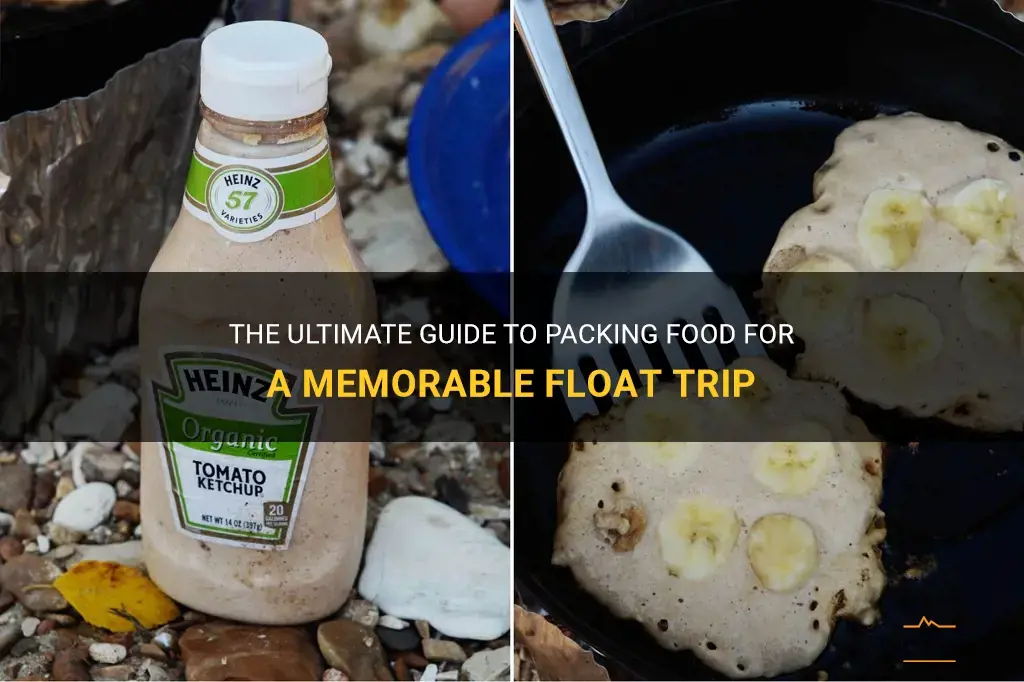
Are you planning a float trip with your friends or family? One of the most important aspects of a successful float trip is having delicious and convenient food to enjoy while you're on the water. But how do you pack food for a float trip without it spoiling or getting soggy? Fear not! In this ultimate guide, we will explore different packing techniques, food ideas, and storage solutions to ensure that your float trip is not only memorable, but also filled with tasty treats to keep you fueled and happy. So grab your cooler and get ready to learn the secrets to packing food for a memorable float trip!
What You'll Learn
What are some non-perishable food options that are ideal for packing on a float trip, are there any specific dietary restrictions or allergies that need to be considered when choosing food for a float trip, how can i ensure that the food i pack for a float trip will stay fresh and safe to eat, are there any convenient and easy-to-eat snacks that are recommended for a float trip, what are some recommended meals that can be prepared ahead of time and easily enjoyed during a float trip.

When going on a float trip, it's important to pack enough food to keep you fueled and satisfied throughout your journey. However, the challenge lies in finding foods that won't spoil in the heat and can withstand rough handling. Non-perishable foods are the perfect solution for float trips, as they can be stored without refrigeration and remain edible for an extended period of time. Here are some non-perishable food options that are ideal for packing on a float trip:
- Canned meats: Canned meats like tuna, chicken, and spam are a good source of protein and can be easily incorporated into meals. They can be eaten straight out of the can or mixed with other ingredients to create sandwiches or wraps. Just make sure to pack a can opener to easily access the contents.
- Dried fruits and nuts: Dried fruits and nuts are excellent sources of essential vitamins and minerals, and they provide a quick energy boost. They are lightweight and compact, making them easy to pack. You can pack a variety of dried fruits such as raisins, apricots, and cranberries, along with nuts like almonds, cashews, and peanuts. They can be eaten as snacks or added to trail mix for a more substantial meal option.
- Crackers and hardtack: Crackers and hardtack are dry biscuits that have a long shelf life. They are sturdy and won't easily break or crumble, making them perfect for a float trip. You can spread peanut butter, cheese, or canned meats on them for a quick and easy snack or meal. They can also be used as a side to complement other dishes.
- Jerky: Jerky is a popular choice among outdoors enthusiasts due to its long shelf life and high protein content. It can be made from various types of meat, such as beef, turkey, or even wild game. Jerky is lightweight, portable, and doesn't require any cooking or preparation. It makes for a tasty and satisfying snack during a float trip.
- Instant noodles and rice: Instant noodles and rice packets are convenient meal options for a float trip. They are lightweight, easy to prepare, and come in a variety of flavors. All you need is boiling water, and within minutes, you'll have a warm and filling meal. You can also add canned meats or vegetables to enhance the flavor and nutritional value.
- Energy bars: Energy bars are specifically designed to provide a quick and convenient source of energy. They are packed with carbohydrates and can include other nutrients like protein and fiber. Energy bars are compact, lightweight, and don't require any preparation, making them an ideal snack option during a float trip.
Remember to pack enough non-perishable food to sustain you throughout your float trip. It's also essential to pack them in sealed, waterproof containers to protect them from water damage. With these non-perishable food options, you can enjoy a delicious and hassle-free meal while exploring the great outdoors.
The Essential Packing List for a Stress-Free Cruise Vacation
You may want to see also
When planning a float trip, it is important to consider the dietary restrictions and allergies of all participants to ensure a safe and enjoyable experience. Whether you are organizing a float trip for a group or going on one yourself, taking the time to think about food choices can make a big difference in everyone's comfort and well-being. In this article, we will discuss some common dietary restrictions and allergies that need to be considered and provide guidance on how to choose food that accommodates these needs.
One of the most common dietary restrictions is vegetarianism or veganism. Vegetarians do not eat meat, while vegans avoid all animal products, including meat, dairy, eggs, and honey. It is essential to plan meals that offer a variety of plant-based protein sources such as beans, lentils, tofu, and tempeh. Packaged vegetarian or vegan options like dehydrated meals specifically designed for outdoor enthusiasts can also be a convenient choice. It is important to check the ingredients and ensure they are suitable for the specific dietary needs.
Another common dietary restriction is gluten intolerance or celiac disease. People with celiac disease cannot tolerate gluten, which is found in wheat, barley, and rye. When planning meals for individuals with gluten intolerance, it is important to choose gluten-free ingredients such as rice, quinoa, corn, and potatoes. Many outdoor food brands now offer gluten-free options, but it is crucial to double-check the packaging to confirm that it is free from gluten and processed in a dedicated gluten-free facility to avoid cross-contamination.
Some people may have nut allergies, which can be severe and potentially life-threatening. In such cases, it is crucial to avoid any food that contains nuts or may have come into contact with them. This means carefully reviewing packaged food labels and avoiding any products that state "may contain nuts" or "processed in a facility that handles nuts." It is also important to educate all participants about the severity of nut allergies and ensure that proper precautions are taken to prevent cross-contamination, such as using separate utensils and avoiding any shared containers or serving dishes that may come into contact with nut-containing foods.
For individuals with specific allergies, such as those to seafood, dairy, or eggs, it is also important to select food options that do not contain these allergens. This may involve planning meals that are free from these ingredients or providing alternative options for individuals with allergies. It is important to communicate with all participants beforehand to understand their specific allergy needs and make appropriate arrangements.
When choosing food for a float trip, it is also important to consider the storage and preparation options available. For longer trips, it may be necessary to pack non-perishable food items such as dried fruits, nuts, granola bars, and canned goods. If there are cooking facilities available, it opens up more options for fresh fruits and vegetables, meats, and other perishable items. It is important to keep food properly refrigerated or stored in coolers to prevent spoilage and maintain food safety.
In conclusion, there are numerous dietary restrictions and allergies that need to be considered when choosing food for a float trip. By taking the time to understand the needs of all participants and planning accordingly, you can ensure a safe and enjoyable experience for everyone involved. Whether it involves selecting vegetarian or gluten-free options, avoiding specific allergens, or packing non-perishable food items, careful planning can make all the difference in ensuring a successful float trip.

Essential Items to Pack in Your Survival Backpack
Heading: How can I ensure that the food I pack for a float trip will stay fresh and safe to eat?
Introduction:
When planning a float trip, it is important to ensure that the food you pack stays fresh and safe to eat throughout the trip. Proper food handling and storage techniques can prevent foodborne illnesses and keep your meals enjoyable. This article will provide you with some scientific and practical tips to ensure the freshness and safety of the food you pack for your float trip.
Plan your menu and pack accordingly:
Before heading out on your float trip, plan your meals carefully. Consider the duration of your trip, the number of people, and the types of activities you will be doing. Pack foods that have a long shelf life and do not require refrigeration. Canned goods, dry goods, and sealed packets are good options. Limit perishable foods that can spoil quickly.
Use insulated coolers and ice packs:
If you plan on bringing perishable items such as meat, dairy products, or fresh fruits and vegetables, invest in a good quality cooler and ice packs. Insulated coolers help maintain the temperature of your food and keep it fresh for a longer period. Freeze your food and ice packs before packing them in the cooler to ensure maximum freshness. Use separate coolers for raw meat and ready-to-eat foods to prevent cross-contamination.
Practice proper food handling:
Wash your hands thoroughly with soap and water before handling any food. Use clean utensils, cutting boards, and food storage containers. Avoid touching the food with your bare hands to minimize the risk of contamination. When handling raw meat, keep it separate from other foods and cook it thoroughly to kill any bacteria that may be present.
Keep food out of direct sunlight:
During your float trip, avoid exposing your packed meals to direct sunlight. The heat can accelerate bacterial growth and spoil your food. Keep your coolers in shaded areas and cover them with a blanket or tarp to provide additional insulation. If possible, keep your coolers covered with wet towels to create a cooling effect.
Stay organized and rotate your food:
To ensure freshness, organize your food items in the cooler based on their expiry dates. Place the food that needs to be consumed first towards the top so that you can easily access it. As you consume your packed meals, regularly rotate your food to ensure that older items are consumed first.
Dispose of perishable leftovers:
If you have any perishable leftovers after a meal, it's better to dispose of them rather than try to save them for later. The risk of spoilage increases as the food stays unrefrigerated for an extended period. It's always better to prioritize food safety over saving money.
Let's say you are planning a two-day float trip with three other people. Based on your menu plan, you decide to pack canned tuna, peanut butter, bread, dry pasta, canned beans, packaged snacks, and a few fresh fruits. You also pack a separate cooler with frozen meat for a barbecue dinner on the first night. Before leaving, you freeze the meat and ice packs overnight and place them in the cooler along with the other non-perishable items. During the trip, you keep the coolers shaded and covered with wet towels to maintain maximum freshness. As you consume your meals, you rotate the food items to ensure that the older items are consumed first. By following these steps, you can enjoy fresh and safe meals throughout your float trip.
Ensuring the freshness and safety of the food you pack for a float trip is crucial to avoid foodborne illnesses and enjoy your meals. By planning your menu, using insulated coolers, practicing proper food handling, keeping food away from direct sunlight, staying organized, and disposing of perishable leftovers, you can have a worry-free and enjoyable culinary experience on your float trip. Remember to prioritize food safety at all times to protect yourself and your fellow floaters.
Essential Items to Pack for Travel Baseball Games
When going on a float trip, it is important to have snacks that are convenient and easy to eat, as well as provide the necessary energy to sustain you throughout the day. Whether you are rafting, kayaking, or canoeing, having the right snacks can make your experience much more enjoyable. Here are some recommended snacks that are perfect for a float trip:
- Trail mix: Trail mix is a classic snack that is perfect for outdoor adventures. It is a mix of nuts, dried fruit, and sometimes chocolate or other sweet treats. Trail mix is lightweight, easy to pack, and packed with nutrients and energy.
- Jerky: Jerky is another excellent snack option for a float trip. It is high in protein, which helps to keep you satisfied and energized. Beef, turkey, and even vegan jerky options are available, so you can choose the one that best suits your dietary needs.
- Energy bars: Energy bars are a convenient and easy-to-eat snack option that can provide a quick burst of energy. Look for bars that are high in protein and fiber and low in added sugars.
- Fresh fruit: Fresh fruit is a refreshing and healthy snack option for a float trip. Apples, oranges, and grapes are all easy to pack and eat on the go. They also provide essential vitamins and minerals to keep you hydrated and nourished.
- Sandwiches or wraps: If you prefer something more substantial, packing sandwiches or wraps can be a great option. Choose ingredients that won't spoil easily, such as peanut butter and jelly, turkey and cheese, or hummus and vegetables. Pack them in airtight containers to keep them fresh.
- Cheese and crackers: Cheese and crackers are a simple and tasty snack that can easily be enjoyed while floating down the river. Choose hard cheeses that won't melt easily, such as cheddar or Swiss, and pair them with whole grain crackers for added fiber and nutrients.
- Hydration: It is also essential to pack enough water to stay hydrated throughout your float trip. Dehydration can lead to fatigue and other adverse effects on your body. Consider bringing a reusable water bottle or hydration pack to ensure you have access to clean water throughout the day.
When planning your snack options for a float trip, it is important to consider the duration of your trip and the activities you will be engaging in. Choose snacks that are easy to eat on the go, require minimal preparation, and can withstand varying temperatures. It is also important to pack your snacks in a way that keeps them fresh and protected from water, such as using waterproof bags or containers.
In conclusion, there are many convenient and easy-to-eat snacks that are recommended for a float trip. Trail mix, jerky, energy bars, fresh fruit, sandwiches or wraps, cheese and crackers are all excellent options. Remember to also pack enough water to stay hydrated throughout your trip. By planning and packing the right snacks, you can ensure a fun and enjoyable float trip experience.
What to Pack for Your Trip to Refugio Amazonas
Planning meals for a float trip can be challenging, as you need something that can be prepared ahead of time and easily enjoyed while on the water. Float trips typically involve spending several hours or even days on a river or a lake, so it's important to have meals that are convenient, nutritious, and able to withstand the elements.
Here are some recommended meals that can be prepared ahead of time and easily enjoyed during a float trip:
Sandwiches and Wraps:
Sandwiches and wraps are a classic choice for a float trip because they are easy to make and can be packed with a variety of fillings. Opt for sturdy bread or tortillas that can withstand being squished in a cooler or backpack. Some filling ideas include deli meats, cheeses, lettuce, tomatoes, and spreads like mayonnaise or mustard. You can also prepare vegetarian options with roasted vegetables, hummus, and falafel.
Pasta Salads:
Pasta salads are a great option as they can be made ahead of time and enjoyed at any temperature. Cook your favorite pasta, such as penne or rotini, and toss it with a variety of vegetables, such as cherry tomatoes, cucumbers, bell peppers, and olives. Add some protein by including diced chicken, shrimp, or cubed tofu. Dress the salad with a vinaigrette or any desired dressing, and pack it in a sealed container for easy transportation.
Pre-Grilled Proteins:
Grilled proteins, like chicken breasts, burgers, or sausages, can be prepared ahead of time and eaten cold or reheated as needed. Season and cook the proteins to your liking, and then store them in a cooler until you're ready to eat. These can be enjoyed on their own or used as fillings for sandwiches or wraps.
Trail Mix and Energy Bars:
For quick and easy snacks, pack individual servings of trail mix and energy bars. Trail mix can be customized with a variety of nuts, seeds, dried fruits, and even some chocolates or candies. Energy bars come in a variety of flavors and options, so choose ones that suit your preference. These snacks provide a quick burst of energy and can keep you fueled during your float trip.
Fresh Fruits and Vegetables:
Don't forget to pack fresh fruits and vegetables for a healthy and refreshing snack. Apples, oranges, grapes, and berries are all great options, as they don't require refrigeration and can withstand being tossed around in a bag. For vegetables, choose options like baby carrots, cherry tomatoes, snap peas, and bell pepper slices. These can be enjoyed on their own or dipped in a portable container of hummus or ranch dressing.
Staying hydrated is crucial during a float trip. Bring plenty of water and consider packing some electrolyte drinks or sports drinks to replenish essential minerals and hydration lost through sweating.
When planning meals for a float trip, it's important to consider food safety. Use coolers or insulated bags with ice packs to keep perishable items at a safe temperature. Avoid packing mayonnaise-based salads or dishes that can spoil easily if left unrefrigerated for too long. Also, remember to pack utensils, napkins, and any condiments you may need.
In conclusion, preparing meals ahead of time for a float trip can make the experience more enjoyable and convenient. By choosing foods that can be easily transported, withstand the elements, and require little to no cooking, you can focus on having a great time on the water without worrying about hunger. Enjoy your float trip and happy eating!
The Ultimate Packing List for a July Trip to Europe
Frequently asked questions.
When packing food for a float trip, it's important to choose items that are easy to transport and don't require refrigeration. Non-perishable options like granola bars, trail mix, and beef jerky are great choices. Additionally, pack some fresh fruits like apples and oranges, as well as pre-made sandwiches or wraps that can hold up well during the trip.
If you or anyone in your group has specific dietary restrictions or food allergies, be sure to take those into consideration when packing food. Look for options that meet those requirements, such as gluten-free snacks or vegan protein bars. It's also a good idea to bring along some extra snacks or meals that everyone can enjoy as a group.
To keep your food fresh during a float trip, it's important to pack it properly. Use sealable plastic containers or resealable bags to prevent any moisture or water from getting in. You can also use a small cooler or insulated bag with ice packs to keep perishable items cool for a longer period of time. Make sure to keep the cooler away from direct sunlight and open it only when necessary to keep the cold air inside.
When it comes to meal ideas for a float trip, simplicity is key. Pre-made sandwiches or wraps are a convenient option that can be prepared in advance. You can also bring along some instant oatmeal packets or heat-and-eat meals that can be easily prepared with hot water or a portable camping stove. Don't forget to pack some snacks like chips, cheese sticks, or hummus with crackers to keep you fueled throughout the day.

- Kamilla Henke Author

- Duke Trotter Author Editor Reviewer Traveller
It is awesome. Thank you for your feedback!
We are sorry. Plesae let us know what went wrong?
We will update our content. Thank you for your feedback!
Leave a comment
United states photos, related posts.

10 Fun Activities to Do with Your Pregnant Best Friend
- Jun 01, 2023
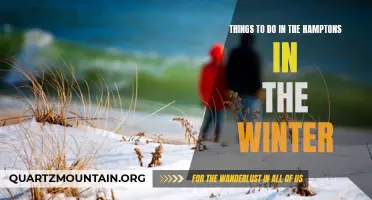
10 Fun Winter Activities in the Hamptons
- May 07, 2023
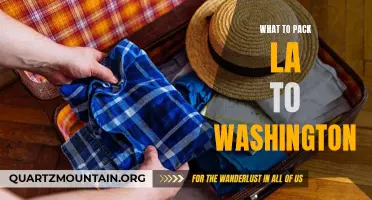
Essential Items to Pack for a Trip from Los Angeles to Washington
- Feb 22, 2024

The Current Status of Domestic Air Travel Liquid Restrictions: What You Need to Know
- Sep 01, 2023

Exploring the Current Travel Restrictions in Montreal: What You Need to Know
- Nov 12, 2023

France Imposes Travel Restrictions Amid Rising COVID-19 Cases
- Sep 06, 2023
13 River Float Trip Essentials + Packing List & Tips!
- Post author: Rachel Means
- Post last modified: 2023-10-25
Summer is the perfect time for a lazy float trip down an easy-going river. It’s a great way to relax outside, unwind from the work week, and just chat with friends or family for a few hours.
We’ve been on our fair share of river tubing adventures; some long forgotten and others that will live on for years through shared inside jokes with friends.
There’s a direct correlation between your group’s preparedness level and the amount of fun you’ll have on the river.
That’s not to say you can’t do this spur of the moment. But there are certain float trip essentials that will make your day on the river a fond memory rather than just a passing thought.
So, without further ado, here’s our finely tuned float trip packing list for a fun day out!
This post may contain affiliate links. As an Amazon Associate and associate of other programs, I earn from qualifying purchases. This means if you click a link and make a purchase, I may earn a small commission at no extra cost to you.
Table of Contents
Float Trip Essentials
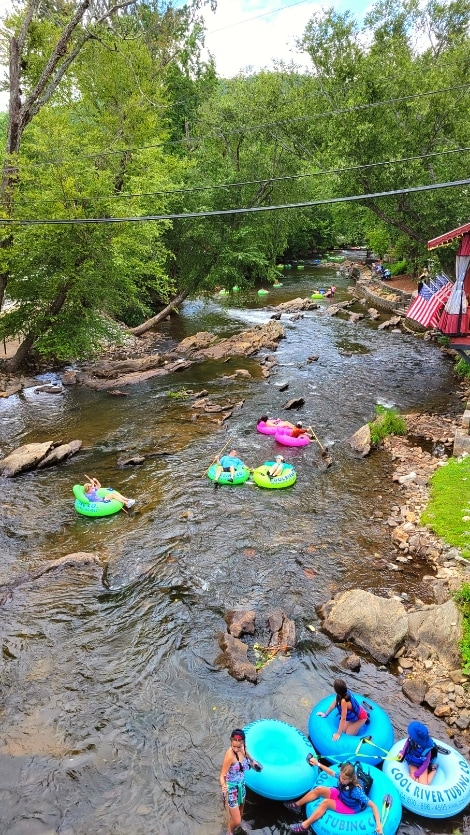
1. The Tube
The one float trip essential that you can’t go without: the tube.
We’re talking an honest-to-goodness river inner tube, not a cheap/thin one for a pool or from Amazon.
If you’re tubing with a company, then you’re all set and don’t need to bring your own.
The tube should be included in the price (hopefully transportation, too), and you’ll be able to spot and avoid the partially deflated tubes on the rack.
Your float trip will get un-fun real fast if your inner tube gets a puncture and deflates.
Then you’re, quite literally, stuck up the creek. Probably in a swimsuit with a cooler full of beverages, surrounded by muddy banks and nowhere near a real road.
Most rivers we’ve tubed are shallow , and you WILL scrape the bottom at some point during your journey. Pool floats won’t make it past the first rock.
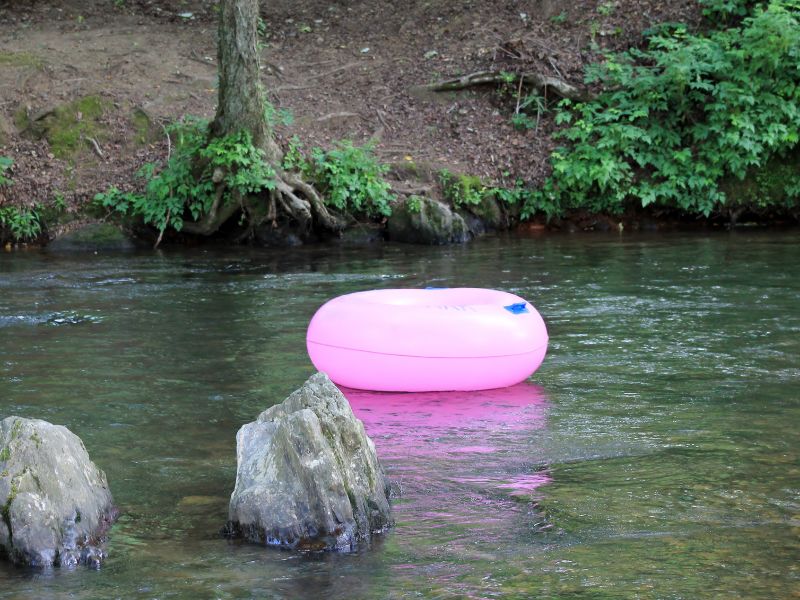
The best river float tubes have handles and maybe even a back support/cushion thing.
We’re personally indifferent to whether or not the tube is open or not on the bottom.
Some people have strong opinions about this, for innocent and sometimes otherwise reasons.
Generally, those that want a closed bottom think it will protect their stuff from the river, be it their electronics or their swim bottoms.
Tubes can tip over so easily. Having a closed bottom tube to protect your stuff is a false sense of security.
Pro Tip : Closed bottom tubes are good for holding coolers, but keep in mind that they can still tip over. Bring one that has a lid that latches so you don’t lose all your drinks if its tube flips.
Then there’s the pro open bottom tube people.
Some innocently enough prefer to cool off as they float, or they prefer to wear their tube like a hula hoop instead of sitting in it.
Others want it for the bathroom option, which we personally think is gross. Other people are floating on that river with you.
If you have to answer nature’s call mid-river, pull off to the side away from others so it has a chance to dilute in the river, and for the love of all things hygienic, don’t pee ON the tube.
2. Bungee cords (or Twine)
Tubing is more fun with a group! But how do you stick together on a body of water with moving currents?
Bungee cords.
Some people will say Velcro straps, but we’re here to tell you those don’t work. They pull apart too easily.
If you want to make it through those tiny rapids together as a group, you need bungee cords.
Pro Tip : Loop the bungee cord through the tube handles, and hook the hooks to themselves. We’ve had much more success with this method than with hooking to the tube handles themselves.
Sizing is important here. You need enough slack to let the tubes move around but enough tension to keep a tube from lagging behind or speeding up.
Too small and the tension in the bungee cord can cause two tubes to sandwich together.
Too big and the slack could cause the bungee cord to unhook itself.
If you’re in a pinch and don’t have bungee cords , you can almost always find a tube that already has a bit of twine on the handle.
Tying tubes together with twine can work on gentler rivers, but may break on float trips that involve minor rapids or simply a faster current.
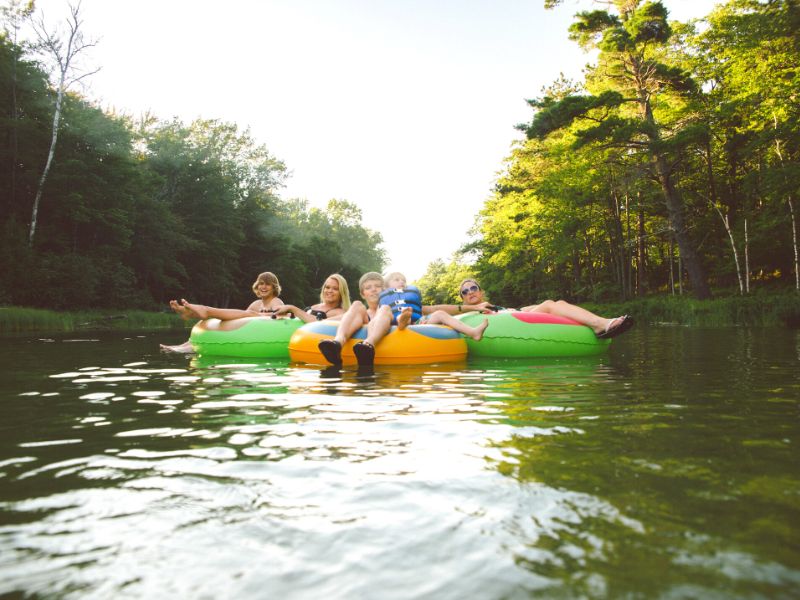
3. Swimsuit or clothes you don’t mind getting wet
You will get wet on your river float trip. But you’ll also likely get a lot of sun.
There’s a fine line to walk here between staying cool and not getting sunburned.
Swimsuits are made for the water, but they offer the least sun protection.
We know from experience that reapplying sunscreen mid-river is a tricky business. The less area you have to reach, the better.
For that reason, we tend to favor the half and half approach: swimsuit tops and shorts.
For me, that’s a tankini with athletic shorts over the bottom. For my husband, it’s a rash guard and his swim shorts.
4. Water shoes (or flip flops or old shoes)
It’s a truth universally known ( any Jane Austen fans? ) that you will have to walk your tube out of shallows or off of a rock at some point on your river float trip.
You’ll thank your past self for wearing water shoes.
Bonus: they’ll protect your feet from getting sunburned, too.
If you don’t own water shoes, flip flops or old shoes can work, too.
But flip flops have a habit of floating away when you’re not paying attention, and old shoes will get waterlogged and heavy.
Water shoes are not only float trip essentials but also our go-to footwear for most water activities.
Shoes that can get wet, not weigh you down, protect your feet, and dry quickly are a must-have for anyone that enjoys playing in/near the water.
5. ALL the sun protection
Tubing down a river is basically mobile sunbathing, but you can’t turn over when you start to cook too much on the top.
Sunscreen is a must before you head out and should be top of your float trip packing list so you can reapply while floating.
Pro Tip : Bring chapstick with SPF to keep your lips from getting sunburned.
Alternatively, wear a hat, sunglasses, and maybe even a rash guard shirt if you don’t want to bother with reapplying sunscreen on the water.
Your tube will rub off the sunscreen, too, so be mindful of that when applying. You’ll get weird burns on the sides of your arms and legs.
Bring an umbrella if it’s not too windy and use it to shade most of your tube, or at least your upper half.
Don’t forget your feet! If you’re sitting in your tube, your feet stick out the most and will get sunburned.
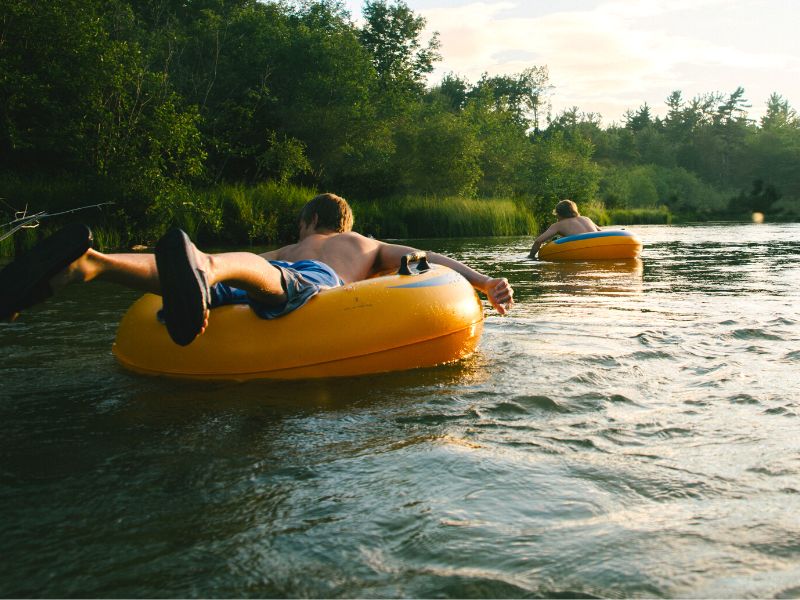
6. The Cooler!
Often, the most beloved float trip essential is the cooler.
It holds all the cold, liquid fun for your trip, but if you do it right, it also has the tasty, not melted snacks.
Bring both sweet and salty snacks. As long as you keep chocolate and fruit snacks in the cooler, they’re fine to eat on the river. Otherwise, they turn into a sticky mess.
We also like granola bars and beef jerky sticks to help replenish some of the salt from sweating in the sun.
If you bring popsicles, eat them first. Don’t bring an entire box unless you have that many people in your float group.
Only you can know how many drinks per person is enough, but we’d recommend you keep it low so your cooler doesn’t get too heavy .
It may be floating in its own tube, but you still have to carry it into and out of the river.
Pro Tip : Most tubing companies let you rent an extra tube for a cooler. Some even have smaller tubes specifically for coolers. If you’re a professional, tubing every weekend, you can buy floatable coolers.
There’s debate between Styrofoam coolers or hard-sided, reusable coolers. We go reusable every time.
They insulate better, keep drinks cold longer, and are infinitely better for the environment.
If you’re worried about losing it, just make sure it’s securely tied to its tube’s handles.
Even if the cooler tube flips, the cooler will stay attached and not sink. ( You’ll need something stronger than twine or Velcro straps, like bungee cords… )
And let’s be honest, most of you would dive after the cooler like you were saving your first born child.
7. Trash bag
Leave no trace, people! Don’t be a litter bug. Clean water is the most precious resource our planet has.
We’ve already talked about the wonders that the cooler may hold, so we need to have a trash bag to contain all the leftover debris.
A mesh produce bag works just fine for your empty cans, but snack wrappers need to be contained.
Use a small plastic bag that is attached to your stuff (and won’t become trash when you lose it when the tube flips) or just a particular zippered pocket on a bag or someone’s shorts.
8. Bug spray
Depending where you’re tubing, this is one of the most important float trip essentials.
We’ve only needed insect repellent on maybe a 1/4 of all the float trips we’ve ever taken. But the ones we used it on, we were super grateful to have it handy.
We keep our sunscreen and bug spray in the same bag, always in the trunk of our car so we can’t forget them.
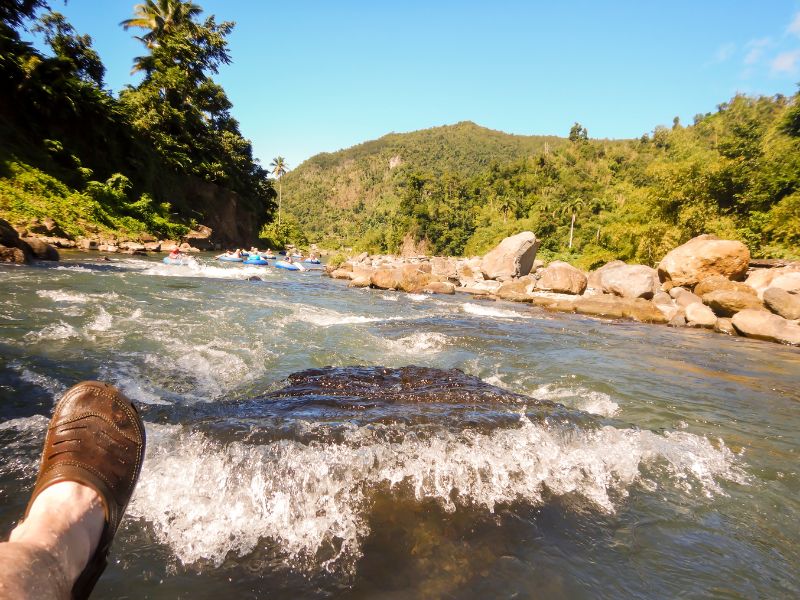
Float Trip Extras to Bring
9. a dry bag.
We don’t consider this one of the float trip essentials because you can easily go without one. Not everyone needs a ton of stuff with them on the river.
It’s a nice to have and not a need to have to enjoy your float trip.
10. Towels
This is a personal preference. We don’t bring our towels with us on the river because if they get wet, we’re out of luck all the way home, which for us has sometimes been several hours away.
But others want to dry off as soon as they exit the river and have the towel for warmth on the tubing company bus ride back to their car.
Up to you if you’re willing to risk it.
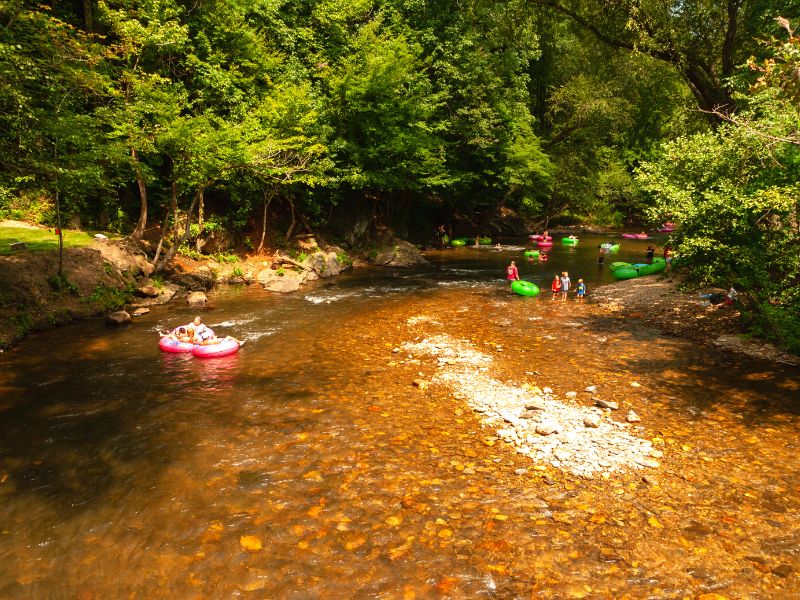
11. Water guns
Great for kids and adults alike, water guns are a fun way to keep the float trip lively.
Depending on your location and the flow of the river that day, you might be floating for a while and need to break up chats with a brief water gun fight.
12. Hand sanitizer
In a post-pandemic world, we take hand sanitizer everywhere.
We’re much more aware of all the gross things we touch without thinking about it and then touching our face or using our hands to eat snacks.
13. Water-friendly camera
Some float trips have a strict Las Vegas policy ( what happens on the float trip, stays on the float trip ), but for the rest of us, a GoPro can capture the fun and preserve the memories.
GoPro is our water-friendly camera of choice , but it does have its limits.
It’s meant for being strapped to you while doing something athletic, like snowboarding or surfing, so it doesn’t have a lot of flexibility in the type of shots you’ll get.
Most cell phones have some amount of water resistance, but we’d still recommend a floating waterproof phone case to avoid losing it.
Get Your Float Trip Packing List Here!
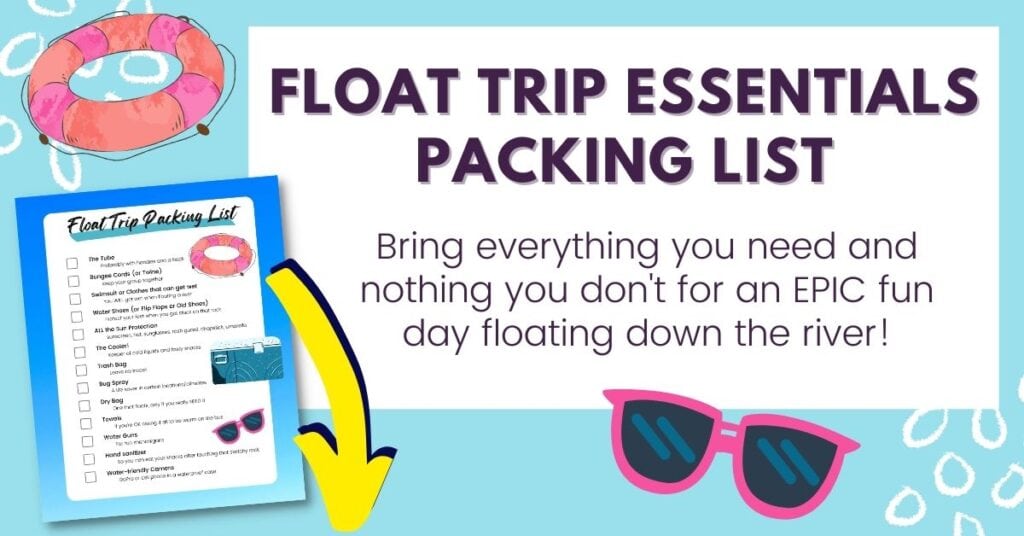
What Not to Bring on Your Float Trip
We’ve talked about your float trip essentials and handed you a float trip packing list, but let’s talk for a minute about the things you DON’T want to bring on the river.
- Electronics that can’t get wet
- Cotton, jeans, or other heavy fabrics
- Expensive sunglasses
Leave the expensive sunglasses at home. If you bring a pair on the river, be sure they either have a strap or you don’t care about them if you lose them.
Cotton isn’t heavy when it’s dry, but it’s a problem once it’s wet . Synthetic, quick-dry fabrics are best on the off chance you fully submerge when your tube tips.
There’s nothing to buy on the river, so leave your wallet (hidden) in your car.
Electronics are a given that they don’t mix with water.
But some cell phones are getting better at water resistance and a GoPro was built specifically for surviving the outdoors and capturing footage, so use your discretion.
The car key is the most difficult to decide how to stash. You have to lock your car, and common sense is to take the key with you.
But you don’t want to accidentally drop it in the river and lose it, so maybe you tie it to your wrist.
Good try; most car keys are electronic these days.
Most still have a physical key hidden inside the clicker somewhere, but the car usually won’t lock if you leave the clicker part inside it.
The best option is a locker with your tubing company. Some companies include them in the price; others charge an additional fee.
It’s worth the ask and usually worth the fee to have a secure, dry spot to keep your car key safe from the river.
Depending on the company, you’ll either have a locker key to wear on your wrist on the river or they’ll store your key in their office and you show your ID to get your stuff back when you’re done.
If your tubing company doesn’t offer lockers or key storage, then bring a waterproof, floatable bag.
Ziploc bags are waterproof but not floatable when weighed down with contents. Some dry bags are floatable.
Enjoy Your Float Trip!
With these float trip essentials in hand, you’re sure to enjoy a memorable day on the water!
More Travel Logistics Resources
- How to Travel More with a Full-Time Job or on a Budget {21 Useful Tips!}
- 10 Essential Travel Items for First-time Fliers
- How to Get from BWI airport to downtown Washington, DC
- 35 Best Staycation Ideas for Relaxing on a Budget
- Save $$$ with an America the Beautiful National Park Pass
- How to Get to St John, USVI in 3 Easy Steps
- St John Transportation: Getting Around Without a Car
- 9 Ways for Getting Around Seattle – Without a Car!
- How to Get to Whidbey Island from Seattle {Quick + Easy!}
- Cheap, Fast Travel from Munich to Zurich {Not What You Think!}
- How to Get to Neuschwanstein Castle from Munich
- Review of Going (formerly Scott’s Cheap Flights) {Flight Deals Delivered to Your Inbox}
- Can I Bring Scissors in My Carry-on Bag?
- How to Bring Hiking Poles on a Plane {Tips + TSA Rules}
Happy travels!

About the Author : Rachel Means
With six-figure student loan debt and only 10 PTO days per year, Rachel started traveling the world. A decade later, she’s paid off her loans, changed careers, and been to 38 US states and 17 countries. She’s an expert at planning and budgeting for travel and loves to help others do it, too! Read her full story here.
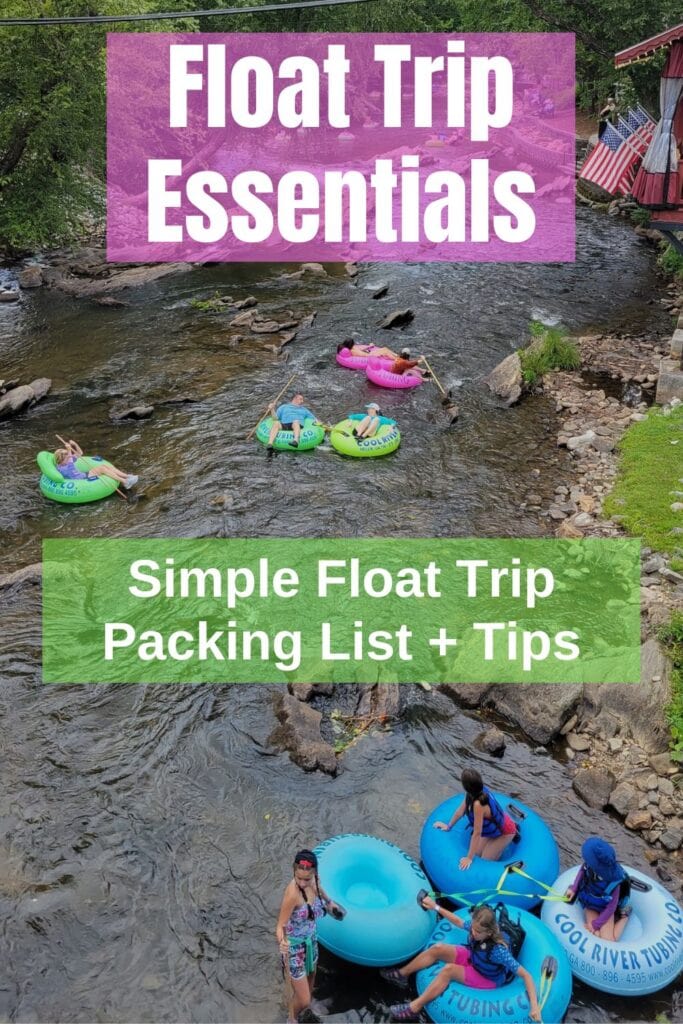
You Might Also Like
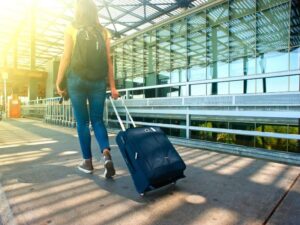
How To Bring Hiking Poles on a Plane: Tips + TSA Rules

How to Travel More: 21 Useful Tips, Even with a Full-Time Job or Tight Budget

40 Unique Travel Gifts for Every Traveler (Ultimate Gift Guide 2024)
- New Test Kitchen Flavor: Hot Honey!
- New Mini Beef Sticks!
- Visit Us in DTLA
- Old Fashioned
- Tasting Kitchen
- Beef Sticks
- Test Kitchen
- Jerky Crisps
- Keto Beef Jerky
- Carnivore Diet Beef Jerky
- Spicy Beef Jerky
- Newest Flavors
- Jerky Boxes
- Jerky Grams
- Greeting Cards
- Subscribe & Save
- Editorial Standards
- The Homemade Jerky Project
- Carnivore Diet
- Gift Guides
- Jerky Facts
Float Trip Essentials: 29 Can’t Forget Items
There are few summer activities better than floating down a fresh body of water in beautiful sunshine. Like most outdoor adventures, a little planning and preparation will unlock a relaxing and enjoyable day on the water.
We prepared this float trip checklist that covers gear, safety, clothing, and provisions.

What to Bring on a Float Trip
Float trip gear, float trip safety, float trip clothing.
14. Swim Suit 15. Cover Up 16. Rash Guard 17. Floating Sunglasses 18. Hat 19. Water Shoes (River Sandals or Neoprene Booties) 20. Dry Clothes

Float Trip Provisions
Float trip extras, what not to bring on a float trip.
Download a printable float trip packing list here.

Float Trip Pro Tips
- Keep it light. You don’t want to be weighed down with unnecessary gear.
- Sun protection is critical. Make sure to protect yourself from the sun.
- Drink plenty of water. If partaking in adult beverages, drink responsibly.
- Do your part. Clear your letter, pack out what you pack in, and clean up after yourself. Keep the river water clean and clear.
About The Author
Brian bianchetti.
His passion lives at the intersection of food, travel, cooking, and drinks. On the weekends, you'll find him at the driving range, newest pizza restaurant, or hosting a dinner party for family and friends with his queen.
See Full Bio
100% Happiness Guaranteed
Shop with the confidence of 90 years and four generations of family tradition.
Shop All Beef Jerky

Don’t miss out on jerky news
Sign up by email to get a complimentary beef jerky bag valued at $6.99 on your first order. Or via SMS, text BEEF to 72168 to get a free bag.

How to Plan Food for a Canoe Camping Trip
By sarah coupal & aaron owens mayhew, ms, rdn, cd, updated january 4, 2024.
This post may contain affiliate links.
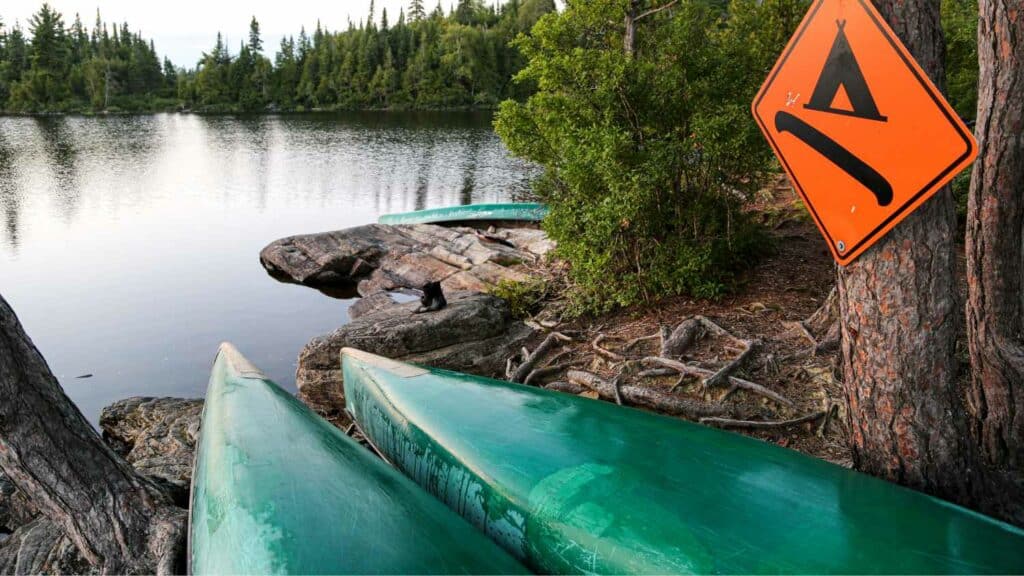
Factors to Consider | Amount of Food to Pack | Which Foods to Bring | Canoe Trip Hydration
Curious about packing food for canoe camping trips? Are you looking to transition from day paddles to overnight trips? Whether you are an experienced paddler looking to improve your nutrition or just curious about what canoe camping is all about, this article is for you!
Here at Backcountry Foodie, our main focus is food to fuel your hiking and backpacking trips. That said, the food for a paddling trip (canoe, kayak, or SUP) is not too different. The fact that you don’t have to carry everything on your back might even give you more flexibility in your meal planning. If you’re a foodie and have never been canoe camping, this post might convince you to try it!
What is Canoe Camping?
Canoe camping trips are multi-day trips where you paddle between campsites on lakes and rivers. All of the gear you need is carried in your boat. When lakes and rivers do not connect, you must portage (carry) your boat and all your gear on trails or roads.
What Should I Consider When Planning Food for a Canoe Camping Trip?
First, think about the length of your trip. This will determine how much food you need to pack and the types of food you can bring. For shorter trips, you may be able to bring some fresh food. For long trips, space, weight, and the shelf life and durability of your food will be more of a concern.
You should know the mileage of your route and your average paddling speed . From this, you can calculate the hours per day you will be paddling and portaging (if applicable). This is important because you burn significantly more calories when exercising than when sitting at camp or floating down the river.
Think about the weather as well. Being on open water means you will be more exposed to wind, which could make it harder to paddle. Shivering can burn up to 400 extra calories per hour if you get wet from rain or capsizing.
Finally, how will you store your food? Some people have canoe barrels or wanigans , which are food storage methods designed specifically for canoe tripping. You can also use a backpacking bear can or do a classic bear hang. As always, check the food storage regulations for the area you will be camping in.

How Much Food Should I Pack for a Canoe Camping Trip ?
Well, it depends.
Many factors affect how much food you must pack for a canoe trip. Like backpacking, the best way to dial in on the fuel your body needs is to keep a food journal with the following details:
- Conditions of the trip
- What you ate
- How you felt
- Any other details you think are relevant
You can then use this information to plan for future trips, ensuring that what you pack is personalized to your needs.
Here are some general guidelines to think about when deciding how much food to pack:
- You could burn anywhere from 200-700 calories per hour for every hour of paddling. This wide range depends on your weight, fitness level, speed, and water conditions.
- Long portages will have a larger impact on your calorie needs compared to easy paddling for the same amount of time.
- For low-intensity paddles, aim to eat 30-60 grams of carbs per hour. For more intense exercise, you should be eating 60-90 grams of carbs per hour. See our Best Backpacking Foods for Energy post for more information about carbohydrate serving sizes and snacks.
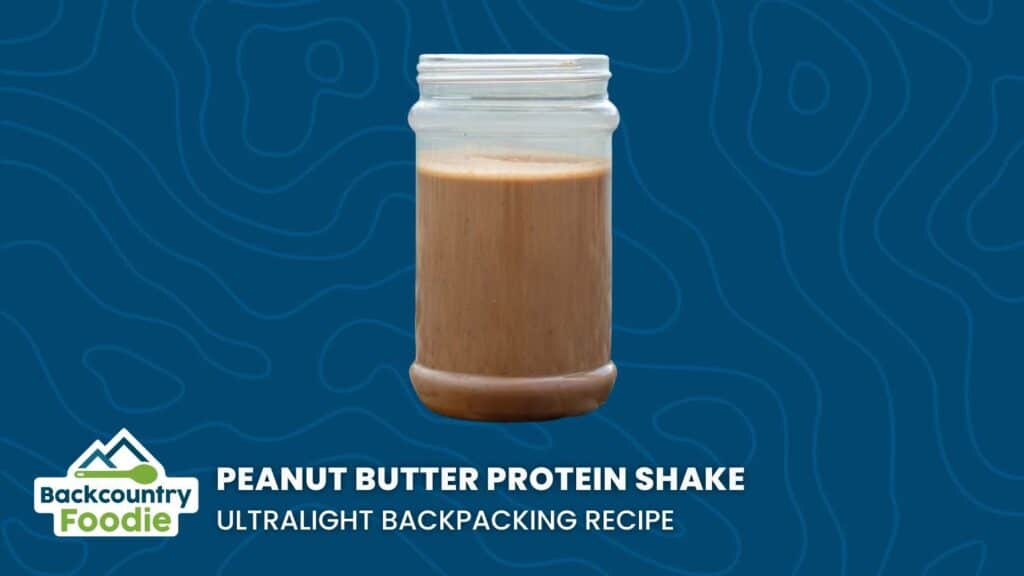
Are you also a day hiker or backpacker?
Here’s a great resource for determining calorie goals.
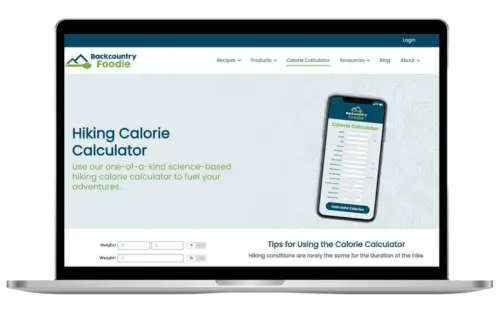
We created a one-of-a-kind hiking calorie calculator that takes all of the guesswork out of deciding how much food to pack for your adventures.
It’s a FREE resource, too!
Click on the link in the header bar or the button below.
What Food Should I Bring on a Canoe Camping Trip?
Choosing which foods to bring on your trip depends on personal preference and the details of your trip.
Short, Laid-back Trips
For short trips with few or no portages, many people opt to bring fresh foods similar to what they would eat at home. However, if you are planning to get into some serious backcountry cooking on your trip, we would not recommend bringing fresh meat, fish, eggs, or dairy products (with the exception of hard cheeses). These foods should not be kept unrefrigerated for more than 2 hours. Dry milk , powdered eggs , tuna or chicken packets, and jerky are good alternatives. Some foods also do not pack well (e.g., bananas), and the size of your food storage container (canoe barrel, bear bag) will determine how much you can pack.
Some fresh foods that keep well include:
- Potatoes, carrots, peppers, onions, cabbage
- Apples & oranges
- Sharp cheddar cheese
Leave No Trace
If you plan to bring fresh foods on your trip, make sure to pack out all food scraps to dispose of when you get home. It can take an orange peel up to 6 months to decompose! Also, make sure to wash your dishes away from water sources, even though it can be tempting to give them a rinse directly in the lake or river.
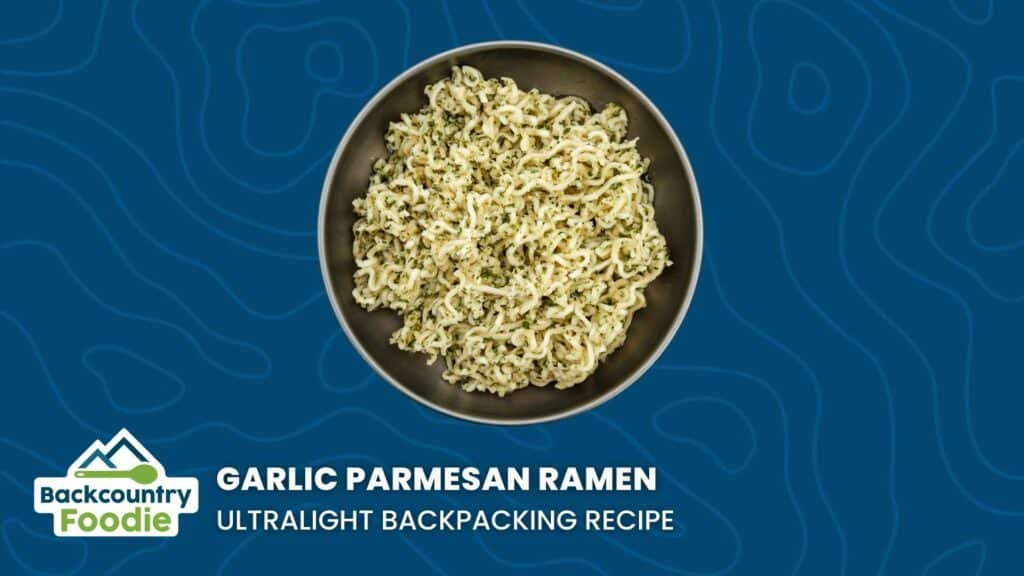
Longer, More Strenuous Trips
For multi-day trips and trips with long portages, we would recommend mostly dried foods. You’ll probably be trying to pack a lot of food in addition to all of your other gear. Backcountry Foodie has tons of great recipes that are low-volume, lightweight, and loaded with nutrition. These foods will last for even the longest trips.

Regardless of the length of your trip, make sure to pack plenty of snacks. Plan to eat every 30-90 minutes when you are actively exercising, depending on the intensity of your activity.
Don’t have time to prep DIY meals?
Not to worry! We offer a variety of Backcountry Foodie meals and meal replacement drink options in our shop . Here are just a few…
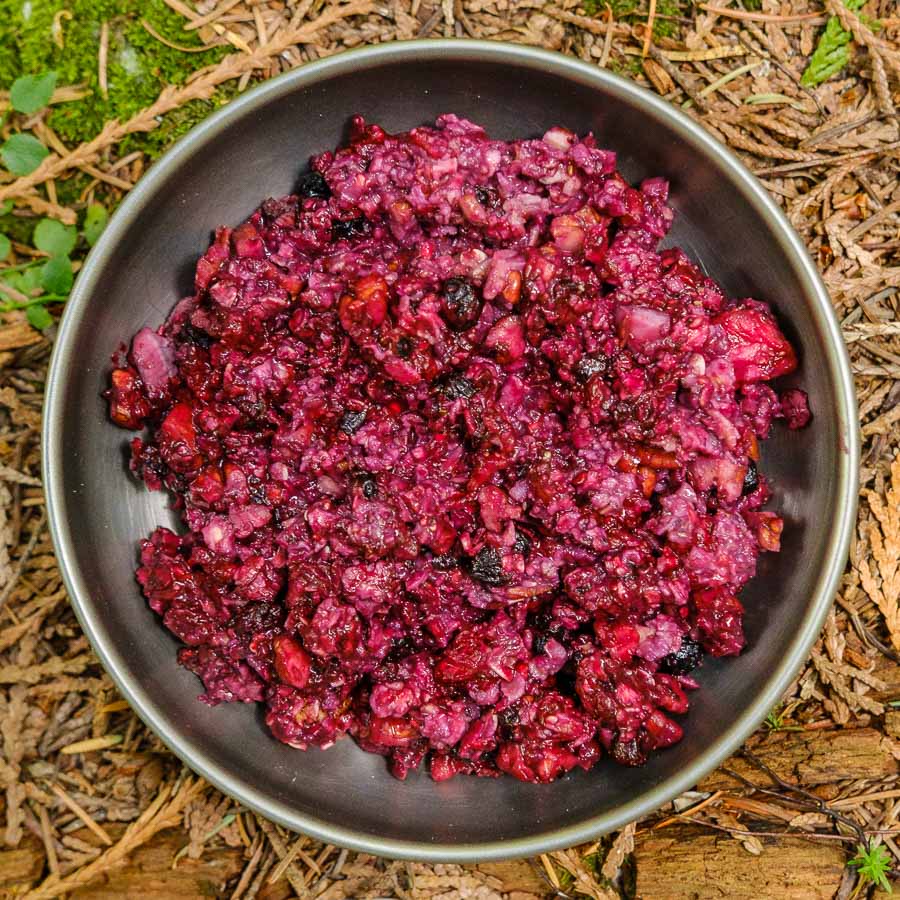
Sign-Up & Save!
Subscribe to our weekly newsletter & save 10% off Backcountry Foodie memberships.
Your email is safe with us. We don’t like spam either.
Hydration while Paddling
Hydration is an important part of fueling for paddling. You are often very exposed to wind and sun and might not notice how much you are sweating if your sweat evaporates quickly.
The amount of water you should drink per hour varies depending on how heavy of a sweater you are. For light sweaters, 0.5-1 liter of water per hour is a good estimate, whereas heavy sweaters can lose up to 2 liters of water per hour.
You also need to eat foods with salt to stay hydrated. You can lose 100-4000 mg of sodium (salt) per hour, depending on how much you are sweating and how salty your sweat is.
Some salty snacks to consider packing include:

- Trail mix/salted nuts
- Dried hummus
- Triscuits or other crackers
As you might have noticed, canoe-tripping food is not too different from backpacking food. The best foods to pack vary depending on your trip and personal preferences.
Putting It Together
Keep in mind these factors the next time you are planning a canoe trip:.
- Length of your trip
- Miles you will travel each day
- Speed you plan to travel
- Food storage
- Personal needs and preferences
- Leave No Trace principles
Need Help Planning Food for Your Trip?
Backcountry Foodie is your go-to resource for more than 200 dietitian-created backpacking recipes and a one-of-a-kind automated meal planning tool. The meal planner even creates itemized shopping lists for you! Meal prep has never been easier.

Let us do all the heavy lifting for you !
Skip the hassle of resupplying during your hike . Let Aaron Be Your All-In-One Personal Chef, Shopper, Coordinator, And Dietitian!
DISCLOSURE: Some of the links on this page are affiliate links, which means we may receive a modest commission if purchases are made through those links. This adds no cost to our readers and helps us keep our site running. Our reputation is our most important asset, so we only include links for products we use ourselves.
Did you find this post helpful?
Pin it and share it with your fellow hikers..
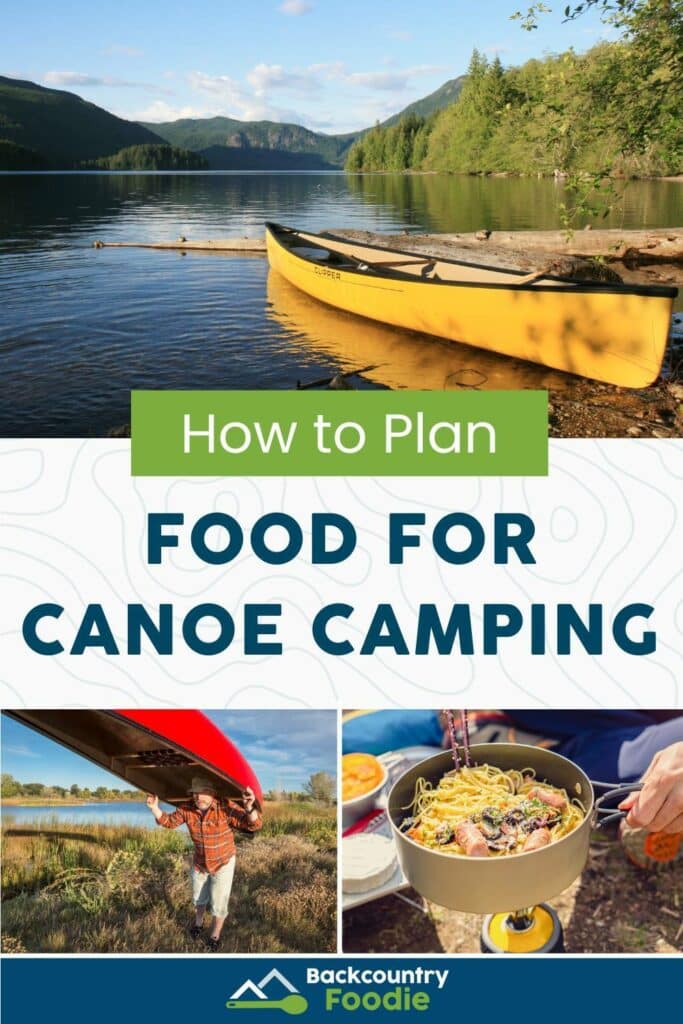
Are you new to our blog?
Consider checking out these posts:.
- Best Backpacking Foods for Energy
- What to Eat & Drink After Hiking: Our 3 Favorite Tips
- Backpacking Nutrition: Fueling Further Using the Goldilocks Approach
- Our Favorite 100 Grocery Store Foods
ABOUT THE AUTHORS:
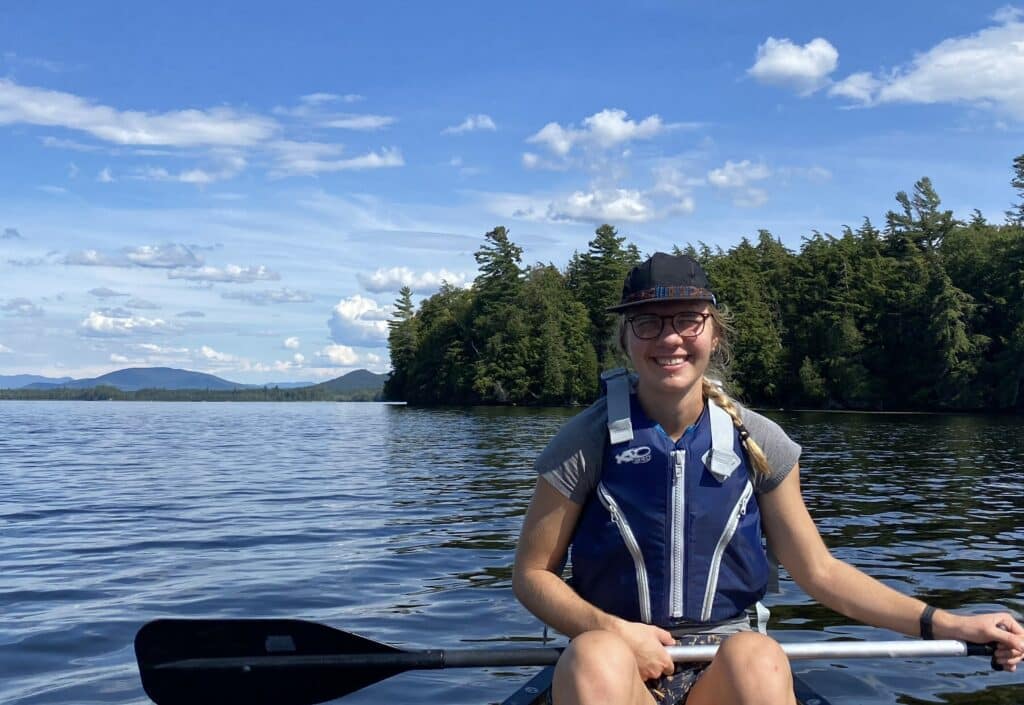
Sarah Coupal was a Dietetic Intern at Illinois State University mentored by Aaron when this post was originally written. She holds a BS in Nutritional Sciences from Cornell University and spent two summers as the Trails Food Coordinator for the Adirondack Mountain Club. She enjoys hiking/backpacking, canoeing, cross-country skiing, and running in her free time.
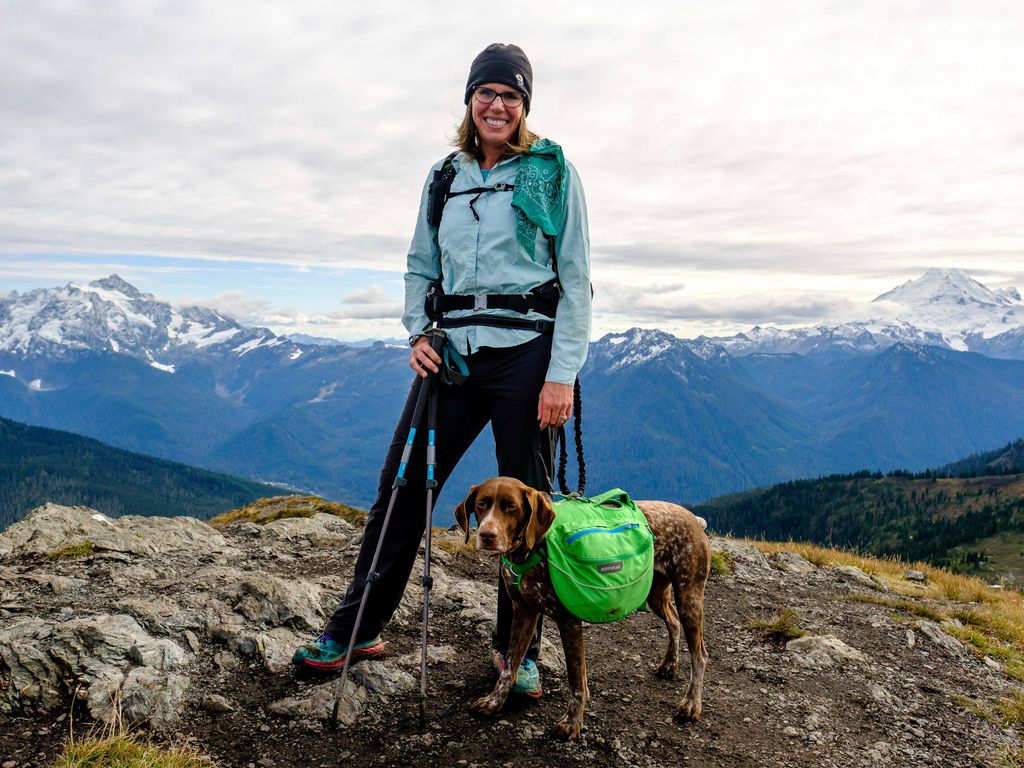
Aaron Owens Mayhew, MS, RDN, CD, is a registered dietitian and ultralight long-distance backpacker with over 20 years of nutrition and backpacking experience. She’s also the founder and owner of Backcountry Foodie , an online ultralight recipes and meal planning platform for backpackers. She also enjoys teaching hikers about backpacking nutrition via virtual masterclasses , YouTube videos , and podcast episodes . You can follow Aaron’s adventures in the kitchen and the backcountry via Instagram and Facebook .
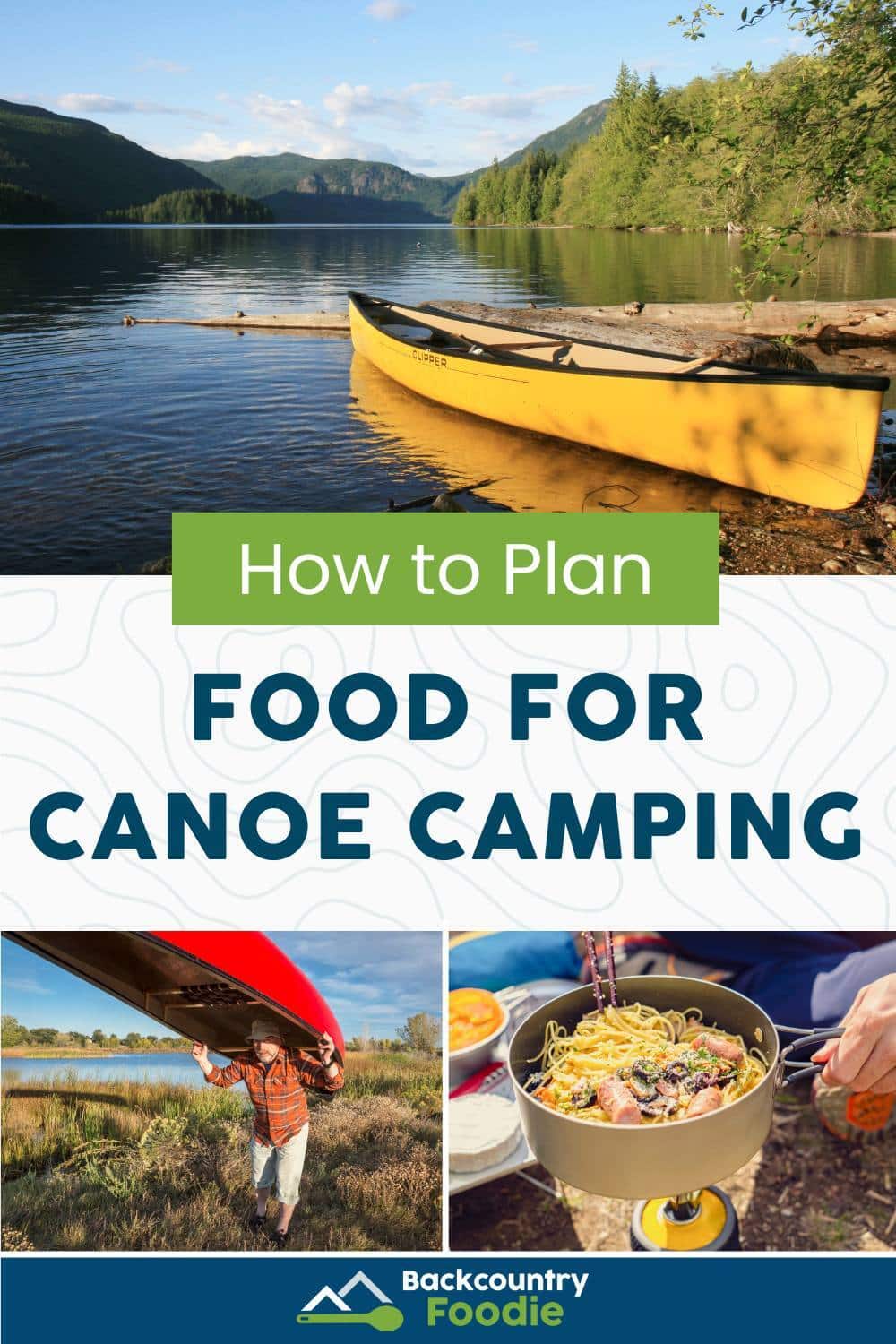
Leave a Reply Cancel reply
Your email address will not be published. Required fields are marked *
Save my name, email, and website in this browser for the next time I comment.
COMING SOON
Labor day sale.
Enjoy 20% off our memberships when you use coupon code LABORDAY20 at checkout!
Sale starts Friday, September 1st.
- 123 Pinterest
- 0 Copy Link

25 Top Float Trip Packing List Items for 2024 + What to Wear & NOT to Bring

A river float trip has to be one of my favorite summer activities! What could be more relaxing than kicking back on your tube as you float past the gorgeous shoreline, soaking up the sunshine with not a care in the world?
Floating the river is all that and more, but knowing what to bring and how to prepare makes all the difference in having a fabulous time. To help you have the best experience possible, I’ve compiled a float trip packing list, as well as what to wear on a float trip , what NOT to bring, and answers to the most-asked questions. Happy floating!
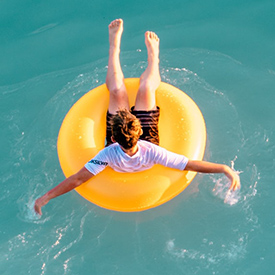
What to Pack for a Float Trip – 25 Essentials
1. raft or tube.
Tubes are ideal if you are going on a hot day and want to be partially in the water as you float. If it’s a cooler day or you’re taking children or lots of picnic supplies, a raft may be more comfortable. But you really can’t go wrong with either of these great float options!

View on Amazon.com ➜
2. Quick-Dry Travel Towel
You want to have a towel stashed in your car for when the float is over. This towel is so compact that it can easily fit anywhere, and it has great absorbency, so even if you decide to take a turn on that rope swing, you know you can dry off later! We use this as a beach towel, sweat rag, and seat cover, and you can find infinite more uses!

3. Cooler Tube
Half the fun of a successful river float trip is the cold drinks and snacks! A tube like this with a built-in spot for a cooler makes it a breeze to throw all of your food and drink supplies in one spot. You can then simply strap the cooler tube to your tube and float with all the comforts of home!

4. Waterproof Phone Pouch
If you want to take your phone along for safety or to document the fun day, make sure to get this case! The waterproof case will be a lifesaver if your phone goes overboard! And you can even film stunning underwater videos and your adventures as you river raft, drink beer, and enjoy the sun! These shots will make beautiful memories to look back on.
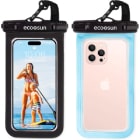
5. Swimsuit Cover-Up
A sunburn is one surefire way to ruin even the best day on the river! So make sure you have some sort of swimsuit cover-up. This one is super cute and stylish, but its short length and pullover style mean that it won’t be in your way during the float.

This one is essential for any float trip. When you’re on the river, it’s necessary to have a stow option that you can trust to keep your supplies 100% dry. This bag is perfect for that! You can rest assured that whatever you put in it will still be dry even if your buddy decides to instigate a water fight. It will hold your cash, wallet, phone, medicine, and any other belongings. If you fold it with some air, it will float!
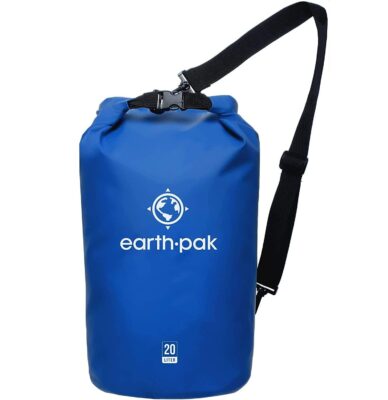
7. Travel Insurance
If you’re traveling more than 100 miles away from home or out of the country, you will need travel insurance. It protects you against theft, baggage loss, delays, medical emergencies, and transits that could get very costly if you’re not covered by your domestic provider. Paying out of pocket puts a damper on any river trip, so use Faye Insurance since they cover things like trip cancelation and make reimbursements easy through their mobile app.

Get a quote in less than 60 seconds with Faye ➜
8. Packing Cubes
The hotel on a float trip can look like multiple suitcases exploded REAL quick! Use these packing cubes to stay organized since every family member can have their own color and label each cube (swimsuits, pajamas, essentials, etc.) so you’re not having to tear the room apart every time you need something. Each set even comes with laundry bags so you can separate dirty laundry and shoes from your clean items.
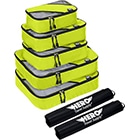
9. Flotation Strap
This strap is a brilliant solution to protect your phone, camera, or keys! Simply attach the strap and you can rest easy knowing that your item will float. The neon color means you can easily spot it in case it lands in the water. I’ve watched my phone sink to the bottom of a lake where we couldn’t find it once… You might want to buy a few of these!
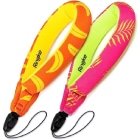
You want a lightweight, simple cooler that can hold all the necessities for your group. This one fits in the cooler tube and is big enough for all the picnic supplies and drinks you could want! The price can’t be beaten, and since it’s Coleman. it will last you for many river floats to come!

11. Neck Wallet
Making sure you have a safe place to keep your valuables is important, especially when you’re on the river! This neck wallet is so good for travel, and since it hangs securely around your neck it is the perfect solution for your float trip. The rugged nylon fabric is another bonus when you’re on the water. It’s useful for travels through the airport too when you want to conceal your passport, credit cards, phone, cash, and more.

12. Motion Sickness Patches
For those of us that are prone to seasickness or motion sickness, don’t let the river rapids get the best of you! Enjoy the ride with motion sickness patches that will keep your equilibrium intact. These are the most effective brand we’ve come across, and my wife doesn’t travel without them.
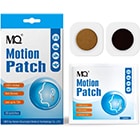
13. Water shoes: Women’s & Men’s
Don’t be the person that loses a flip-flop halfway through the float trip! I’ve even had my feet torn apart by underwater rocks not wearing shoes, so I will never make that mistake again. These water shoes will fit securely on your feet which means there’s no possibility of losing them, but they are breathable, quick-drying, and comfortable enough with traction for some light hiking. Not to mention pretty stylish and affordable.

14. Cooling Towel
This towel is a genius way to stay cool, even on the most blistering of days! Simply soak it, wring it out, and put it around your neck to enjoy the cooling effects. The microfiber material means it’s reusable and chemical-free, which will definitely come in handy on all your summer trips.
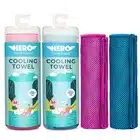
15. Filtered Water Bottle
It’s wise to maintain autonomy over your water supply on float trips. This Brita option filters your water and makes it taste noticeably better. I like that you can just add the water and drink like normal, staying hydrated while you might be drinking alcohol (which can make you feel exhausted faster in the hot summer sun).
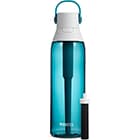
16. Sanitizing Wipes
You never know when you might need hand sanitizer, so make sure to throw a bottle in with your supplies. These travel-sized wipes are perfect to stash wherever you need them since they’re individually wrapped. Put a few in your neck wallet, dry bag, or pockets and you’ll be prepared to clean up before your picnic lunch on the river!

17. Affordable Underwater Camera
This underwater camera is highly rated, but is much more affordable than other brands. It comes with a case that makes it waterproof for up to 98 feet underwater, and with its 4k video resolution, you are bound to record some great memories to enjoy for years to come!

18. Hanging Toiletry Bag
I never travel without this fantastic hanging toiletries bag. It can hold our entire family’s liquid bottles (toothpaste, shampoos, my wife’s makeup, face wash rags, etc.), and we haven’t had a suitcase eruption since using it. With 4 giant pockets, it hangs on any door or hook, so you have a built-in shelf (which means you don’t have products all over the countertop or nowhere to put things if you only have a sink).

19. Luggage Locks
If you’re flying anywhere, bring TSA-approved luggage locks. These are also smart to have for lockers by the lake, lockers at theme parks, or your backpack in crowded areas that draw pickpockets. You can never be too careful!
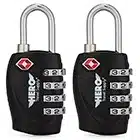
20. Insect-Repellent Wristbands
Insect-repellant wristbands are ideal for a river float when you’ll likely be in and out of the water. Simply wear these on your wrists and ankles, and you won’t have to constantly reapply repellent spray! This deet-free option means they’re non-toxic and safe for kids. And since they’re reusable and waterproof, they will give you up to 5 full days of protection.
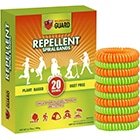
21. Oars/Paddles
Make sure to bring some sort of paddle for when you get to slow sections of the river or need to navigate around a rock or tree. These oars are fabulous if you are riding in a raft. They are small and compact but can help you paddle and direct your tube a bit when you find yourself on a lazy river.
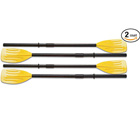
22. Tube Repair Kit
Of course, no one plans to get a flat tube, but you want to be prepared if you scrape a rock or find out your tube didn’t survive the year in your attic as well as you thought. This is a professional floating packers essential – bring this small repair kit along just in case, and you’ll be ready for anything.
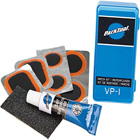
23. Long-Sleeved Swim Rash Guard
If you’re prone to burning – this is a must. These rash guard wet suit tops are amazing for a day in the sun! You can protect your skin from a nasty burn, while also making sure you don’t get any uncomfortable chafing against the tube. If you hit a shady spot in the river, you’ll be grateful for the extra layer of warmth too. It prevents me from looking like a tomato or having a weird tan line from sitting belly-up all day.

24. Kids’ Life Jacket
It may be easy to find rentals for adult sizes, but it can be trickier to find the right fit for your little ones. Bring your own life jacket if you can, this one is unisex and will ensure them full confidence in the water! Or the ability to float if they get too far away from you or fall off their tube.

25. Windproof Travel Umbrella
For rain and shade on hot river days, use this travel-sized umbrella. It’s thoughtful to pack an umbrella for any destination so sudden showers don’t slow you down. This one weighs about 1 pound and comes with a nice carrying case. I hide under it if the sun gets to be too much.

Other Float Trip Packing List Items
- “Just in case” bag
- Hangover prevention
- Electrolytes
- Universal adapter
- Worldwide tours
- Floating sunglasses
- Floating sunglasses strap
- Sunscreen lip balm
- After sun lotion
- Waterproof speaker
- Life jackets
- Children’s life jackets
- First-aid kit
- Paddle gloves
- Dry clothes to change into
- Fishing gear
- Cold drinks
- Snacks and lunch
- Paracord bracelet
- Ziploc bags
- Bungee cords
- Extra bottled water
- Diving knife
- Windproof umbrella
- Permit/money for parking fees
What to wear on a Float Trip
Of course it’s a no-brainer to wear your swimsuit on a float trip! But make sure you also look at the weather and bring layers as needed either to stay warm or to protect from the sun. A swimsuit cover up or rash guard with sun protection can double for either of those purposes.
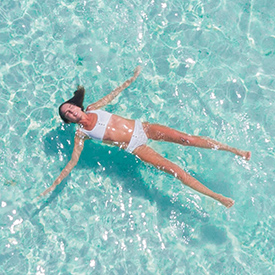
Beyond just the basic swimsuit, here are the things you’ll want to make sure to wear on your float trip as well as what you want to have in your car to change into when you’re done. Simple and comfortable layers are key! what MEN should wear on a Float Trip – (Click to expand) Below is a sample men’s clothing list. (All items link to Amazon.com for your convenience).

Packing for the Seasons in Float Trip
Spring on a float trip – march, april, may.
If you’re going on a spring float trip, you may need a wetsuit , depending on where you live. If you’re in a warmer climate where you don’t need a wetsuit, still make sure to bring plenty of layers!
SUMMER on float trip – June, July, August
Summer is the ideal time to float the river in most places! Refer to the detailed what to wear list above, but make sure you bring your swimsuit , sun-protective layers , and a dry change of clothes .
FALL on float trip – September, October, and November
Depending on where you live, you may be able to get in a trip down the river in the fall! You’ll want quick-dry shorts , and definitely some warm layering clothes .
WINTER on float trip – December, January, February
Lucky you if you’re in a place where you can still float the river in the winter! But even in the warmer climates it can still get chilly on the river, so you may want to look into bringing a wetsuit to stay warm.
What NOT to bring on a Float Trip
No matter how helpful that guidebook is, it’s better off at home! If you absolutely need the information, take a picture of the page or bring a copy.
2. Heavy clothing:
You want to think light and quick-dry clothing! Don’t wear heavy shoes or thick cotton sweatshirts. They will just get wet and weigh you down.
3. Electronic:
ater and electronics just don’t mix well! If you need a phone in case of emergency, consider designating one person in your group as the phone person, and make sure to get the floatable waterproof case . For photos, bring along a good underwater camera , and you won’t have to worry about it getting wet! Beyond that, leave the electronics at home.
4. Expensive sunglasses:
I’ve seen too many expensive sunglasses disappear in the river, and it certainly puts a damper on the fun of the trip! Make sure you have a good floatable strap , but even so, leave your designer glasses at home!
5. Valuables:
Whether it has monetary or sentimental value, if you would be upset if it hit the bottom of the river, you shouldn’t bring it. That includes rings, jewelry, and cash.
6. Unnecessary items:
You’ll find that you probably need less than you think on your float trip! So pack light, make sure you really can’t go a few hours without something before you bring it on the tube, and coordinate with your floating buddies so you don’t all bring cans of sunscreen but no insect repellent.
FAQs about Float Trip travel
1. should i choose a guided float trip or go on my own.
A guided trip will be a great fit for you if you aren’t familiar with the river and don’t have any tubes or gear. You won’t have to worry about pick-up and drop-off, and you can have a stress-free time! But if you or a friend have a little familiarity with the river, and you already have what you need to float (or you know you’ll want to go again next year), going on your own would be a great option for you and worth the initial investment. You’ll be able to take the float at your own pace, be more independent with your adventure, and go again next year with minimal expense!
2. Where should I float?
Find a river near you that has an appropriate water level and flow rate to make sure you don’t end up on white water rapids when you were only prepared for a slow river float. Here is a great list to get you started of some popular rivers across the US.
3. What time of year is best?
Typically summer is the best time for a floating adventure! Spring can mean high waters, and fall and winter can get cold. Make sure to choose a warm day and you are set.
4. Do I need to be able to swim?
You don’t need to be Michael Phelps, but you should have basic swimming skills and plan to wear a life jacket no matter what.
5. How do I know how long the float trip will take?
It depends on the speed of the river you’re on! 5-7 miles will take most of your day, while a 3-mile float will average 3 hours or so.
6. What is the best way to bring a cooler?
You can buy this nifty cooler tube or you can go with a makeshift version: choose a lightweight cooler to strap onto its own tube. You’ll be grateful for that cold drink a few hours into the float!
7. What are good snacks to take on a float trip?
Energy bars, chips, beef jerky, cookies, fruit…anything that is light and easy to pack will be your best bet! Throw them in the cooler on top of your drinks, and they’ll be easily accessible whenever you get hungry.
- Recreational Day Trips
- Longer Touring Excursions
- Straight Shaft
- Solo Canoeing
- Recreational Fishing
- Longer Fishing Excursions
- High-Visibility
- Hook Retrieval
- Versa-Lok Ferrule (Adjustable)
- Snap-Button (Fixed Length)
- All Sale Paddles
- New Arrivals
- All Apparel
- Accessories
- Cosmetic Seconds
- All Sale Items
- Bending Branches Team
- National ProStaff Team
- Regional Ambassador Team
- Wood Paddle Care
- Composite Paddle Care
- Factory Tours
- Canoe Sizing Guide
- Solo Canoe Sizing Guide
- Pack Canoe Sizing Guide
- Kayak Fishing Sizing Guide
- Kayak Sizing Guide
- Rockgard® Edge Protection
- Bent vs. Straight Paddle
- Paddles for the Solo Canoeist
- Versa-Lok Ferrule System
- Snap-Button vs Plus Ferrule
- Plus Ferrule System
- New At Bending Branches
- Black Pearl ST
- Dealer Locator
- Paddle Finder
- instagram Instagram
- twitter Twitter

- Learn Blog FAQ's Cosmetic Seconds Wood Paddle Care Composite Paddle Care Factory Tours Paddle Sizing Canoe Sizing Guide Solo Canoe Sizing Guide Pack Canoe Sizing Guide Kayak Fishing Sizing Guide Kayak Sizing Guide Choosing a Canoe Paddle Rockgard® Edge Protection Grip Guide Bent vs. Straight Paddle Paddles for the Solo Canoeist Choosing a Kayak Fishing Paddle Versa-Lok Ferrule System Snap-Button vs Plus Ferrule Plus Ferrule System Product Highlights New At Bending Branches Black Pearl ST
Canoe Trip Food: What Are Your Options?

8-minute read
By Sharon Brodin
A multi-day canoe trip is a unique wilderness experience that, like backpacking, means you pack your food wherever you go. Let’s look at your options for canoe trip food so you can make the best choices for your group and situation.
When it comes to canoe camping meals there’s no right or wrong. Some people want light and easy meals. Others want gourmet. Some love camp cooking, others just want to have a full belly. What you decide will depend on quite a few factors including whether you're planning long trips or shorter trips.
There are three basic options when it comes to meals for your wilderness canoe trip: “real” food (non-dehydrated), pre-packaged dehydrated meals marketed to backpackers, and DIY dehydrated meals.
There are pros and cons to each of these:
Bring “Real” Food
PROS: Tastes great • healthy • budget-friendly
CONS: Heavy • Takes up more room in the pack • somewhat labor intensive to plan and prepare both before and during the trip
BEST FOR: Trips with little to no portaging • short trips • strong portagers • fresh food lovers
Back in the 80s when I was a camp counselor in northern Minnesota, we brought teens on 5-10 day canoe trips in the Boundary Waters. In those days—at least at low-budget small ministries like ours—expensive pre-packaged backpacking food wasn’t an option (I’m not sure it was even on the market at the time).
We brought “real” food along on these trips. We had a food pack it all fit in, including the cook kit. It was our heaviest pack at the start of each trip and of course would lighten up after every meal.
When our family (my husband and I, plus our three teens) joined another family (with a husband, wife and their teen) for a 5-day trip a few years ago, we also brought mostly “real” food. We weren’t too worried about the weight because we had four healthy teenagers to help with the portaging!
We even packed in our griddle so we could have pancakes one morning:

The way our boys could eat, it would’ve cost us a fortune to buy pre-packaged backpacking meals. Each one of them could’ve eaten an entire 4-serving meal alone!
More examples of real food that works well in the right packaging are instant oatmeal, pita bread, ground beef (cooked ahead of time and frozen) and rice cakes.
Buy Pre-Packaged Dehydrated Food
PROS: Lightweight • easiest way to prepare on the trail with little time needed for food preparation
CONS: Expensive • sometimes sketchy flavor
BEST FOR: Extended trips • lots of portages and/or long portages • solo or small groups
Your easiest meal planning option for both packing and preparing is to buy pre-packaged dehydrated meals. There are many brands out there that make and sell these, including small family businesses. Many carry gluten-free and vegan options.
If you’re short on prep time and have the budget to spend more on each meal, this is your best option. It’s very lightweight, it’s easy to plan, and easy to prepare on the trail.
Taste varies, even among different meal options with the same brand. Although when you’re in the wilderness and have been paddling and portaging all day, most of us aren’t too picky about our food anymore. Everything tastes good!
One thing I noticed that some of you will want to be aware of: these meals meant for backpacking tend to be loaded with saturated fat, carbs and calories. I suppose they're designed for through-hikers and others burning a lot of calories every day. That may be true for you on an extending paddling trip…but personally, the last thing I want to do on a canoe trip is gain weight!

Make Your Own Dehydrated Food
PROS: Budget-friendly • lightweight • custom meals • easy to prepare on the trail
CONS: Time and labor-intensive to prepare before the trip
BEST FOR: Foodies • those with time beforehand • extended trips and/or lots of portages
Finally, if you have the time and desire, you can make your own dehydrated meals before your trip.
My brother-in-law, Thaddeus, loves dehydrating his own canoe trip food. He’s done it for a few canoe trips now, so I asked him for his best tips:
“The site that got me going on making my own is TheYummyLife.com , although Fiesta Rice was one we had to choke down—whew, a little over-spiced! Then I ordered the book The Backpacking Chef and riffed off the two of them from there. “ Chef has good ideas for sauces and soups that can provide a base for other things. You can make sauces, like spaghetti sauce and soup base, and dehydrate it into “leather” for light, easy packing. When you’re in camp, just add it back into the pot of whatever you’re making. It opens up a whole world of flavor with camp food!"
Thaddeus and his nephew have done trips as long as nine days and have been able to fit most of their meals into a 10-liter dry bag.

You can get away with ordering freeze-dried mixed veggies, and then find the other ingredients at your local grocery store. But you won’t save much money that way. To really get into it (especially for sauce leather, scrambled eggs, etc.) you’ll want your own dehydrator.
A side note: If you’re going to make it, make it in batches. The shelf life of dehydrated food is incredible, so make a whole season’s worth at a time…or even a couple year’s worth at a time. Stored properly, it’ll last.
What About Beverages?
One of the handy things about canoe tripping is you'll never run out of water sources. Instant coffee, tea, hot chocolate and Tang are all good options for beverages on-trail. Anything instant is easiest since all you need is hot or cold water.
Back in my flavored cream days, I tried this interesting little item (on the left):

It was pretty nasty—both the gooey texture and the taste. I don’t recommend it!
When you’re used to fresh-ground coffee, the instant isn’t fantastic—even Starbucks. But it’ll do if it’s easy you’re after. Some of it comes premixed with powdered milk if you like cream in your coffee like I do. If you’re determined to have fresh coffee that's certainly possible as long as you don’t mind packing a little more.
Incidentally, you can drink Tang cold or hot. Back in camp days, we brought a mixture we called Russian tea, with instant tea and Tang, plus cinnamon and cloves. (The recipes I looked up all call for sugar, too, but Tang is sweet enough for me.)
Easy-to-Pack Snacks and Lunches
Individually-wrapped protein and granola bars, dried fruit, nuts, trail mix, peanut butter on tortillas or Rye Crisp, summer sausage, beef jerky. All are easy, economical and packable. Don’t forget a utensil to spread and cut.
Foods like fresh fruit, cream cheese and fresh vegetables are options, but best used early in the trip. That way your pack weight goes down quickly and nothing has a chance to spoil.
On one recent trip, the person providing lunch on Day 1 brought frozen homemade brownies. They were unthawed by the time we stopped for lunch without getting crushed along the way. They also helped keep the lunchmeat cold in the meantime…and they were responsible for huge smiles on our faces!

More Thoughts & Tips on Canoe Trip Food
TIP #1: Plan a combo of real food and pre-packaged. Grocery store brands like Bear Creek offer dry soup and rice mixes with everything but the meat. Pack along real protein and you have a hearty meal for half the price of the backpacking meals.
Or bring some backpacking meals and some DIY, along with some real food. It doesn’t have to be all-or-nothing.
TIP #2: Organize by day and meal: Put all the menu items for each meal in separate ziplock bags and label them—Breakfast Day #1, Lunch Day #2, etc. Load the food pack starting with the last day’s bags at the bottom.
This is an especially great system if you bring perishables like frozen pre-cooked hamburger that you want to eat early in your trip. Use the empty Zip-locks to store all your trash.
TIP #3: One of the tricky parts of planning is to decide the amount of food to bring. You don’t want too much because there’s no way to deal with leftovers. You don’t want too little because you’re working hard out there, will build up hearty appetites and need the calories.
You need to know each person in your group and guess how much food they’ll eat. Teen boys will eat a lot more food than older women like me. The foods listed above under the snack section don’t take up much room and can supplement hungry people who didn’t get enough for dinner.
TIP #4: If time is gold for you and money is no object, work with an outfitter near your entry point to provide the trip food for you. They’ll plan, prepare and pack it in a food pack or canister(s) along with a cook kit. All you have to do is pick it up. Super easy and convenient. Many outfitters offer this kind of a la carte option even if you have all your own gear.

TIP #5: Be sure you know any regulations about the area you’re traveling in. For example, you’re not allowed to bring metal or glass containers into the Boundary Waters, which means no canned food.
TIP #6: Don’t forget extras like spices, olive oil, maple syrup and other you may want. How will you package them so liquids won't escape?
TIP #7: If you’re in bear country you’ll need a tree big enough to handle the weight of your food pack when you string it up for the night. Think about this when you choose your campsite. And don’t forget rope! A pulley system works really well for heavy packs, especially.
Of course, you can also use bear canisters instead of a traditional canoe pack. I’ve heard varying opinions on whether they’re actually bear-proof (it might depend on the bear!).
TIP #8: Do you plan to harvest some of your trip food—like ripe berries and fish? That’s awesome. Of course, berries depend on the season and you may want to have a back-up plan if the fishing isn’t great.

TIP #9: Will you cook over a campfire or camp stove? That’s a whole other topic, but to be succinct: For a large group, you can cook more food over a campfire at one time, assuming you'll be able to collect (dry) firewood. For a small group and for faster cooking, a camp stove is easier.
I hope this helps you plan your food for your next—maybe even first—canoe camping trip!
Do you have more questions about canoe paddles? Get in touch with our friendly Customer Service team today: 715-755-3405 • [email protected]
More for you…
- Canoe Camping with Your Dog
- Dehydrate Your Own Canoe Trip Food
You may also like
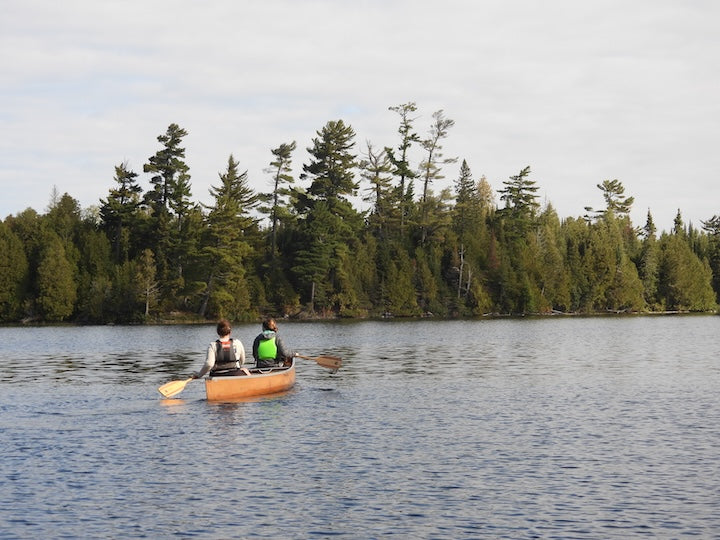
The hungry floater’s guide to snacking on the water
Keeping snacks dry while canoeing or kayaking is easier than you might think..
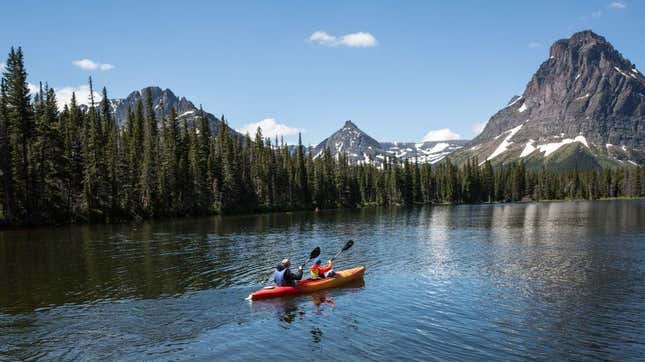
I have a rare condition known as River Rat Syndrome. It typically flares up in late June, causing my toes to prune, my hair to sweep itself into a tangled ponytail, and my feet to slide into the Chaco sandals I purchased from the Bass Pro kids’ section in 2014. During a River Rat episode, I have 24 hours to get myself to a river and into a kayak or I could die. It’s very serious.
Floating is my favorite way to spend a hot summer day, but I know that snacking on the water can be a pain if you’re not prepared. Sandwiches can get soggy, hands can get sticky, and blood sugar levels can drop, turning a perfectly lovely float into a buoyant hellscape. Fortunately, I’ve perfected the art of yakkin’ and snackin’. Here are my tips, gleaned from years of falling out of small watercraft.
Sliced bread is your enemy
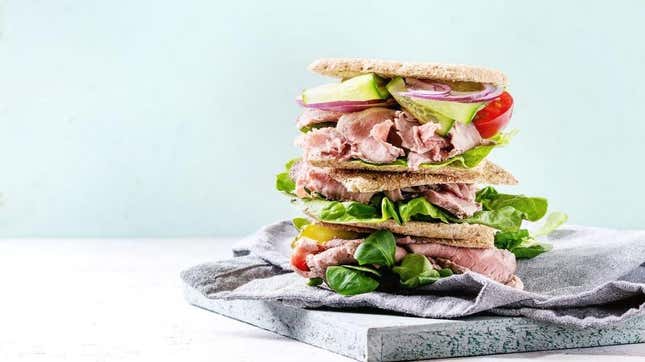
Ah, a classic turkey sandwich! An excellent river lunch, right? Wrong!
Real river rats know that sliced sandwich bread can shift mid-float, destroying your carefully arranged sandwich structure and causing a huge mess. By the time you reach into your Ziploc bag and attempt to eat the thing, you’ve got meat falling out of every side, hot mustard gushing onto your straw cowboy hat, and crumbs trickling down your bikini top. It’s a disaster.
Trust me here: skip the sliced bread and go with a wrap or pita sandwich during your float. A wrap can do everything sliced bread can do, but it creates a more stable sandwich experience, ensuring your sandwich fixings stay put, even as you rock the proverbial boat. You can also eat a wrap one-handed, which means you can use your other hand to slather on some sunscreen or pick your wet shorts out of your butt. For the perfect float trip wrap, I recommend opting for peanut butter and jelly or hummus and veggies. Sliced deli meats might not look so good after you’ve been on the river for eight hours.
Embrace nature’s Ziploc bag
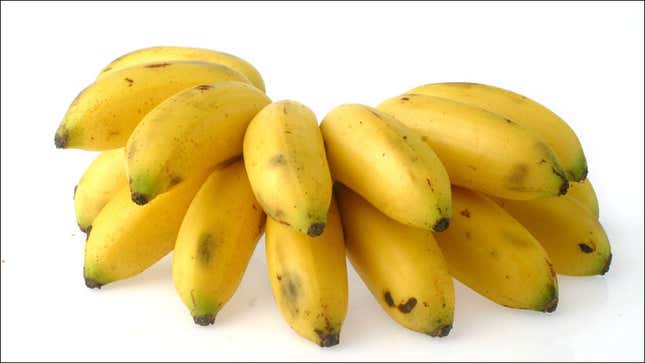
Leave no trace. It’s a key principle for outdoor adventurers everywhere, and it’s especially important when you’re visiting a vulnerable waterway.
Opting for fruits and veggies is a great way to cut down on float trip garbage; plus, if your refuse accidentally goes overboard, natural materials like banana peels are totally biodegradable. If you’re packing fruit, skip sticky, hard-to-peel options like oranges. I tend to go for apples and bananas. (I’m especially fond of the latter because they comes with their own packaging. Nature’s Ziploc bag, if you will.) You can also load up on protein-rich hard-boiled eggs, which can be left in the shell for extra protection until you’re ready to dig in. I say this without a hint of sarcasm: slurping down a few eggs on a scenic waterway is very satisfying.
Keep your energy up
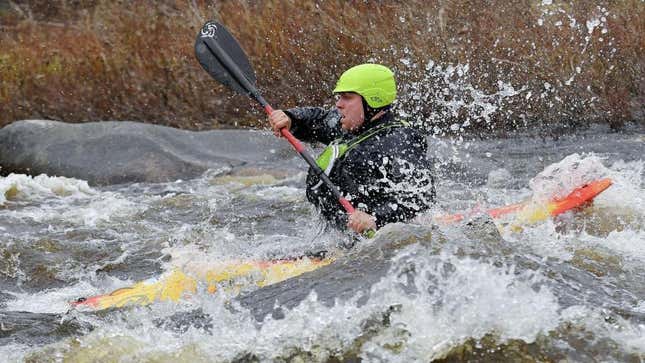
Attempting to complete a six-hour float with nothing but PBR and Fritos? That’s a marriage ruiner, folks. Even on an easy river, paddling can torch a lot of calories. Keep your spirits high by fueling yourself with a mix of proteins, carbs, and fat every two to three hours. I do this by dividing my float lunch (usually a wrap, a piece of fruit, some nuts, and an individually-packaged piece of candy like an Airhead) into two. Eat one half a few hours into your float, save the other half for later, and bring more snacks than you think you’ll need.
Know your cooler’s limits
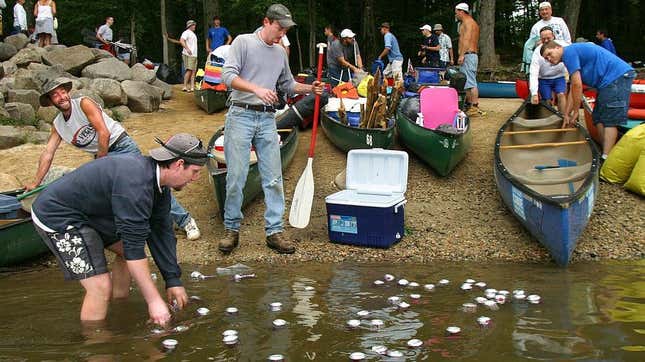
Overfilling your cooler is a recipe for a bad time. Too much ice, a surplus of beers, or an uneven fill can weigh down your canoe or kayak and contribute to tipping—and a canoe tip can send your beloved brews sailing downriver, along with your sunscreen, wallet, and dignity. For best results, stick with a small, soft-sided cooler and no more than two to three beers per person. (This will ensure relative sobriety, which is a plus if you’re operating a river vessel of any size.) Soft-sided coolers also usually come with a strap, which you can anchor to your boat or your person to protect the goods.
A tip on river boozing: avoid beer bottles of any kind, even if they’re twist-offs. Twist-offs are gonna be a lot harder to open with wet hands, and glass bottles can pose a safety hazard. Stick to cans.
Skip the stickies and sours
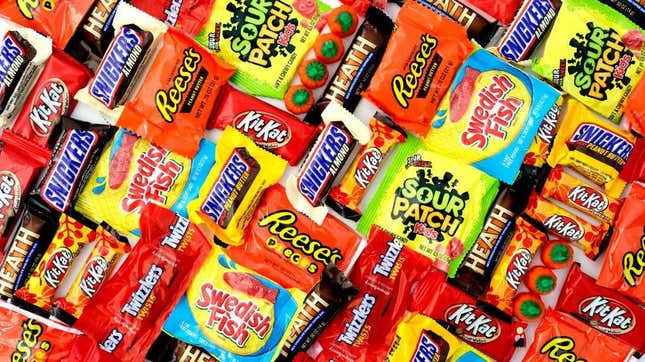
I love eating candy on the river, but chocolate melts and sours make a mess of your hands. I recommend avoiding goodies with annoying textures. Instead, opt for individually packaged treats like gummies or Laffy Taffy. Individual bags of Fruit Gushers also reign supreme—just make sure you pack them at the top of your bag to avoid smushing.
Beware the Wet Chip Paradox
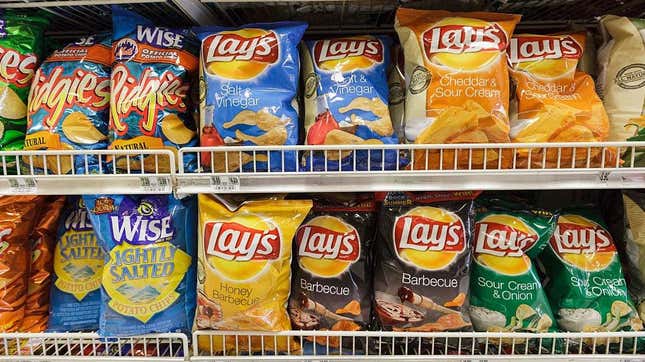
Time and time again, I’ve fallen victim to something I call the Wet Chip Paradox. You want a handful of delicious chips, so you stick your wet hand in the bag—only to dampen the rest of the chips, creating a mushy mess for the rest of your trip. Learn from my mistakes: opt for individual snack bags or, better yet, heartier snacks like nuts or granola bars that can hold up to a little river water. That can of Pringles is going to get wet, but that individual bag of Cool Ranch Doritos will be the envy of the river. Just be sure to bring a waterproof container for your garbage to ensure you don’t leave any trash behind. (See next slide for more info.)
When in doubt, stick it in a bucket
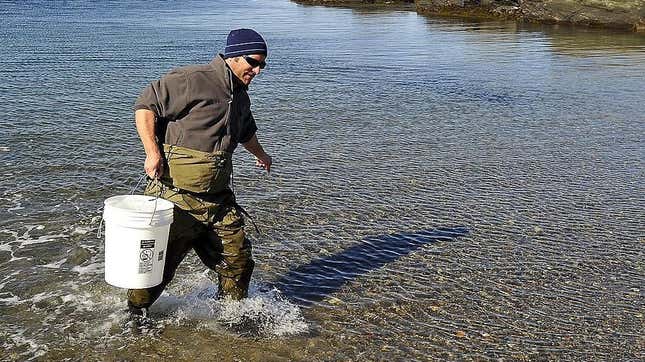
Biodegradable snacks like bananas are great on the river, but you’re going to want to seal everything else in Ziploc bags (and maybe even double-bag if you’re worried about rough water). But where do the Ziploc bags go? If you’re a frequent floater, I recommend a dry bag with buckles at the top . You can grab these at any outdoor retailer, and they’re a great all-purpose destination for your snacks, phone, camera, and keys. But if you’re just going out once or twice this summer, you can opt for a cheap three or five-gallon bucket, readily available from your local pizza parlor or bakery. Give it a good rinse before you load it up, and use it as a storage bucket and trash receptacle on your trip. Plus, it floats.

- Our Featured Outfitters
- MO Float Trip Rules & Laws: A Guide
- What to Bring
- Missouri Float Trips by River
- Missouri Float Trips by Area
- Find an Outfitter Close to You
- Be a FloatMissouri Writer
- FloatMissouri Premium Sponsorship Opportunity
- Partner With Float Missouri
- Float Trip Meetup Group
- Advertise on Our Facebook Page
- Outfitter Newsletter
- Get Your Free Business Listing
Easy Drinks to Make on a Float Trip

For those floaters that like to have a cocktail hour while on a float trip there are many options to choose from. Any type of juice that is in a single serving bottle is a great base as a mixer for alcohol. For those that like gin, rum or vodka in their cocktails, just pick your favorite type of juice or juice cocktail as the mixer. Before adding your favorite type of alcohol all one has to do is drink about and ounce or two of the juice first or the alcohol will not fit in the bottle. Once that is accomplished pour in your preferred alcohol, put the top on the bottle and shake. Instant cocktail without the need of a bartender and the best part, you do not have to leave a tip.
One way to have a stocked bar on a float trip is to take along the small bottle bottles or also known as “airline bottles”. These individual bottles of alcohol come in a vast variety of spirits and usually hold an ounce to two ounces of alcohol. Airline bottles can usually be found at the local liquor store and are generally inexpensive in price. These handy little bottles offer all in the raft or canoe a choice in cocktails.
Making great tasting drinks on a float trip is easy. With a little imagination one make everyone on the float trip his or her favorite drink. Remember when consuming alcohol on the river to drink responsibly . Following this basic rule can prevent many accidents on the river and ensure that everyone has a great time.
Author: Will Hanke
Will Hanke is a float trip fanatic and an Amazon bestselling author. He owns Red Canoe Media , an Internet marketing agency south of St. Louis. When he's not geeking out, he's probably on the river in, yes, a red canoe.
Related Posts

When mixing drinks on the river, you need to make sure to buy PLASTIC bottles. Absolutely no glass allowed on the river!
Leave a Reply
Your email address will not be published. Required fields are marked *
Notify me of followup comments via e-mail
Save my name, email, and website in this browser for the next time I comment.
Post comment

IMAGES
COMMENTS
Get the recipe. 5. One-Pot Pesto Pasta. Source: Pexels. Whether you plan to be out on the water alone or you are making a group or family hang out of it, pesto pasta is one of the best float trip food ideas to keep you full, happy, and satisfied. To save yourself some cooking time, make the pesto beforehand.
Float Trip Food Ideas. Don't forget to add float trip snacks to your float trip list! Here are some snacks for floating the river: Granola bars; Trail mix; Homemade sandwiches; Pringles (since they are in a hard container and can't get squished) Fruit (apples, oranges, bananas) Cheese & crackers; Nuts; River Float Trip Checklist
These are some of the very best snacks for boating. 5. Trail mix. Trail mix is one of those trusty easy-to-pack and easy-to-eat snacks that always go down well. Not only does trail mix offer a variety of items, it is also very filling for its size. Which is exactly the sort of great boat snacks that everyone needs. 6.
Here are simple ideas you can use as a springboard for what to eat during during your float trip. Summer Sausage Sandwich; This classic food can be great for breakfast, lunch, or dinner. It can be eaten whether you're floating on a raft boat or chilling by the side of the river. Float trips are instantly awesome when you have good on the go.
Find out how to plan a delicious and nutritious menu for your next float trip. Get tips on pre-packaged snacks, protein-rich foods, fresh fruits and veggies, sandwiches, wraps and pasta dishes.
Find out how to make breakfast sandwiches, cinnamon buns, oatmeal, burritos, hummus bowls and more on your next canoe trip. These recipes are easy, delicious and backcountry-adapted for your outdoor adventure.
Those that are new to float trips are not sure exactly what kind of foods are float trip friendly. Here are some great suggestions and tips to keep paddlers from abandoning ship when the hunger pains start to hit. Fruits and vegetables are great foods to take on the river. Apples, peaches, grapes, carrots, celery, cherry tomatoes and bananas ...
Shown below is an actual grub list we used on a 3-person, 7-night float trip in Western Alaska last summer. We travelled on the airlines with the food packed in plastic totes, then we transferred the goods to dry bags for the trip. All the fresh meat products were frozen ahead of time and were packaged in vacuum-sealed pouches.
Here are some canoe trip meal ideas that are dairy-free or lactose-free. Oatmeal, dried fruit, and nuts (great breakfast option) Hummus and veggie wraps; Hotdogs; Pasta with tomato sauce; Beef stir-fry or fajitas (for the first day of camping) Suggested Canoe Camping Recipe. Below is one of my favourite canoe trip recipes that makes a great ...
Trail mix, jerky, energy bars, fresh fruit, sandwiches or wraps, cheese and crackers are all excellent options. Remember to also pack enough water to stay hydrated throughout your trip. By planning and packing the right snacks, you can ensure a fun and enjoyable float trip experience. You may want to see also.
Eggs on a Raft - This recipe requires bread, butter, salt, pepper, eggs, and a frying pan. You will take a slice of bread and cut a circle about two inches in diameter. Toast the bread slowly and lightly on both sides, using a fork or a stick shaped like a fork if needed. In your frying pan, melt a hunk of butter and put the toast in the pan ...
Side Dishes for Canoe and Kayak Lunches. Fruits: Apples hold up extremely well in a pack and taste fantastic at lunch. They supply a crunch often missing from camping food. Veggies: Carrots and celery both hold up well in a back, and you can dip the celery into a plastic tub of peanut butter with little mess. Trail mix.
River Trip Breakfast. As mentioned before, breakfast is easiest when it's DIY. But if you want to do a group breakfast or people are looking for ideas, this meal plan will accommodate many eating preferences and eliminates cooking if you want to avoid a morning dish-washing session. Hard-boiled eggs (cooked pre-trip, stored in cooler)
Float Trip Essentials: Pick your day, Saturday day trips in the summer are best. You must call and reserve your boats ahead of time with an outfitter. Canoes hold 2 people, rafts hold multiple, and kayaks typically hold 1, so plan your numbers accordingly. You don't want anyone getting stuck floating alone.
11. Water guns. Great for kids and adults alike, water guns are a fun way to keep the float trip lively. Depending on your location and the flow of the river that day, you might be floating for a while and need to break up chats with a brief water gun fight. 12. Hand sanitizer.
What to Bring on a Float Trip Float Trip Gear 1. Your Vessel of Choice (This can be an inner tube, raft, canoe or kayak. Don't forget an air pump if necessary.)2. Tube Repair Kit3. Dry Bag4. Bungee Cords5. Ziplock Bags6. Umbrella7. Towel8. Waterproof Cell Phone Case or Floating Phone Case Float Trip Safety 9. Sunscreen10. Chapstick11. First ...
For light sweaters, 0.5-1 liter of water per hour is a good estimate, whereas heavy sweaters can lose up to 2 liters of water per hour. You also need to eat foods with salt to stay hydrated. You can lose 100-4000 mg of sodium (salt) per hour, depending on how much you are sweating and how salty your sweat is.
3. Cooler Tube. Half the fun of a successful river float trip is the cold drinks and snacks! A tube like this with a built-in spot for a cooler makes it a breeze to throw all of your food and drink supplies in one spot. You can then simply strap the cooler tube to your tube and float with all the comforts of home! 4.
Get in touch with our friendly Customer Service team today: 715-755-3405 • [email protected]. More for you…. 8-minute read By Sharon Brodin A multi-day canoe trip is a unique wilderness experience that, like backpacking, means you pack your food wherever you go.
Sandwiches can get soggy, hands can get sticky, and blood sugar levels can drop, turning a perfectly lovely float into a buoyant hellscape. Fortunately, I've perfected the art of yakkin' and snackin'. Here are my tips, gleaned from years of falling out of small watercraft. Keeping snacks dry while canoeing or kayaking is easier than you ...
May 27, 2020 - Explore Amy Collins's board "float trip food & fun ;)", followed by 288 people on Pinterest. See more ideas about food, float trip food, recipes.
Enhance your float trip experience with these mouthwatering food ideas. Discover recipes and tips to make your outdoor dining unforgettable.
Bottled water is a common site on many float trips. The only problem with water is that it starts to become boring on the taste buds after awhile. One way to perk up the boring water bottle is to add one of the many drink mixes that are premeasured just for water bottles. These little packets come in a variety of flavors such as lemonade, peach ...